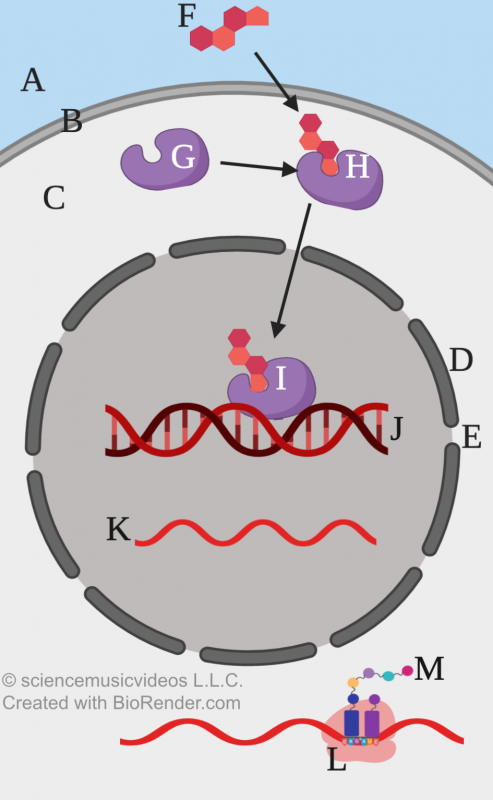Introduction
Every week during the school year, I send an email to teachers who are using sciencemusicvideos.com. If you want to be on my mailing list, please sign up for a free trial license for sciencemusicvideos. If you want to learn more about sciencemusicvideos.com first, then click here.
Useful Links
- AP Biology curriculum on sciencemusicvideos.com or learn-biology.com
- AP Bio calendar/scope and sequence
- My Weekly Agenda (weekly lesson plans)
- Guide to distance learning on sciecemusicvideos.com or learn-biology.com (how to set up your account, invite your students, etc.)
Table of Contents
- Email 1 (sent 8/9/20). Be sure to read the section below that says “Important: every week for me is (probably) two weeks for you.”
- Email 2 (sent 8/16/20): Properties of water; Standard Error; Biology Learning Journal
- Email 3 (sent 8/23/20): Starting Biochemistry
- Email 4 (sent 8/30/20): Proteins and Nucleic Acids
- Email 5 (sent on 9/5/20): The MICE method for online teaching
- Email 6 (sent on 9/13/20): Cell Structure and Function
- Email 7 (sent on 9/20/20): Cell Membrane Structure
- Email 8 (sent on 9/27/20): Cell Membrane Transport; Osmosis; More about the biology learning journal
- Email 9 (sent on 10/3/20): Enzymes
- Email 10 (sent on 10/11/20): Cellular Respiration
- Email 11 (sent on 10/18/20): Respiration, Conclusion
- Email 12 (sent on 10/25/20): Introducing Photosynthesis
- Email 13 (sent on 11/2/20): The Calvin Cycle, and Planning for Unit 4
- Email 14 (sent on 11/8/20): Cell communication; Unit 6 before Unit 5!
- Email 15 (sent on 11/15/20): Cell cycle regulation and Feedback
- Email 16 (sent on 11/22/20): DNA Structure and Replication
- Email 17 (sent on 12/6.20): Transcription and Translation
- Email 18 (sent on 12/12/20): Viruses, Bacterial Genetics, and Operons
- Email 19 (sent on 01/03/21): Genetic Engineering
- Email 20 (sent on 01/10/21): Eukaryotic Gene Regulation and Animal Development
- Email 21 (sent on 01/17/21): Meiosis
- Email 22 (sent on 01/24/21): Genetics
- Email 23 (sent on 01/31/21): AP Bio Exam Review Strategies
- Email 24 (sent on 02/7/21): Population Genetics
- Email 25 (sent on 02/14/21): Evidence for Evolution
- Email 26 (sent on 02/21/21): Speciation and extinction
- Email 27 (sent on 02/28/21): Phylogenetics and Classification
- Email 28 (sent on 3/7/21: Information about the Biomania AP Bio App
- Email 29 (sent on 03/14/21): Origin of Life
- Email 30 (sent on 3/21/21): Animal Behavior
- Email 31 (sent on 3/28/21): Ecosystems
- Email 32 (sent on 4/3/21): Population and Community Ecology
- Email 33 (sent on 4/10/21): Ecosystem Disruption
- Email 34 (sent on 4/18/21): Transpiration, AP Exam Review Checklist
- Email 35 (sent on 4/25/21): AP Bio Reader Panel
Email 1, Sent on 8/9/20
Here’s my first weekly planning email for 2020-21. My goal is to help you use the interactive tutorials and other learning aids on sciencemusicvideos.com (and whatever else I can offer) to help you plan your upcoming week. I’ll try to send these about a week ahead of time. What’s below focuses on what’s going to be my first week of instruction, which starts on August 17. If you’re ahead of me (and already teaching) I hope that this is still useful. Please feel free to email me for ideas, support, etc. We can also talk one-to-one. Please use this link to find a time that works for both of us, and I’ll send you a Zoom invitation.
Important: Every week for me is (probably) two weeks for you
I wish this weren’t the case, but my District has decided on a teaching calendar that is probably different from yours. Our year has been organized into terms that last for 4 or 5 weeks. After teaching content for one term, I’ll repeat that same content with another group of students. Specifically, I’m teaching two of my classes for the next 4 weeks, starting on 8/17/20 and ending on 9/11/20. Then I’m teaching that same content to my 3rd class between 9/14/20 and ending 10/9/20. Then, on 10/12/20, I go back to my first two classes for another 4 or 5 weeks, alternating back and forth until the end of the year.
The long and short is that instead of teaching AP Bio over the course of the next 35 weeks, I’m only going to have contact with my students for about 17 weeks.
In terms of me modeling how to use sciencemusicvideos.com to teach AP Biology this year, this has a couple of consequences.
- Every week of instruction in my weekly plan and weekly agenda is really two weeks of instruction. If you’re on a regular calendar where you meet with your students every week throughout the year, you can take two weeks to do what I have to do in one week.
- My curriculum is going to be very lean. Even though my students will have to manage only 3 classes at a time (which is the whole point of our calendar), I can only assign them so much work. A lot of things that I would have done, I’m going to have to strip out. You can use this spreadsheet to see some of those other activities, and I’ll talk more about them at the end of this email.
How I’m organizing my electronic world for my students (and for you)
The Weekly Agenda
My weekly agenda is my most important means of communicating to my students about what we’re doing in class, and what’s due for homework. It’s also available to parents, administrators, etc. Note that while my yearly calendar is a big challenge, my weekly schedule is very generous. I get to be in contact (via Zoom) with my students for 7 hours/week. These extra periods are described as “labs.”
My students will have access to the Agenda as a Google doc which I’ll share with them. I’ll also post it as a resource in my Google Classroom (which is how I’ll deliver assignments, handouts, etc.). And it’s linked on my website (for you) on the “Teacher” page. Here’s a direct link to it, but I suggest that you read what’s below before digging into it.
A weekly Google Slide Presentation
When I’m doing Zoom meetings with my students, this is how I’m going to organize the presentation. As you’ll see, it’s going to require some modification for you to use with your students. And my guess is that I’ll be changing it a lot as I get a sense of what works and what doesn’t.
I’ll share this presentation with my students, parents, administrators, etc. Here’s a link to the slideshow for week 1.
Almost everything else is in Google Classroom
As I said above, I’m providing my students with materials via Google Classroom. I’m pretty sure that I can only share my Classroom within my District (but if I can open it up to you, I will).
My First Week
Day 1
It’s day 1. My goals are to
- Connect with my students.
- Inspire them for the journey ahead.
- Let them know enough about how things work in my class so that they can do their first assignment on sciencemusicvideos.com.
In the slideshow, you can see this in my first couple of slides. I’m going to try to communicate how much I love biology and how cool it is. I actually (in the past), have had my students do a class cheer that goes
“B-I-O-L-O-G-Y: That’s our classes Battle Cry!” I don’t know if that’s going to work on Zoom, but that’s the energy I’m trying to bring.
Then I talk about me: a little bit about my life story. I’m just trying for a bit of personalization.
Next, I put on my motivational speaker hat. Just like us, our students are facing an unbelievable challenge. I’m going to try to inspire them every step of the way, and day 1 is the time to start. Note that while I mention the pandemic and SARS-Cov-2, I’m going to save teaching about the virus for later (maybe next week). I just didn’t want to do it during the first few days. The one slide about the pandemic enables me to mention the virus (and assure students that I will be teaching about it), without going into the details.
Then I briefly introduce Biology’s 4 big ideas. This framework receded into the background a bit when the College Board redesigned the curriculum in 2019, but I still find it to be a very useful thematic scaffold. Again, most of what I’m communicating here is how mind-blowingly cool biology is.
Finally, I get my students onto sciencemusicvideos.com for their first assignment: the Biology Core Concepts module. This module is like the first chapter in almost any biology textbook. It lays down a conceptual framework for all the biology that’s going to come. It’s also very easy material, and I wanted to pair easy content with a new use of technology (sciencemusicvideos.com) for my students.
I haven’t ever had to get students registered onto sciencemusicvideos.com without being there in the room with them. I’ve added a couple of slides to guide them through the process. Because I’m distributing my student learning guides through Google Classroom, I also have to register them for Classroom. It’s gonna be quite a day…
Day 2
I’ll start with a general check in. Knowing my BHS students, they are probably going to ask me about grades. Unless I have some huge epiphany between now and a week from now, I’m going to have to answer very vaguely. I don’t have my head around assessment in this new online-only world. So I’ll start with grades being mostly about quality of work on assignments. I’m sure I’ll be talking about this with my BHS colleagues (and, hopefully, with you) throughout the year.
After that, I’m going to have my students work in breakout groups to consolidate what they learned yesterday in the tutorials about the key themes of biology. I’ve been investigating Google Jamboards as a means of having students collaborate in this type of task. I’ll let you know how it goes.
Then I introduce natural selection. Why now? Because I agree with Dobzhansky: it’s the idea that makes everything else in biology make sense. In my lesson, I’m not lecturing through the content. I’m just laying out some of the big issues, stimulating thinking, etc. I’m going to leave the details to the tutorial about natural selection on sciencemusicvideos.com. It’s called “Thinking Like Darwin,” and it goes with this student learning guide.
Then I’m doing two more personalization activities: 1) “Grill the teacher,” and 2) a short written assignment by each student where they tell me a bit about themselves.
After that, it’s on to sciencemusicvideos.com
Remember that for you, this is probably the fourth day of your first week.
Day 3
I’m going to start with some checking for understanding about artificial and natural selection. Note that we’ll cover natural selection again when we study evolution in unit 7. For now, my goal is for students to be able to explain things like why the shape of an enzyme complements its substrate, why the spike protein of Sars-Cov-2 complements the shape of the ACE receptor, etc.
Once I feel that’s accomplished, I’ll move on to the properties of water. My introduction consists of a few slides showing water’s importance to life, its basic structure (polarity), and hydrogen bonding. Then it’s on to Structure of water and hydrogen bonding on sciencemusicvideos.com. This module has two videos, one of which is a virtual lab about the properties of water. If you’re in the classroom and you can do the actual lab, that’s much better.
Day 4
Here we turn to standard error, which is an important statistical concept in the AP Bio curriculum. Ultimately, students just need to understand how to determine when the difference between two sets of data in an experiment is statistically significant. In most tests of this at the AP level, the answer is “when the error bars don’t overlap.”
In these introductory readings/activities, I’ll take students through the process of actually calculating standard error. In later labs (that we would have done if we were in the classroom together) we’d use a google sheet to combine our data, look at class means, and graph the data with error bars (and let the spreadsheet do all the calculations).
My slideshow seems a little thin here, but that’s because I’m using two handouts.
- This one will introduce your students to standard error and error bars. It consists of explanatory readings, followed by practice problems. I modified this from a handout that was posted in the AP Bio Facebook teacher’s group by Crystal Jenkins Stawiery.
- This one applies what’s learned in the previous handout to MRSA and antibiotic resistance.
I’m allotting two Zoom meetings to doing both of these. The second activity involves measuring zones of inhibition around antibiotic disks (in diagrams, not the real thing). Later in the year I think that I’ll be able to make sure that every student has a metric ruler to complete an activity like this. But this is week one, and I might just give them the data. Their main job will be graphing with error bars.
Day 5
I’m starting biochemistry. The first slides on the slideshow introduce the fact that life is based on carbon (and why). Then I briefly introduce functional groups. And then it’s on to Carbon and Functional Groups on sciencemusicvideos.com. This module is pretty short, and it’s supported by two videos. Use it with this student learning guide.
Over the weekend, I’m going to have my students do an open-ended reflection (see Friday on the agenda). That means that I’m going to need my students to keep some kind of online journal. This is probably going to be something as simple as a Google doc that they share with me, with the most recent journal entries always going on top.
There’s so much more that I wish I was doing.
If my calendar were different (if I had 35 weeks to teach instead of 17), I’d be doing much more. This spreadsheet shows what my plan would have been if I had been in the classroom for that amount of time. Obviously, the in-person labs aren’t doable in an online context. But there’s a lot of other activities that would have worked. If you have time to fit these in, check out the “Peppered moth simulation” and the HHMI Rock Pocket Mouse Evolution activities. I’m hoping that I can figure out how to fit some of these in later in the semester.
Email 2, sent on 8/16/20
Useful Links
- AP Biology curriculum on sciencemusicvideos.com
- AP Bio calendar/scope and sequence
- My Weekly Agenda (weekly lesson plans)
- Google Slideshow for Weeks 1 and 2
- Guide to distance learning on sciecemusicvideos.com (how to set up your account, invite your students, etc.)
- Your sciencemusicvideos teacher portal: qwizcards.com/login
My first day of teaching is tomorrow, August 17. I’m pretty confident that I have a good plan for day 1 and the first week. Whether you’re in the classroom or online, the things I’d encourage you to focus on are connection and direction.
- Share enough about yourself to let your students know that you’ll be their enthusiastic, competent guide for the difficult journey ahead.
- Let your students know how much you love biology, and how much they’ll gain from this journey.
- Let them know that you’ll be flexible and responsive to their needs.
- Get them started on some work.
If you want to see how I’m going to try to do this with my students, take a look at the slideshow I’ll be using while I’m on Zoom. Remember that if you’re teaching online (but also if you’re in the room with your students) super-clear directions about everything are extremely important.
Please be kind to yourself. In this new world of distance learning, or hybrid schedules, or whatever situation you’re faced with, things that are beyond our control and outside of our comfort zone are going to happen. Just do your best. It’s a pandemic. That’s all anybody can ask of you.
A Plan for Week 2
Just a reminder: one week of instruction for me is probably two weeks for you. So, If you’re following this sequence, here’s a couple of ideas for week 2. If you want to see more about week 1, look at last week’s email, or go to my planning email archive.
In terms of AP Bio topic 1.1 (properties of water), sciencemusicvideos.com has a lot of resources to support you. This video about water and hydrogen bonding explains all the chemistry. This video shows how hydrogen bonding affects water’s physical and chemical properties. On the same pages where you’ll find the videos, there are also interactive tutorials that will lead your students to mastery of this material. Deeper mastery will come if you also have your students complete this student learning guide, which walks them through through the tutorials.
If you’re in the room with your students, you can do this Properties of water lab. which is a qualitative lab comparing water with a much less polar substance, isopropyl alcohol.
After you do the qualitative lab about water, you can follow it with a quantitative lab about the properties of water. This lab was originally posted by Crystal Jenkins Stawiery on the AP Bio Teachers Facebook group (which has tons of great resources). The purpose of this lab is to use some lab data (again, a comparison of water and isopropyl alcohol) to enable students to understand the concept of standard error and how error bars work. You can work through the the first part of the handout (which teaches about standard error) even if you can’t do the lab.
Ultimately, what you’re trying to get your students to understand is the idea of statistically significant differences between sets of data. This table (which is in the lab handout) says it all:

Teaching this material depends on your context.
- If you’re in the room with your students, read the handout, work through the practice problems, and then do the lab.
- If you’re teaching completely online, then use this version of the handout (which drops out the lab portion, and just teaches standard error).
Note that both versions of the lab have solutions to the sample problems on the last page (which you might or might not want to delete before you share the handout with your students.
The next lesson about standard error involves a case study from the National Center for Case Study Teaching in Science. I have a slightly modified version of this handout (I dropped out the last section). The original one is here (and I highly recommend subscribing to the NCCSTS). The first section of this handout is a simulated lab activity where students measure the zone of inhibition generated by growing a variety of bacterial strains (one of which is MRSA) in the presence of one of four antibiotics. The second part talks about how antibiotics work.
If you’re in the classroom, the lab pretty much runs itself. The only equipment you need is a class set of metric rulers. If you are 100% online, you might have to give your students the data. I haven’t figured out how I’m going to share this data with my students, but you can access the data through this Google spreadsheet. In my Google slideshow, there’s a graph of this data on about slide 74 (the slide number may change as I adjust the slideshow throughout the week). Also note that the graph is not great (and that statistics is not my greatest strength as a teacher).
In my compressed calendar, I’m going to end the first week by moving on to biochemistry, starting with Carbon and Functional groups. That’s a good way for you to consider ending your second week. You’ll find pretty much everything you need to teach this topic in this sciencemusicvideos module, which includes videos and interactive tutorials.
The College Board won’t explicitly test your students about which functional group is which. However, your students will be expected to understand how proteins fold into their specific shapes. This is impossible to understand without knowing that some functional groups are polar, others are nonpolar, while others are acidic or basic. My experience is that it’s much easier to teach about proteins if you can say things like: “you see this carbonyl group? Remember how it’s polar, with a partial negative charge. When it comes into close contact with this hydroxyl, over here, the two will form a hydrogen bond. When you have dozens of these, if can lead this shape to emerge…” It’s worth it to lay down a foundation now. Functional groups will also come in handy when you’re talking about DNA, membranes, phosphorylation cascades, etc.
A Biology Learning Journal
I’m still in the process of putting this together, so please note that what I write here might get adjusted as the next few weeks and months unfold. But I’ve been thinking that I want my students to have some forum for writing beyond what they’ll do on their student learning guides. I’ve always been a believer in writing for learning, and I want some place where students can do ongoing reflections on their learning, and build understanding over time. On top of that, I’m anticipating that the start of a Zoom class might be a bit messy. You have to admit students one by one, and that’s going to take a bit of time. For about as long as I’ve been a teacher, I’ve always wanted students to have something to do when the come into the room. I want that to happen my virtual classroom, too.
To do all of that, I’m going to experiment with having my students keep an online Biology learning journal. It’s just a google doc, but I’ve organized it as a template where students can do some writing as they enter the room. I call that a daily bit of writing a daily Catalyst. In addition, it’s where students can do some reflection or creative science writing at the end of the week.
Here’s a link to the template.
The major sections are
- Author introduction: a way for a student to introduce themselves to me and their peers
- Showcase: a piece of writing that they want to show off, bring to my and others’ attention, etc.
- Weekly work, consisting of
- Daily catalysts: a short piece of review writing that students will do as they start the zoom session.
- Weekly reflection. This might be a response to something as general as “Write a paragraph or two explaining to your parents/guardians the three most important things you learned in class.” Or they might be more specific.
I’ll try to have more to say about it at our next webinar, on Thursday night.
Join the next sciencemusicvideos AP Bio Planning Webinar: Thursday, 8/ 20/20, 5pm PST
We held our first weekly planning webinar last Thursday, and I plan to keep on doing these every week. I’ll go over the weekly plan outlined above, and answer any questions. In addition, it’s a great chance to get to talk to and hear from other AP Bio teachers who are also using sciencemusicvideos.com.
Note from Mr. W: use the contact link to get an invitation to our webinars.
My Teacher Anxiety Dream, and My Hopes for You
For years, I’ve had a dream the night before school starts. I’m in bed, under the covers, undressed. Students are all over the room: sitting on my dresser, on the bookshelf, on the little niche we have above our closet. They’re waiting for me to start teaching…but I can’t get out of bed, because I’m undressed.
What we do in the classroom is so difficult. We’re exposed. I first taught in 1987. I still feel nervous on the first day. We’re just one person, and we have to hold the attention and set the agenda for dozens of teenagers. It’s not easy. Whenever you start, I wish for you the strength to hold the space.
Email 3, sent on 08/23/20
Useful Links
- AP Biology curriculum on sciencemusicvideos.com
- AP Bio calendar/scope and sequence
- My Weekly Agenda (weekly lesson plans)
- My google Slideshows:
- Slideshow 1: (Core concepts, Properties of Water, Standard Error)
- Slideshow 2 (Biochemistry: Carbs, Lipids, Proteins, and Nucleic Acids)
- Guide to distance learning on sciencemusicvideos.com (how to set up your account, invite your students, etc.)
I hope that you’re doing well.
Here in the Bay Area, the environment is pretty challenging. As if a pandemic weren’t enough, we have dozens of raging wildfires that were ignited by dry thunderstorms last weekend. Nothing’s burning in my immediate area, but smoke from more distant fires has pushed the air quality to unhealthy levels. We might have more of these thunderstorms tonight…I keep telling myself that I’m lucky. I have a roof over my head. Our house is safe, and I even can ride an old stationary bike that we bought 25 years ago when my son was a toddler. But it’s hard not to be able to go outside.
Despite that, my first week of teaching went well. I feel like even though I’m 100% online, I’m starting to get to know my students. The kind of classroom banter and small talk that’s a big part of how we build relationships in the classroom is mostly gone — you can do it a little bit as students enter your Zoom classroom. But I’m hoping that over time, I’ll be able to connect more and more. Additionally, as I noted last Spring, there’s a lot of good teaching practices, particularly checking for understanding, that you can do over Zoom. For example, if your students are looking at a numbered diagram, you can have them raise fingers in response to a question. Or they can put their responses in the chat. And one of my go to techniques, which is asking a question, followed by wait time (3 – 5 seconds), followed by randomly calling on a student to answer, works well.
Group work is also very doable in an online context. I’m becoming much more comfortable putting students into breakout rooms, and I make a point to do random drop-ins, just as I would listen in if I’d assigned my students to work in pairs or in groups of four in my classroom. I’m trying to some group work every day during our synchronous class meeting time. My students are isolated at home. Being in a breakout room is a way to recreate at least a smidgen of the social interaction that students are missing because of the pandemic.
Because of my high school’s calendar (you can read the details here if you’re interested), I’m covering a lot of material very quickly. I’m not sure if that’s sustainable, but a very high percentage of my students (over 90%) completed the three sciencemusicvideos.com modules that I assigned last week. I’m not sure how much time they’re working out of class. I’m planning on surveying them about the amount of homework they’re doing next week, and I’ll share the results.
Here comes biochemistry
We actually started biochemistry last week. I had my students do the sciencemusicvideos.com tutorials about Carbon and Functional groups for homework on Friday. Checking my sciencemusicvideos.com teacher portal (at qwizcards.com/login), I can see that about 40% of my students have completed it (it’s not due until tomorrow). I’m hoping that number is higher by 8 am tomorrow!
You can see how I’ll get through biochemistry by looking at my Weekly Agenda for week 2 and my Google slideshow. Both take my students completely through Unit 1, but I’m only going to talk about the first half of the week, since that corresponds to what you’ll probably be doing with your students during your 3rd week of instruction (the link goes to my scope and sequence spreadsheet).
On Monday, after a brief check-in about the weekend, I’m going to do a little more evolutionary biology with my students. We’re going to watch the 11 minute “Rock Pocket Mouse” video, a fantastic example of natural selection, and then students are going to work in groups to complete this worksheet (designed by my BHS colleague Sydney Aardal). Why? I want my students to have a bit more natural selection under their belts before we dive into the molecules of life. It’ll be worth it when we’re discussing COVID-19, or enzymes, or sickle cell anemia (later this week).
Then I’ll do some checking for understanding about the weekend’s homework. As I wrote last week, our students don’t need to memorize the functional groups: they just need to know if they make the molecule they’re attached to polar, nonpolar, acidic, or basic. After that, I’ll give my students a brief overview of monomers and polymers and carbohydrates. For homework, I’ll have them do the sciencemusicvideos.com tutorials about both topics (see the previous links).
Tuesday, I’ll do some checking for understanding about carbohydrates. Once I feel that material is secure, I’ll do a brief overview of lipids. Because I’m leaving the deeper acquisition of content to the Lipids Tutorial on sciencemusicvideos.com, my goal is just to motivate and set some context.
Wednesday, it’s the same pattern. I’ll check for understanding about lipids. To see how I’m doing that, you can look at this slide and the following five slides in my google slideshow (but remember that I’m probably going to be adding, deleting and editing slides over the course of the next week, so you might have to look around a little bit). Then I’ll introduce proteins. On this first day, my focus will be on big picture issues (the multiple roles played by proteins in living things), followed by amino acid structure and peptide bonds.
In the slideshow and the weekly agenda, you’ll find embedded videos about Monomers and Polymers, The Four Families of Biological Molecules, Carbohydrates, and Proteins (but not lipids: sorry!). If you’re teaching asynchronously with little student contact time, these will help your students a lot.
In next week’s email, I’ll get into the details of teaching about the four levels of protein structure, and write about how I introduce nucleic acids.
If I had more time (and face-to-face contact) here’s what I’d be doing.
Here’s a few recommended biochemistry activities:
- Molecular model building lab. This works best if you have a Molymod kit (or any other brand). But if you’re on a budget, you can probably make it work with marshmallows and paper clips.
- Starch Amylase Lab. This is one of those labs that makes it great to be a biology teacher. Students spit in a test tube filled with starch solution. Salivary amylase hydrolyzes the starch into glucose, which you can test with a test strip, or with Benedict’s reagent. If you can’t stand saliva (or if your school regulations would prohibit it), this lab is not for you. It’s also great for teaching about experimental design and control groups.
- The Biochemistry Basics POGIL. You can buy the POGIL packets from Flinn Scientific.
Email 4, sent on 08/30/20
Even at doubletime, it’s doable
One thing I’ve been worried about this year is whether the pace of work would crush my students (and make them hate biology). My students are taking 3 classes at a time in a very compressed academic calendar (about 90 days and 18 weeks for all of AP Biology). In terms of homework, here’s what they reported to me in a survey I gave them on Friday.
- 15% are spending an hour or less/night doing biology homework.
- About two hours/night: 52%
- About 3 hours/night: 25%
- Over 3 hours: 8.3%
Three hours or more/night is brutal. But the takeaway for you is that if you have the whole year, then most of your students can get by on a bit over an hour/night. That’s not, in my estimation, unreasonable for an AP Biology course. In a follow-up question, only one student rated my class as having an “insane amount of work.” What I would recommend is that you do what I do: use sciencemusicvideos.com as your main supplement for teaching content. Last year, I stopped assigning readings from our textbook. My students all told me that on top of sciencemusicvideos.com, it was redundant (and not a good use of time). From everything I could measure (test scores, AP exam scores), they were right.
This year, what I’m finding is that offloading the direct instruction to sciencemusicvideos.com is freeing me up to check my students’ understanding and fill in the gaps during class meetings. It’s also giving me time to have students work on practice FRQs, do activities from HHMI, do real or virtual labs, etc. It should be the same for you.
Teaching Proteins and Nucleic Acids
Last week, I finished unit 1, completing proteins and nucleic acids. If you’re following this scope and sequence, then this is content that you’ll cover in about your fourth week of instruction. There’s a lot of resources on sciencemusicvideos.com to support you with this material. This includes
- A video about the four levels of protein structure.
- An interactive tutorial about proteins (follows the video on the same page as above).
- A tutorial about nucleic acids.
Remember that this is only an overview of nucleic acids. You’ll touch on DNA and RNA in greater depth when you get to AP Bio unit 6 (DNA and molecular genetics).
I also had my students work in groups to do Flinn’s POGIL on proteins. This is a great worksheet, and it was also a great opportunity for my students to work in groups for an extended period of time. If you’re doing this activity online, just have the students make up an accompanying Google doc where they can write their responses. It’s not perfect (there’s some drawing required that students can only do with difficulty online) but it’s still a great activity.
To help students review the material in Unit 1, I have a set of flashcards and a quiz on this page. I also give my students this review worksheet.
We’re going to give our students some type of assessment about the material in unit 1 on Friday. It might just be a practice test (we’re 100% online, and we’re assuming that any test is, whether we want it or not, going to be a team effort). I’ll let you know how it goes.
Introducing SARS-CoV-2
Now that we’re finishing unit 1, it seemed like a great time for my students to see proteins, nucleic acids, and phospholipids in the context of the novel coronavirus. I’m having them look at two great web pages (one from Scientific American, one from the NY Times), analyze some diagrams, and answer some questions. Here’s the worksheet I put together (it includes the links to the two articles).
Email 5, sent on 09/6/20
In the scope and sequence spreadsheet that I’m using to plan instruction, this week is devoted to teaching about proteins and nucleic acids. That’s a topic that I covered in last week’s email, which you can access above.
In next week’s email, I’ll talk about how to use sciencemusicvideos.com to teach about cells. But if you want to jump ahead, you can see what I’m doing by looking at my weekly agenda (see week 3) and my slideshow for week 3 (remember that I’m only have 90 days to teach my course, so week 3 for me is probably week 6 for you).
This week I want to share …
The MICE Method
I’ve been thinking about how I’m doing teaching using sciencemusicvideos.com. It’s the MICE method:
- M is for Motivation. Before sending my students to learn material on sciencemusicvideos.com, I’m trying to motivate them and set some context. This is where I have to put on a motivational speaker hat, and tell my students how incredibly cool whatever they’re about to learn is. Usually that’s not hard. We’re biology teachers because we love biology, so I just have to dip into that well of fascination that led me to become a biology teacher. For this week’s material, for example, you can set context by talking about the specificity of proteins. Think about how the entire COVD-19 pandemic is based on a mutation that enabled the spike protein on SARS-CoV-2 (a quaternary protein) to bind with the ACE2 receptor on the cells in our respiratory (and other) tissues. Or how a COVID-19 vaccine will work only if it can elicit plasma cells to secrete antibodies that block that same spike protein (or some other essential viral protein).
- I is for interactivity. After motivating my students, I’m sending them to interact with that content through the interactive tutorials on sciencemusicvideos.com. In almost every module on sciencemusicvideos.com, students can learn the necessary content from interacting with the website: no other material is needed. Students do even more interaction through the summarizing, comparing and contrasting, and explaining they’ll do on the student learning guide that comes with each learning module in our curriculum.
- C is for checking for understanding. After my students finish with the tutorials on sciencemusicvideos.com, I spend a lot of time checking for understanding. That can happen in a whole class context, with me asking questions and students responding with short answers in the chat on Zoom, which lets me monitor the extent to which students are understanding. Note that this works much better if you have students send you a private chat, so that they can’t see other students’ answers. Or, I put my students into breakout rooms where they’re quizzing each other, and I’ll drop in to check on their progress. Note that both of these ways of checking for understanding are highly interactive. I think that every time you can substitute active learning for something passive, your students’ level of achievement will increase.
- E is for extension: I’m using online student journaling to get my students to reflect on what they’ve learned, and to go beyond what I’m teaching in class to pursue areas that they’re are interested in. This is very experimental for me, and I’m still figuring it out…If you look at my slideshows and agendas, you can see some of the prompts that I’m giving to my students. I promise to write more about this in a future email.
So far, I think this is working. Doing assessment is still a big mystery. but I’ll share with you an interesting result. We (the BHS AP Bio team) gave our first test on Friday. It was a multiple choice test on biochemistry that we administered through our school’s LMS. We told our students that the test was mostly for us to be able to assess how well online instruction was working. We set the point value of the assessment to be negligible (mine was worth 1 point out of hundreds of points students have accrued so far this year). We asked the students to not collaborate, or use their notes, or the internet. Did they cheat? I hope not! But assuming that they didn’t cheat (a hopeful assumption, I know), their performance was almost exactly the same as last year (when I was a face-to-face teacher). I’ll know more as the year progresses.
Email 6, sent on 9/13/20
Teaching Cell Structure and Function
Surface Area and Volume (explaining why cells are small, and many other biological phenomena)
One of my favorite labs in the entire curriculum is the surface area to volume lab that involves phenolphthalein agar cubes. The lab is great, and the concept is one of the richest in all of biology, showing up in adaptations that happen at the organelle, cellular, tissue, organ, and organismal levels of biology. So I felt a bit sad that my students weren’t having the “oh wow” experience that comes from pouring vinegar onto these magenta cubes, slicing them open after a few minutes, and seeing the amount of diffusion and how it varies with the surface area to volume ratio of each cube.
However, I think that I was able to get the idea across by using my video “Surface Area, Volume, and Life” and doing a virtual version of the lab. You can use the video in conjunction with the interactive tutorial that follows (see the previous link), or with this handout (I did both). If you’re 100% online, you can refer to this spreadsheet for data that you can selectively share with your students to help them fill in some of the data in the tables.
If you’re not familiar with the lab, then please watch the video for context. The basic idea is that the rate of diffusion should be constant across all of the cubes. So if you allow the smallest cube (0.5 cm) to completely change color, then you know that it takes X minutes (usually about 5, but it’ll depend on the thickness of your agar) for the vinegar to diffuse 0.25 cm. If that’s constant across all cubes, then you’ll get the data in the spreadsheet that’s linked above.
If you’re in the room with your students, doing the lab, then this is a great chance to collect measured data from multiple groups, work out an average, calculate standard error, and graph the data with error bars. That’s not part of the handout, but since it’s a Google doc, it should be easy enough for you to add that. If you do, let me know how it goes.
Organelles (Cell Parts and their Functions)
Since I’m online, I’m not able to have my students view various types of cells through microscopes. But if you are, then this lab handout might be useful.
When teaching about cells, it can be difficult to to give students a sense of how dynamic cells are. To communicate that, I like to start with this excerpt from Bill Bryson’s A Short History of Nearly Everything (which is a fabulous survey of pretty much all of science: I can’t’ recommend it highly enough).
Following that excerpt I have my students complete the tutorials on sciencemusicvideos about cell structure and function. Much of that material is about connecting organelles with their functions. Other topics, like the endomembrane system and the origins of cell compartmentalization, are more complex. So after my students do the tutorials, I do a lot of careful checking for understanding. That involves interspersing readings from this outline with images and breakout room tasks from this slideshow. If you move through the slideshow, you can get a sense of the flow of the lesson (which usually take about two days).
I’m a huge fan of Nick Lane, a British biochemist who’s written some wonderful books that are squarely aimed at biology lovers like you and me. If you’re wondering about Model 2 on this slide and this page on my website, my original source is Chapter 2 of Nick Lane’s Life Ascending. You might have to save reading that that for your next vacation, but I strongly recommend it. An easier way to access some of the same ideas are the two articles linked on the bottom of the tutorial about cell compartmentalization. This one by Carl Zimmer is completely accessible to any AP Bio student (and I recommended it to my students as optional reading). The second one will require quite a bit of supportive scaffolding if you want your students to read it (but you’ll probably love it!)
Email 7 (sent on 9/20/20): Cell Membrane Structure
Teaching about membranes is simultaneously fun and challenging. The fun is that there are a bunch of labs that usually work (meaning that they yield pretty clean, understandable results). The challenge is that understanding how membranes work requires some molecular imagination on the part of students. That can be difficult without giving students a lot of practice with visual representations of membranes, and that’s precisely where the tutorials on sciencemusicvideos.com can be of help.
If you’ve been following this scope and sequence, then your students should have already covered the structure of phospholipids back in unit 1. Now you can take that to the next level by explaining to students how structures like bilayers and micelles spontaneously form when phospholipids are mixed with water. That’s covered in this tutorial and you can provide further support to your students by using this cells and cell membranes student learning guide (the cell membrane section starts on page 6).
A fun fact for us biology teachers, but probably not for our students at this point, is that the phospholipid bilayer is not the universal basis for cell membranes. It’s what’s found in Bacteria and Eukarya. The cell membranes found in life’s third domain, Archaea, are built from a different lipid. Hang on to that until we get to the end of unit 7 and cover the origin of life.
Once your students understand the phospholipid bilayer, you can move them on to understanding the fluid mosaic model of the cell membrane, and transport across cell membranes.
I have two videos that’ll help you teach this material. There’s my video Membranes: Structure and Function, which covers
- the functions of membranes,
- the structure of phospholipids,
- how phospholipid bilayers form,
- the fluid mosaic model, and
- the roles of membrane proteins, carbohydrates, and cholesterol.
If you want a musical version of the same material, you can use my music video Membranes!
To teach more about selective permeability, you can do the diffusion lab in this handout. Scroll down to the bottom of the second page, and that’s where you’ll find it (entitled “The Diffusion Experiment”). If, like me, you’re 100% online and not in a position to do this as an actual lab, you can use this virtual version of the same lab. If you want a Google doc version of the video webpage, here it is.
If you’ve been following this scope and sequence, then you’re in about week 6 of your course. If that’s so, then you’re finishing up unit 2, which is cells and membranes.
Email 8 (sent on 9/27/20): Cell Membrane Transport, Osmosis
Last week, I wrote about membrane structure. Now we can turn to membrane functions.
You can start with this tutorial on sciencemusicvideos.com. This covers
- simple v. facilitated diffusion
- passive v. active transport
- bulk transport via endocytosis and exocytosis
If you’re making COVID-19 connections, you can talk about how antibodies are released from plasma cells by endocytosis, and how Sars-Cov-2 uses a kind of receptor-mediated endocytosis to to slip into cells.
That leads to osmosis, which I cover through this tutorial and the one that follows. The basic ideas are covered in my music video Osmosis! In previous years I haven’t covered water potential until later in the year, and I’m going to do the same this year. What I’m going to do (in about two weeks) is to distribute broccoli seeds to my students and have them grow them into broccoli plants that are big enough to use for the transpiration lab. This is definitely going to present some logistical difficulties (students need to be able to weigh their plants to determine net water loss), but I think that we’ll be able to pull that off. If we plant the seeds in about two weeks, we should have enough plants ready just before winter break.
I mentioned this last week, but if you’re in the room with some or all of your students, here’s a handout for the AP labs on diffusion and osmosis. If you want virtual versions of the labs that cover most of the same material, use the two following links.
I’m still figuring out Assessment
If you’re curious about how I’m handling the assessment that follows Unit 2, I wish I had a satisfactory answer. Until I have a way to deliver an assessment to my students that’s reliable and secure, it seems like any high stakes test is just an invitation to invite unwanted cheating and collaboration. The interim solution that we’ve arrived at my high school — I’m one member in a team of three AP Bio students — is to make the tests very low takes, and to ask student to take them honestly so that they’re more of an assessment of how well we’re doing than they’re doing. On the last “test,” that means that however many questions were on the test, I made the whole thing worth one point. Test corrections (I use this google doc) are actually worth more than the test.
FYI: My partner, site programmer Dan Kirshner, is working on a way to deliver timed-secure assessments within sciencemusicvideos.com. I’ll be testing this with my students later this week. If that works. we can start to open it up to other teachers. We’ll keep you posted on our progress.
AP Biology Learning Journals
A few weeks ago I wrote about how I wanted my students to start keeping an AP Biology learning journal. These journals aren’t private: they’re google docs that students share with all the rest of my students (over 90) and me. Now that I’m further into the process, I’m finding that this is an experiment that I’m really happy with. So I want to take some time to share a little bit about the why and the how.
Three reasons why your students might benefit from a journal
- Reducing Fragmentation. I’ve felt, for a very long time, that fragmentation is a big enemy of building deep, nuanced understanding. Our entire educational system is fragmented, with math, science, history, and English all in their distinct silos. Within the sciences, articulation of courses can be fragmented, with little connection between what happens between grades and subject areas. And even within our own Biology curriculum, there’s a lot of fragmentation, with all of us leading our students on a careening path from one topic to the next.A journal can give our students a place to slow this down, and to think about how topics and themes interrelate. I’ll talk more about this below but one of my key assignments is weekly reflection. This can be very open-ended, or it can involve a specific prompt. In either case, think about the value of asking a student to consider the importance of what they’re learning. With a journal, you also have the opportunity to allow students to reflect on how their own thinking is developing over time.
- Allowing for open-ended, individual thinking. A journal can provide you with an opportunity to offer your students a chance to think about science in an open-ended way. I don’t know about you, but so much of my course involves teaching students about how to think correctly. That’s a glorious endeavor, and I don’t have any shame about it. But I’ve always felt that I was squandering a big opportunity: that I was getting to teach people who could go far beyond my curriculum, but there wasn’t any space or place for them to do that. Journal writing assignments open things up. Students can get things wrong in a journal (incorrectly using a concept, for example). but there are a practically infinite number of ways to get things right. It allows students to have a lot of choice.
- Writing for peers is better than writing for just a teacher. I’m going a bit out of my sphere of expertise, but if you search for “why writing for peers is better that writing for writing for just a teacher,” you’ll see dozens of articles. When students write for a wider audience, they have much more skin in the game. Students also get to see what other students are writing, which tends to bring up the quality of writing as a whole.
How to set up Journals for your students
Despite my second point above, the journal writing that I’m having my student do is pretty structured. If you’re interested in doing it, here’s how.
- Create a template for your students. The template I made has headings and placeholder for the writing that you’re going to want your students to do. Here are the major items/sections
- A showcase. Each week, I have my students look at other writing that they’ve produced in my class, and paste it in here as a showcase.
- A bit about me (this is an “about the author” section).
- Daily catalysts. There are four of them each week. This is my “Do Now” that I use to start class.
- Weekly reflection: students write one of these each week.
- If you want to use my template, start by making a copy of this:
- I decided not to make this an assignment on Google classroom. That’s because I knew that I would be grading the journals several times throughout the term, and I needed to have a different grade for each assessment. So I worked outside of Google classroom. I had my students make a copy of the template, and then I had them share it with me and with the rest of the class. WHEN YOU SHARE, TURN NOTIFICATIONS OFF. If you don’t every student will get an email notification from every other student. That will lead to a lot of annoyance.
- Build a learning journal main menu. I took an alphabetized list of all my students, and then I linked their name to the URL of their journal. That’s by far the most tedious and time consuming part. I have three classes, each with about 90 students. Each class took me about 1/2 hour. I only had to do it once for the whole year. Here’s a link to a screenshot version of my learning journal main menu (none of the links work. I can’t share the real thing because of student privacy issues)
- Assigning work.
- At the start of each class, I assign a daily Catalyst (that’s my “Do Now”) to start class. You can see these in my weekly slideshows (in the first slide for each day).
- Look at my weekly agenda for the weekly reflection assignment. I’ve generally assigned them on Friday.
- Usually on Tuesday night, I’ve assigned my students to make comments on each other’s journals. You have to model this carefully to make sure that student comments are positive and helpful.
Grading these journals
I look at these journals about every other week. I’ve put together this holistic scoring guide.
Holistic Scoring Guide and Tips for Bi-weekly journal evaluationPlease make sure all assigned writing is present. Every two weeks, you should produce 8 daily catalysts, two showcase entries, and two weekly reflections. If you miss a catalyst because of an excused absence, you don’t need to make it up.
Showcase entries and weekly reflections should be a minimum of 150 words
70% (C): Entries meet minimum length requirements.
80% (B): Entries meet minimum length requirements, are thoughtful and clearly written.
90% (A): Writing exceeds minimum length requirements. Writing is lucid and engaging. Weekly reflection shows significant understanding of applied concepts.
>90% (A+): All of the above. Significant display of creativity, or of taking the initiative to go beyond what’s been taught in class to deepen your understanding of biology (while still retaining a connection to the week’s work).
Note: if you cite an outside source, please put a link to the that source so that other students can explore it, to.
Grading is not trivial: you can probably do it in less than 5 minutes/student, and possibly even three minutes. But it’s not boring or tedious either. Unlike a lot of grading, I find myself feeling interested in what my students are writing and thinking.
Because of student privacy issues, I can’t share links to actual student work here. But I can show some student work at my weekly planning webinar…so think about attending!
Email 9, Sent on 10/4/20
f you’ve been following this scope and sequence, and started when I did (8/17/20), then you’re in about week 8 of your AP Biology course. If that’s so, then you’re finishing up Unit 2, which is cells and membranes. You can use slideshows 3 and 4 above to see how I’ve been presenting this material to my students. In addition,
- This link will take you to the interactive tutorials about membranes on sciencemusicvideos.com.
- This link will take you to our interactive tutorials about energy and enzymes.
I’m a little behind, but I’ve got something special for you
In these emails, I’ve been trying to stay about one week ahead. I’ve also been trying to share with you the slideshow that I use to teach the topic for that week. Next week (for me) is cellular respiration, and this weekend I just couldn’t get there. Probably like you, it’s been hard not to obsessively follow the news about President Trump’s infection with SARS-CoV-2, and the treatment he’s been receiving. So instead of working on that slideshow, I added about a dozen slides to my week 4 slideshow. These slides cover
- The structure of SARS-CoV-2 (in a slightly simplified form that’s appropriate for AP Biology).
- Key features of the life cycle of this virus.
- The three treatments that the President is receiving:
- Remdesivir from Gilead Biosciences.
- A cocktail of two monoclonal antibodies from Regeneron Pharmaceuticals
- The steroid dexamethasone.
The lesson starts with this slide. I’m hoping that it’s going to be a great lesson (because it’s what I’m giving tomorrow!).
Here’s what’s ready for you to start preparing to teach cellular respiration
Start with these overview lecture videos
- Introduction to Cellular Respiration
- Oxidative Phosphorylation
Continue with these interactive tutorials
- ATP (interactive tutorial)
- Cellular Respiration Overview (interactive tutorial)
- Glycolysis (interactive tutorial)
- The Krebs Cycle (interactive tutorial)
- The Electron Transport Chain (interactive tutorial)
- Anaerobic Respiration and Fermentation (interactive tutorial)
Enjoy these music videos!
- Enzymes
- Glycolysis Full Version
- Glycolysis Karaoke
- Krebs Full Version
- Krebs Karaoke
- Electron Transport Chain (Full Version)
- Electron Transport Chain Karaoke)
Watch this lab video about measuring respiration with a respirometer.
Email 10, sent on 10/11/20
If you’ve been following this scope and sequence, then you’re in about week 9 of your AP Biology course.That means it’s time for cellular respiration, one of my favorite topics.
Some Big Picture Ideas about Cellular Respiration
Cellular respiration is exciting to teach because it allows you to make use of pretty much everything you’ve taught in the course so far.
- It (mostly) happens in the mitochondria, an endosymbiotic organelle.
- The whole process is carried out by enzymes.
- The process of ATP production relies on
- cellular compartmentalization (the intermembrane space);
- protein structure (think of ATP synthase as a phenomenal example of a structure/function relationship at the molecular level);
- active transport (protons getting pumped into the intermembrane space), and
- facilitated diffusion (proton diffusion through ATP synthase back to the mitochondrial matrix).
- ATP and ATP synthesis via chemiosmosis is powerful evidence for the unity of life. It’s present in every Domain. Not only that, but the ATP synthase channel that’s used in cellular respiration is a clear homologue for the one used in photosynthesis.
I encourage you to challenge your students to do this kind of connecting. That can be as simple as listing the processes above, and asking students to brainstorm where they show up in the process.
I use this diagram as my touchstone during this unit.
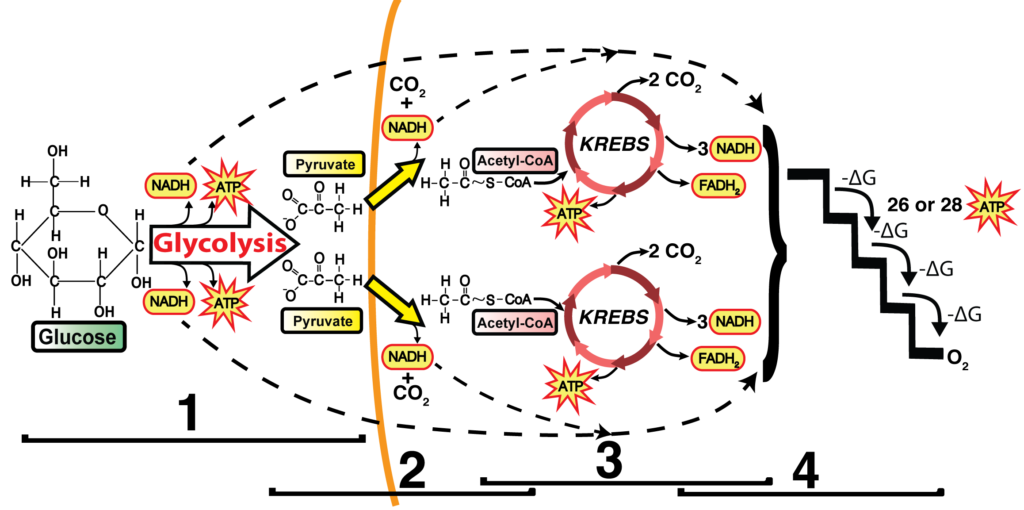
If you’ve been influenced by Understanding by Design, one of my favorite books about curriculum design, then you can think of the goal of the the entire unit as this: students, when presented with this image, can explain the cellular and biochemical processes by which the chemical bond energy in glucose can be converted into ATP. During your unit, as you teach glycolysis, the link reaction, Krebs and the ETC, you can come back to this diagram again and again, and have your students expand the detail with which they explain the process.
It’s really important that students understand that cellular respiration is built upon on two types of sub-processes: REDOX, and phosphorylation. I go to some length to explain both in my Cellular Respiration Overview interactive tutorial, using diagrams like this for REDOX
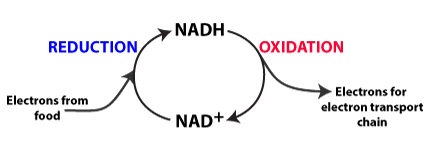
and this for substrate level phosphorylation.
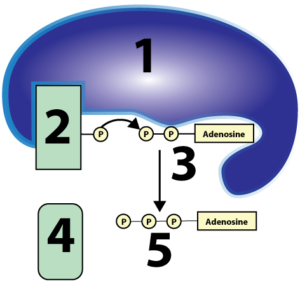
In terms of REDOX, you don’t need to go deeply into the chemistry. It’s enough for students to know that things that are reduced have more energy than things that are oxidized. Where’s the energy? In their electrons. It’s a bit confusing, but that electron energy is usually shown by the presence of a hydrogen. That’s why NADH is the reduced form, and NAD+ is the oxidized form. To give this chemistry some real world context, you can tell your students that peanut butter is reduced. So is bread. So are we. These are all examples of things with lots of chemical energy. By contrast, carbon dioxide is oxidized. So is ash. So is rust. These are all low-energy substances.
Once you’ve built that foundation, then it’s all downhill when you’re teaching about glycolysis (in which the oxidation of glucose is coupled to the reduction of NAD+) or the Krebs cycle. In fact, that’s the way to control the detail so that your students don’t get overwhelmed. What’s happening at 3 in the diagram below? The six carbon compound is oxidized, so that NAD+ can be reduced to NADH. What’s happening at 5? A different enzyme is using the chemical energy in the 4-carbon compound to phosphorylate ADP to ATP.
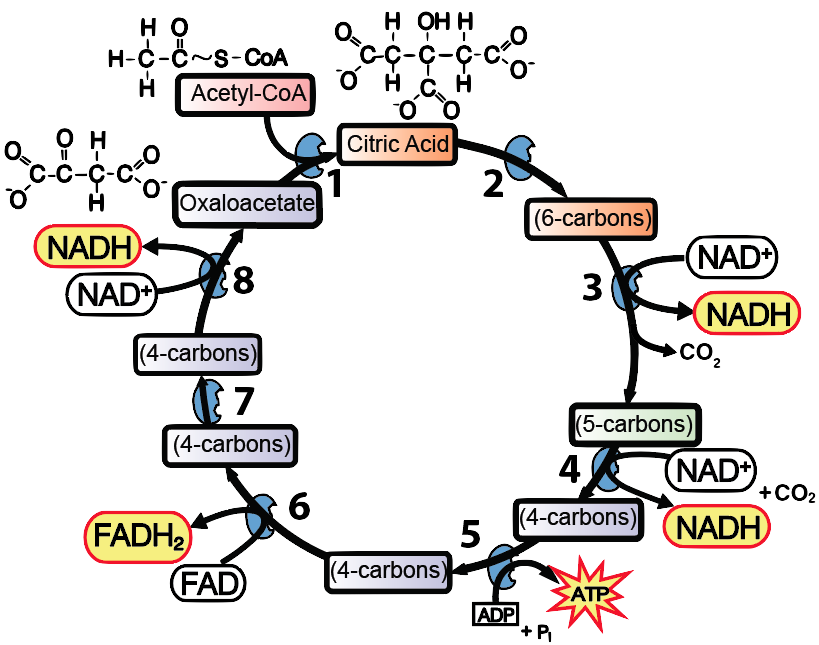
Note that you don’t need to teach any of the intermediates (though they are mentioned in my Kreb Cycle Song). All that our students need to know about is acetyl-CoA, Citric Acid, and oxaloacetate. And they should be able to figure out that the 5 carbon compound at 4 in the diagram above is more reduced than the 4-carbon compound at 7. How would your students know? Because the chemical energy in the 5-carbon compound that’s the reactant for step 4 was used to power the reduction of NAD+ to NADH, and then (after other transformations) of FAD to FADH2 at step 6. Reductions are always coupled to oxidations (and vice versa).
A final way to make this real is to follow the carbon dioxide molecules. I always teach my students that this is where the carbon dioxide they breathe out is coming from. Specifically, two out of every three carbon dioxide molecules that you exhale come from the Krebs cycle. The other 1/3 comes from the Link Reaction.
While I’ll be teaching all of cellular respiration in one week (wish me luck!), you’ll have two weeks. See last week’s email for a full list of everything sciencemusicvideos.com has to offer related to cellular respiration.
Email 11, Finishing respiration, Sent 10/18/20
Resources for ending cellular respiration
As you draw your unit on cellular respiration to a close, here are three resources that’ll help you boost student understanding and student achievement.
Two review sheets to help guide your students to mastery
- Here’s the review sheet I give to my students to help them prepare for my cumulative assessment on cellular respiration.
- In previous years, I’ve had the time to do comprehensive lecturing about most cellular respiration topics. This year, with my compressed schedule, that hasn’t been possible. Nevertheless, I found that distributing this guided note taking sheet was something that my students found very useful. With some minor modifications, you can make it into a visual review guide.
Respiration with Respirometers
One of my favorite labs involves measuring rates of cellular respiration using respirometers. I know that using a respirometer is something out of the 1990s, and that many teachers prefer to use probed to measure carbon dioxide production. But there’s something about students watching oxygen levels drop that brings home what happens in cellular respiration in what I find to be an unparalleled way. The set up is also a great example of experimental design, with multiple controls for difference in volume, for air pressure changes, etc. Start by watching this video about measuring cellular respiration with respirometers. Then, if you’re not able to do the actual lab (because, like me, you’re teaching 100% online) then you can use this handout to do a virtual version of the lab.
Here’s what sciencemusicvideos.com offers about photosynthesis
I’ll go into depth about photosynthesis next week. In the meanwhile, you can start exploring these resources:
Photosynthesis Student Learning Guide
- Photosynthesis 1: An Introduction (interactive tutorial)
- Photosynthesis 2: The Two Phases of Photosynthesis (interactive tutorial)
- Photosynthesis 3: Light and Pigments (interactive tutorial)
- The Light Reactions Video Lecture (Covers Non-Cyclic Electron Flow)
- Photosynthesis 4: The Light Reactions (interactive tutorial)
- Photosynthesis 5: The Calvin Cycle and Comparing Photosynthesis and Respiration (interactive tutorial)
- The Light Reactions: A Musical Review (music videos and interactive lyrics)
Email 12, Photosynthesis, Sent 10/25/20
If you’ve been following this scope and sequence, then you’re in about week 11 of your AP Biology course. That means that it’s time for photosynthesis.
Most people deeply misunderstand photosynthesis. You can see this for yourself by asking your students (or your friends and family members) two questions:
- When a plant grows, where does most of the new mass come from?
- Where does the oxygen that photosynthesis produces come from?
In terms of the first question, most of my students (and my friends who aren’t science teachers) think that plants add new mass from the soil. In other words, they think that “plant food” is like animal food: that when a plant grows, it’s absorbing matter from the soil and incorporating it into its growing body. They’re missing, in other words, the concept of carbon fixation, and the amazing idea that the mass is mostly from CO2 in the air.
In terms of the second question, many folks who know that oxygen is produced by photosynthesis often mistakenly think that carbon dioxide is the source of that oxygen (not water). As pointed out by Nick Lane in Life ascending, this mistake was famously made by the Italian chemist and Nobel Laureate Primo Levi who wrote in his book The Periodic Table:
Our atom of carbon enters the leaf, colliding with other innumerable (but here useless) molecules of nitrogen and oxygen. It adheres to a large and complicated molecule that activates it, and simultaneously receives the decisive message from the sky, in the flashing form of a packet of solar light: in an instant, like an insect caught by a spider, it is separated from its oxygen, combined with hydrogen and (one thinks) phosphorus, and finally inserted in a chain, whether long or short does not matter, but it is the chain of life.
The oxygen produced by photosynthesis, of course, comes from water, not carbon dioxide. Careful use of diagrams like the ones below can help stamp misunderstandings like this one out!
This is a from my first photosynthesis tutorial:
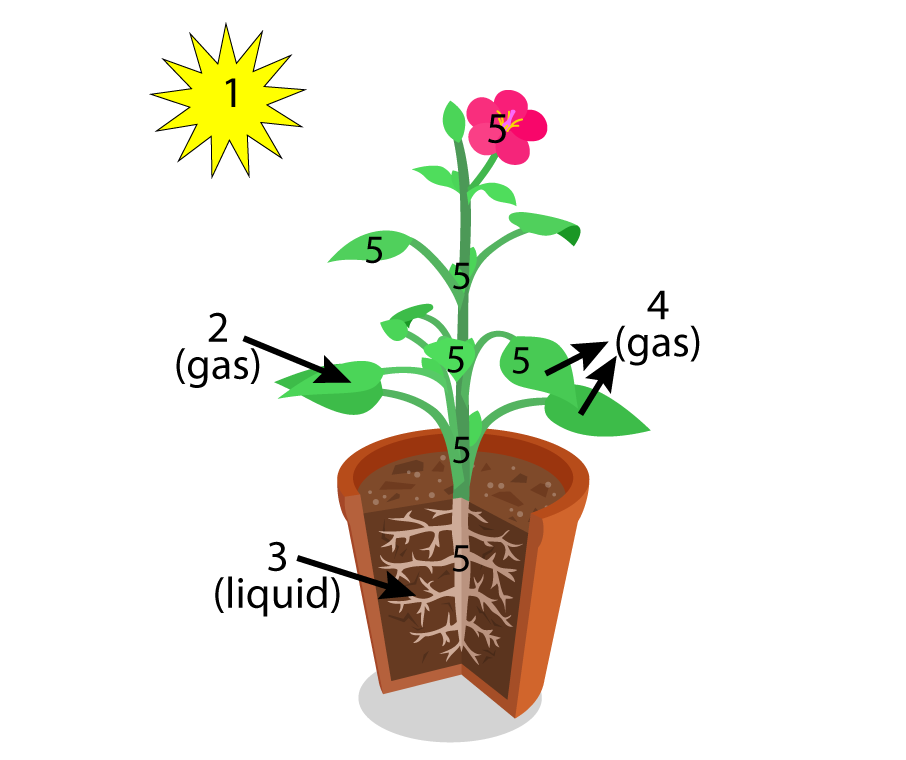 \
\
And this is from my second tutorial.
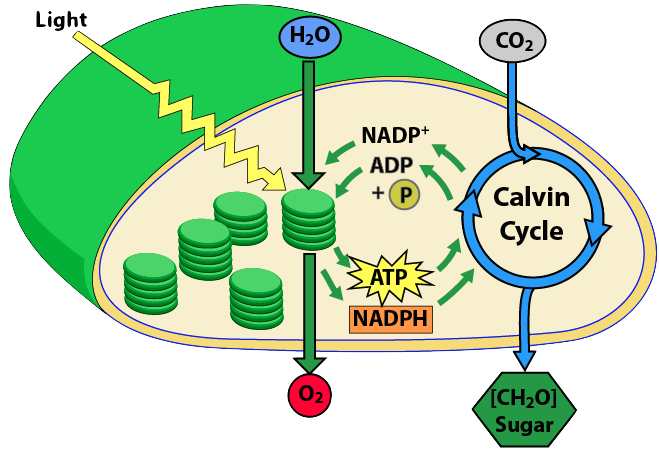
Resources for teaching photosynthesis
ScienceMusicVideos.com has everything you need to help guide your students toward mastery of photosynthesis.
Here’s the student learning guide: Photosynthesis Student Learning Guide
And here are the tutorials:
- Photosynthesis 1: An Introduction (interactive tutorial)
- Photosynthesis 2: The Two Phases of Photosynthesis (interactive tutorial)
- Photosynthesis 3: Light and Pigments (interactive tutorial)
- Photosynthesis 4: The Light Reactions (interactive tutorial)
- Photosynthesis 5: The Calvin Cycle and Comparing Photosynthesis and Respiration (interactive tutorial
Last year, I produced a video about the light reactions that I encourage you to have your students watch:
The Light Reactions Video Lecture. This video covers a lot what’s required of our students in terms of the light reactions of photosynthesis. If you’re short on contact time with your students, then this video will really help your students to understand how the light reactions work.
Finally, I have three music videos about the light reactions. You can view them on this page: The Light Reactions: A Musical Review.
While my compressed course calendar doesn’t allow me time to lecture through photosynthesis this year, you might have the time to do so. If so, please feel free to make use of this guided lecture note taking sheet as the starting point for a review worksheet that you might want to use with your students.
My first at-home lab was a blast
On Thursday, I had my students perform a potato catalase enzyme lab that was designed by Pam Phelps. Here’s a link to Pam’s lab, which I can’t recommend strongly enough. I had 60 happy students who were actually doing some science. And the lab works: check out these results (a screenshot from my Google sheet: I can’t share the sheet because it has my students’ name on it).

Email 13: The Calvin Cycle, some Photosynthesis FRQs, and Preparing for Unit 4 (Cell Communication, Feedback and Homeostasis, and Cell Division)
The Calvin Cycle
If you’ve been following this scope and sequence, then you’re in about week 12 of your AP Biology course. That means that it’s time to finish photosynthesis, and move into cell division and cell communication.
Here’s the main menu for our photosynthesis tutorials on sciencemusicvideos.com. Once you’ve taught the light reactions (something I discussed last week), all that’s left is the Calvin cycle.
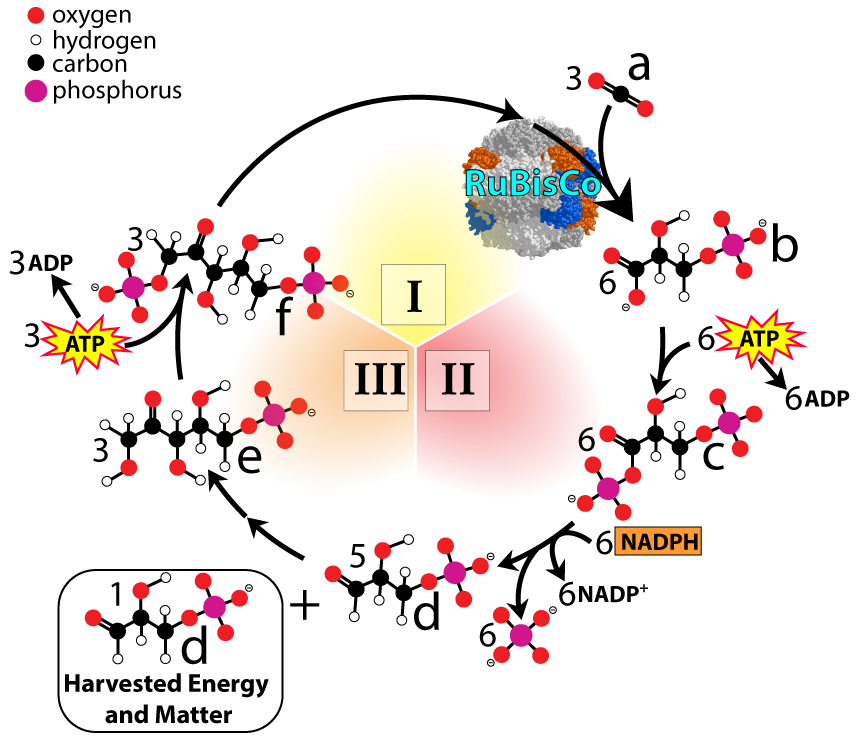
The Calvin Cycle has a couple of astonishing features. Some of these were highlighted in this story from NPR,
- Rubisco (ribulose bisphosphate carboxylase) is the enzyme that’s capable of snatching carbon dioxide out of the air and incorporating it into biological molecules. It might be the most abundant protein on earth. Makes sense: it’s in every chloroplast, in every leaf, in every tree, shrub, herb and blade of grass on Earth.
- If your students ever complain that this detailed (but wondrous) process is far removed from their daily concerns, remind them that every carbon atom in their body was once a molecule of carbon dioxide floating in the air. We all owe our very being to the Calvin Cycle.
- Rubisco and the Calvin Cycle as a whole evolved very early on in the history of life — way before there was appreciable amounts of molecular oxygen in the atmosphere or dissolved in the the oceans. As a result, Rubisco has an enzymatic quirk: its active site can bind oxygen (and not just carbon dioxide). This is especially true at high temperatures, and causes Rubisco to incorporate oxygen into the Calvin Cycle, producing a toxic compound that plants have to detoxify, lowering the efficiency of plant growth. Plants like cacti and corn have, as a consequence, evolved supplementary pathways for fixing carbon dioxide. These are the C4 cycle and CAM photosynthesis, respectively. They’re no longer part of our curriculum, but they used to be (before AP bio was redesigned in 2012). If you have some students that need some enrichment, these pathways are great topics for students to explore.
A few photosynthesis FRQs you can use with your students to wrap up your photosynthesis unit
Here’s a link to three photosynthesis FRQs that the College Board has used during the past few years. The scoring guides are all available online, so they’re best used for practice. In fact, that leads me to a recommendation for a great activity, which you can do whether or not you’re in the classroom with your students, or 100% online.
Step 1: Organize your students into small teams of 3-4.
Step 2: Have your students, in groups, talk through the FRQs for a few minutes. I always try to set norms about how students do that so that all students are equally sharing. And, one of my classroom mantras is that “Biology is a team sport.” I’m constantly encouraging my students to be helpful, and to ask for help as needed.
Step 3: Have students write their responses to these FRQs.
Step 4: Distribute scoring guides. Have student read the guides and ask clarifying questions.
Step 5: Have students self-evaluate or peer evaluate each other’s papers.
This is a great lesson plan that takes relatively little preparation on your part (other than really understanding the prompt and the response so that you can explain it to your students: that can take some time). It’s incredibly valuable to your students, and will move them very far along towards getting ready for the AP exam.
Cell Division and Cell Communication are up next. Here’s how I sequence it
After you’ve finished photosynthesis, you’re done with unit 3. Congratulations! What follows next is Unit 4: Cell Communication and the Cell Cycle.
I usually teach cell division/mitosis first. That’s partly because the cell cycle and phases of mitosis are pretty easy, and provide a bit of a break between photosynthesis and cell communication (one of the most difficult topics in the curriculum). But I don’t teach all of cell division: I leave regulation of the cell cycle for the end (after cell communication). Why? Because cell cycle regulation is largely about cell communication. It makes sense to teach about kinases first, and then come back and finish the process. So here’s my sequence:
- Mitosis and the Cell Cycle Interactive Tutorial
- Cell Communication and Cell Signalling (the whole unit)
- Regulation of the cell cycle
I’ll go more into depth on all of those topics next week. But I can’t help but share that this unit has one of my favorite songs: Mitosis! Just scroll down to the bottom of the tutorial page. There’s even a Karaoke version. Enjoy!
Email 14: Learn-Biology.com will be our new name; Unit 6 before Unit 5!; Cell communication
We’re (slowly) going to change our name to Learn-Biology.com
Did you notice my new banner? Over the next few months, we’re going to be changing our name to Learn-Biology.com. Why? I’ve found that too many folks (especially administrators!) were confused by our sciencemusicvideos name. Our site is about helping you support your students in learning biology. Calling ourselves Learn-Biology.com makes that much easier to understand.
Learn-Biology.com is already up and running. It’s almost exactly the same site as sciencemusicvideos.com (except for the name). Your students’ experience (and the benefits they reap) will be exactly the same. If you’re interested, please take a look.
Why I teach unit 6 before unit 5…and why you should too.
As an online, interactive textbook/content-learning system,, sciencemusicvideos.com or Learn-Biology.com will support your students in whatever sequence you choose to follow. But I think that your students’ path through the curriculum will be easier if you teach unit 6 (molecular genetics) before you teach unit 5 (heredity). Here’s why.
The College Board’s Course and Exam Description (mostly) follows a small to big sequence. Unit 1 is molecules, Unit 2 is cells. Unit 3 is energetics, but at a cellular level (enzymes, photosynthesis, and respiration). Unit 4 is also mostly cell biology: cell communication and cell division, with feedback and homeostasis (topic 4.5) sandwiched in between.
To me, it makes much more sense to stay at the cellular/molecular level, which is what Unit 6 addresses, before moving onto the organismal level, which is what most of Unit 5 (Heredity), is about. On top of that, it seems like it makes much more sense for our students to understand what genes are and how they work (all covered in unit 6) before looking at how genes are transmitted from generation to generation and how they’re recombined.
Finally, in terms of moving forward, I like to move from Mendelian Genetics (which is in unit 5) to Population Genetics (which is what kicks off unit 7).
Because this how I teach it, I’ll reflect that sequence in my next 10 or so emails (as we move through the next 10 weeks of the course). So I hope you’ll follow me. If you don’t, don’t fret: our tutorials will be just as effective, whatever order you choose to do them in. However, you might not benefit from these emails quite as much. But if you ever want to talk, just shoot me an email and we’ll set up a meeting.
Supporting your students in learning about cell communication
If you’re ever wondering what the College Board’s official perspective is on what you should cover in any unit of instruction, I have a condensed version of the official Course and Exam Description. This google doc, which you should feel free to consult (or make your own copy of) takes the College Board’s very long .pdf, and puts it in a much more condensed form (just 42 pages, as opposed to over 200 in the pdf).
So what does the College Board say that you should cover when you teach Cell Communication? Here are the highlights of what students should understand:
- Various types of cell communication via direct contact, short distance, medium distance, and long distance signalling. Illustrative examples could include cell-to-cell contact in the immune system, neurotransmitters, quorum sensing, morphogens, insulin, testosterone, etc.
- Components of signaling pathways (reception, transduction, response)
- Details of reception, with G-protein coupled receptors as an illustrative example.
- Signaling cascades, and the role of second messengers such as cAMP
- Signal Transduction Pathways, with quorum sensing in microbes and epinephrine inducing glycogen breakdown in mammals as illustrative examples
- Cellular responses: cytokines, mating pheromones in yeast, male sexual development, and HOX genes are listed as examples.
That’s a lot. Note that what’s above is an outline of an outline. Follow this link to read the detailed outline.
Here’s how our tutorials on sciencemusicvideos.com (or Learn-Biology.com) will help your students through this material.
In Introduction to Cell Communication, your students learn about basic signaling concepts: release of a signal, reception, and then induction of some kind of response. This is done through studies of
- quorum sensing during biofilm formation,
- signaling between mating types during yeast mating.
- Overviews of direct contact and short, medium, and long distance systems in multicellular eukaryotes, including plasmodesmata, immune signaling, embryonic induction, synaptic signaling, and endocrine signaling.
This tutorial helps your students master diagrams like the one below, which shows how bacteria will only start producing the polysaccharide matrix of a biofilm (6) when a signaling molecule (2) gets to be in high enough concentration to bind with a cytoplasmic receptor (3) that acts as a gene activator (5).
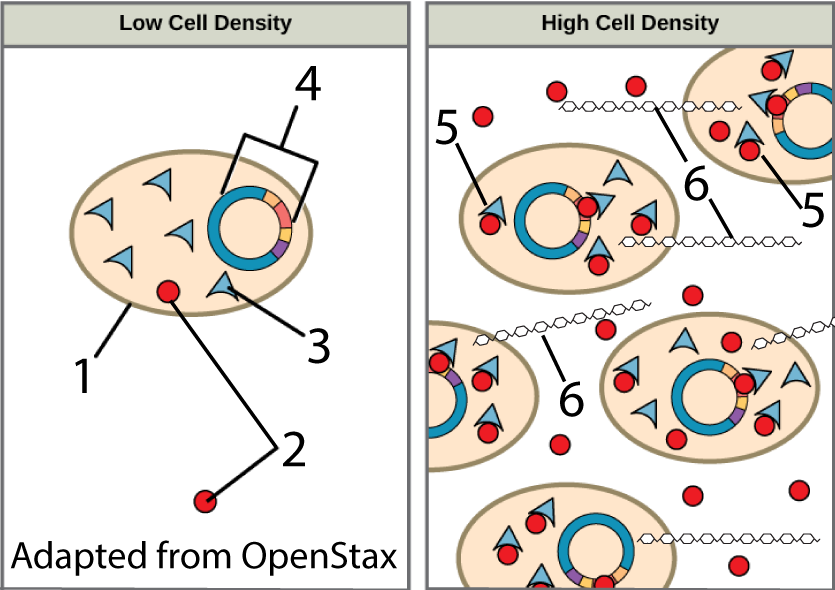
In the next tutorial, Cell Signalling, Introduction, I introduce students to the story of what comes next: how the fight or flight response leads to epinephrine release, which stimulates liver tissue to break down stored glycogen, releasing glucose into the blood. I usually tell a story of a time when I got really scared by a dog lunging at me in a parking lot. Any student would know that my heart was pounding, and my hair was standing on edge. But they probably wouldn’t know that my blood glucose level was spiking. Where did that glucose come from? The story that follows focuses on how that happens.
Mastery of this image is the overall goal:
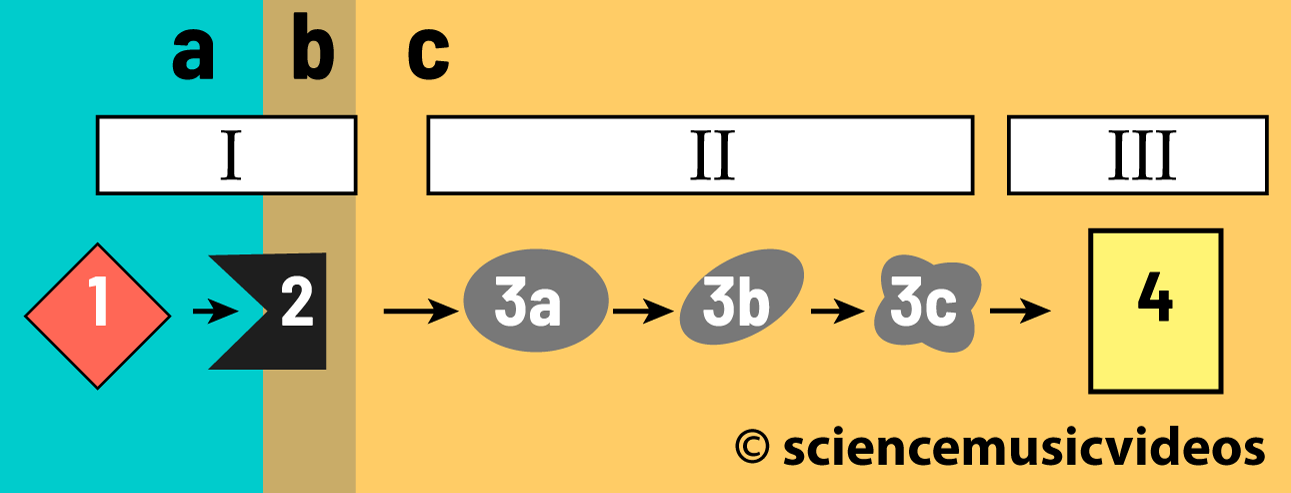
In the next tutorial, “Reception,” the focus in on understanding the series of events that leads a G-protein coupled receptor (1), to respond to epinephrine (8) in a such a way that a cellular response (5) is induced.
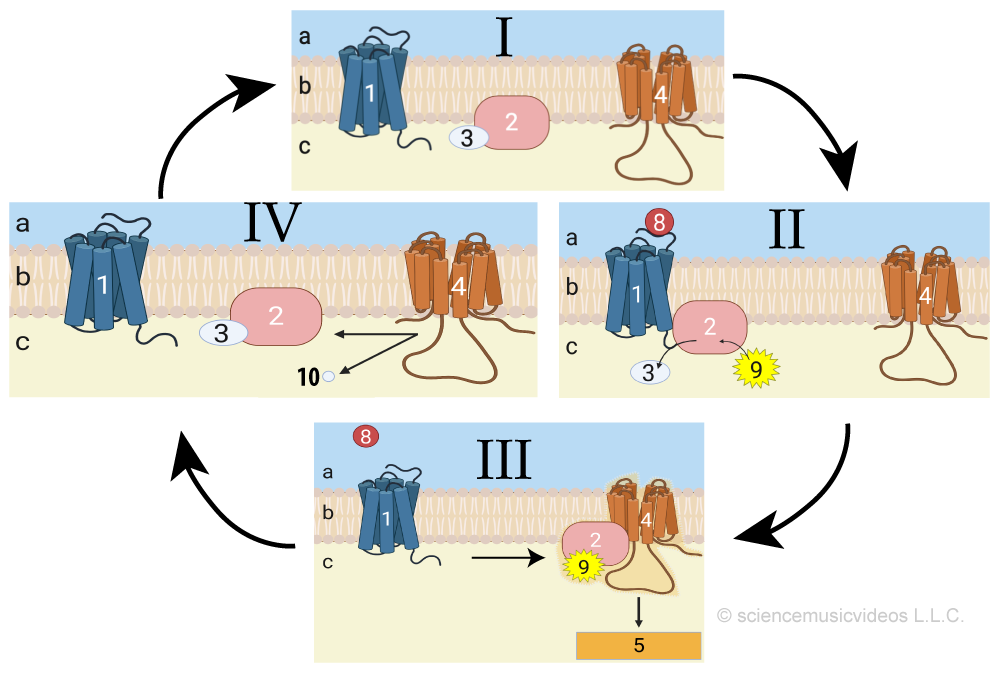
This is followed by a tutorial on Signal Transduction, which leads your students to mastery of diagrams like this:
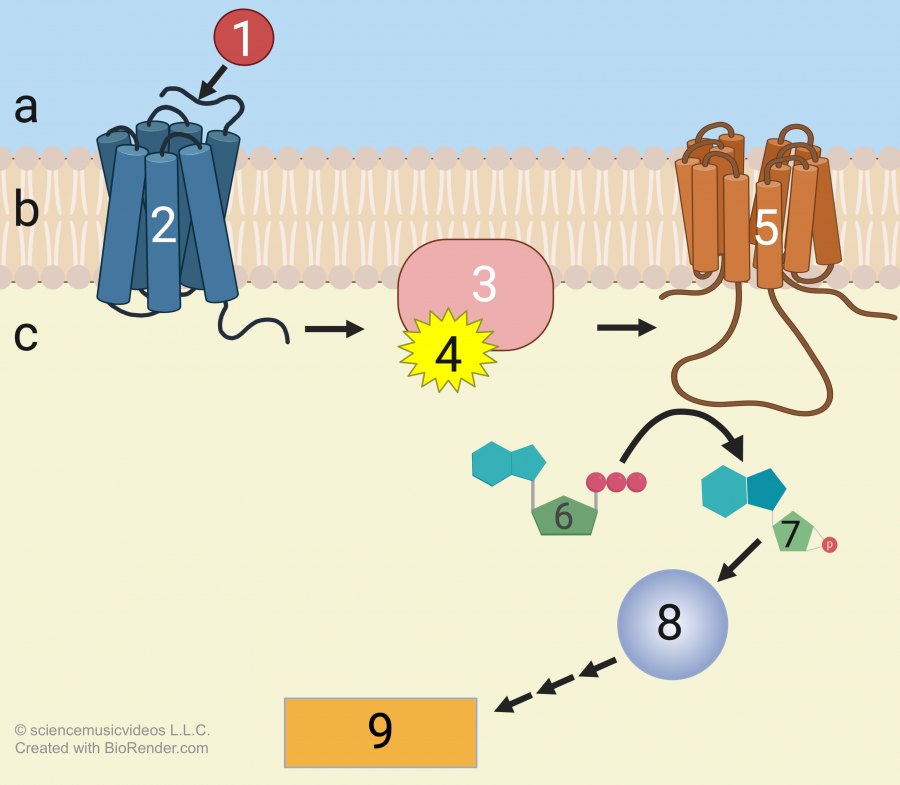
and finally this:
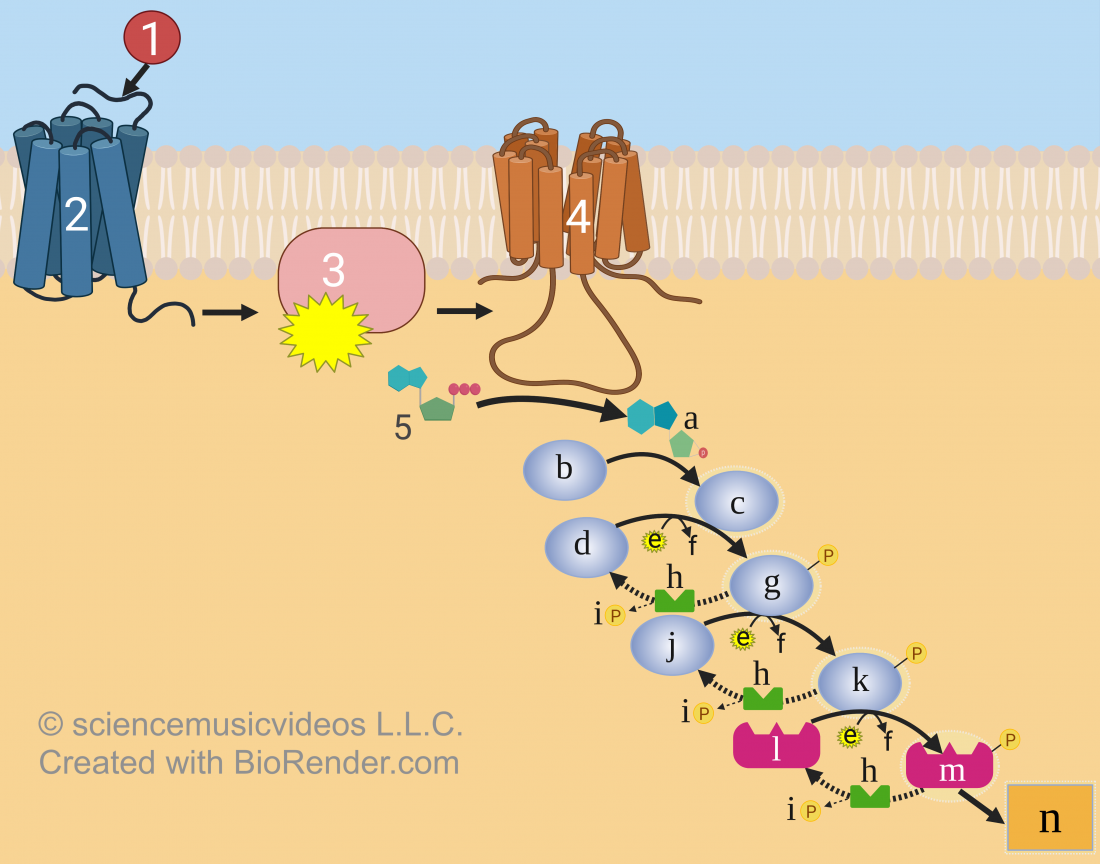
By the end, your students will understand the essential idea: these signaling systems allow the cell to stand on a hair trigger alert, and then instantly change state in response to a signal, and then, just as quickly, turn back off. It’s all about amplification of a signal.
Here’s the diagram that illustrates that:
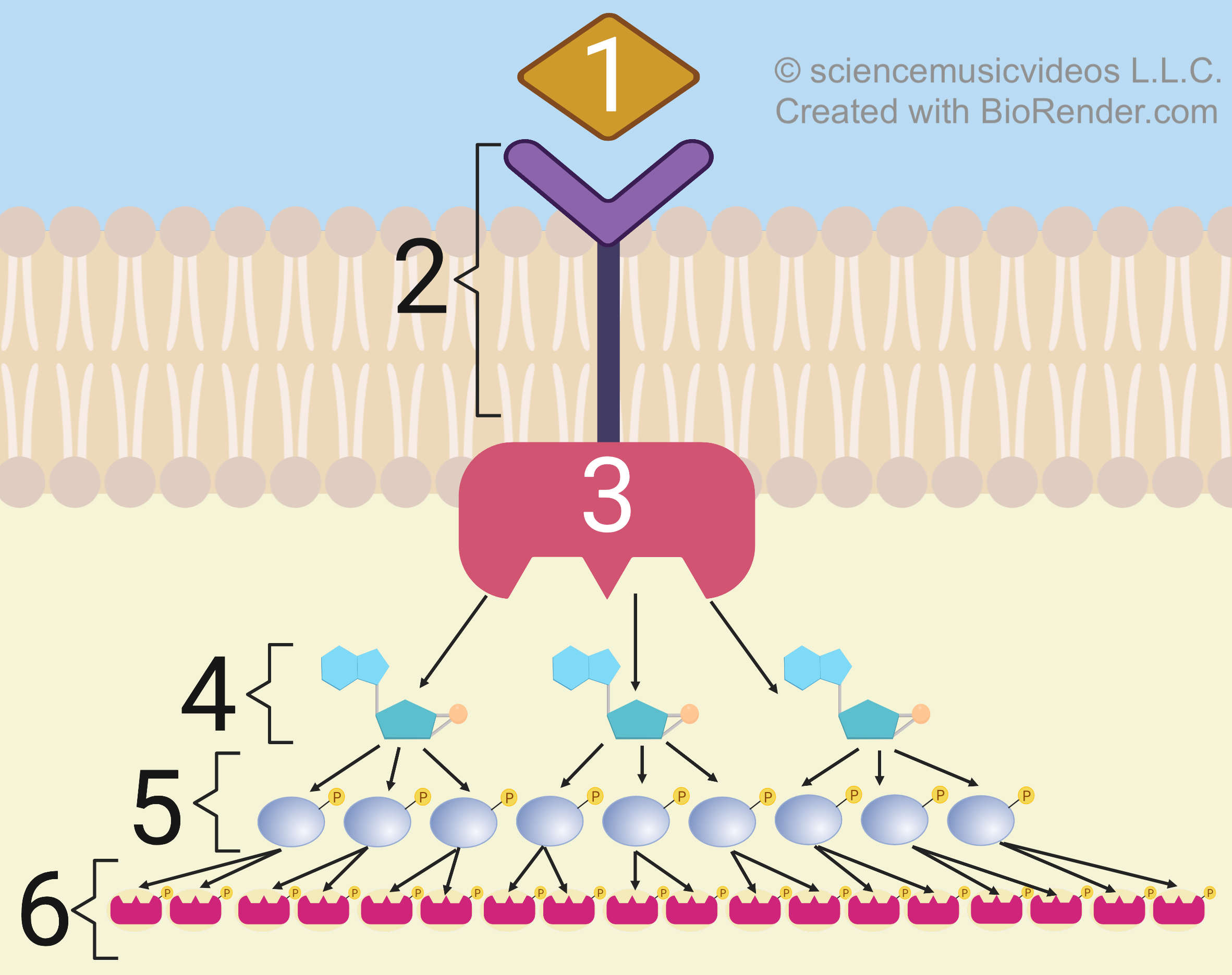
In the last tutorial in this module, students learn about how endocrine signaling can affect gene expression. Here I use two illustrative examples: growth hormone, and steroid hormones like estrogen and testosterone. Here’s the diagram related to steroid hormones that your students should be able to explain after completing the tutorial.
So, that’s the asynchronous portion of my curriculum related to cell communication. When I’m meeting with my students, I’m doing a lot of checking for understanding. You can see this in my Google slideshow for this week, where I’m really trying to use my MICE method to maximize student learning: That’s
- MOTIVATION (the backstory of epinephrine release after being threatened,
- INTERACTION (on sciencemusicvideos.com or learn-biology.com),
- CHECKING FOR UNDERSTANDING (through asking questions and using the Chat window in Zoom or cold calling; also through the two POGILS available from Flinn about cell communication, and
- EXTENSION (where students are writing and reflecting their biology learning journals.
Email 15, Cell Cycle Regulation; Feedback
If you’re following this scope and sequence, then this week you’ll turn from cell communication (AP Bio Topics 4.1 to 4.4) to cell cycle regulation (AP Bio topic 4.7), and then to Feedback/Homeostasis (AP Bio topic 4.5).
Before I share some ideas about these topics, I also want to remind you that I teach unit 6 before unit 5 (see last week’s email to see why). That means that we’ll start DNA structure and Function on the week of December 7. If you teach unit 6 before unit 5, these emails will be much more useful to you to guide your planning (so I hope that you do).
Supporting your students in learning about cell cycle regulation
According to the College Board (in their 2019 CED, available in condensed form here), here’s what you should be covering in relationship to Cell Cycle Regulation (slightly edited for clarity).
- Describe the role of checkpoints in regulating the cell cycle.
- A number of internal controls or checkpoints regulate progression through the cycle.
- Interactions between cyclins and cyclin- dependent kinases control the cell cycle: Exclusion: no need to know specific cyclin-CdK pair or growth factors
- Describe the effects of disruptions to the cell cycle on the cell or organism.
- Disruptions to the cell cycle may result in cancer and/or programmed cell death (apoptosis).
Our cell cycle regulation tutorial on sciencemusicvideos.com covers the ideas in number 1 very well. After describing what’s in it, I’ll point you to a great resource to cover what’s in number 2.
I start with description of cell fusion experiments from the 1970s. Here’s an example
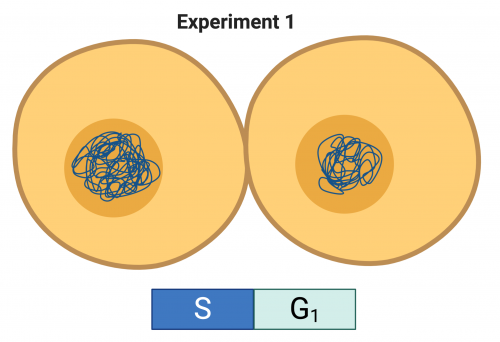
A cell in S phase was fused with a cell in G1. What happened? The G1 cell immediately entered S.
What’s going on? Some molecule available in the “S” phase cell could induce the G1 phase cell to enter S (even if it wasn’t completely ready). Conclusion: some signaling molecule was inducing the cell’s progression through the cycle. That is why, by the way, I teach cell communication before I teach cell cycle regulation.
From there we go into reading and quizzes that lead to understanding of the idea of cell cycle checkpoints, as shown in the diagram below.
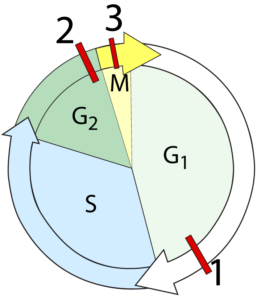
Next, students look at how the rise and fall of cyclins and MPF is what controls the movement of cells from G2 into M phase.

This culminates in reading and interacting with diagrams like the one below, showing how interaction between mitotic cyclin and Cyclin Dependent Kinase (CDK) leads to the formation of MPF, the molecule that induces the cell to move from G2 into M.
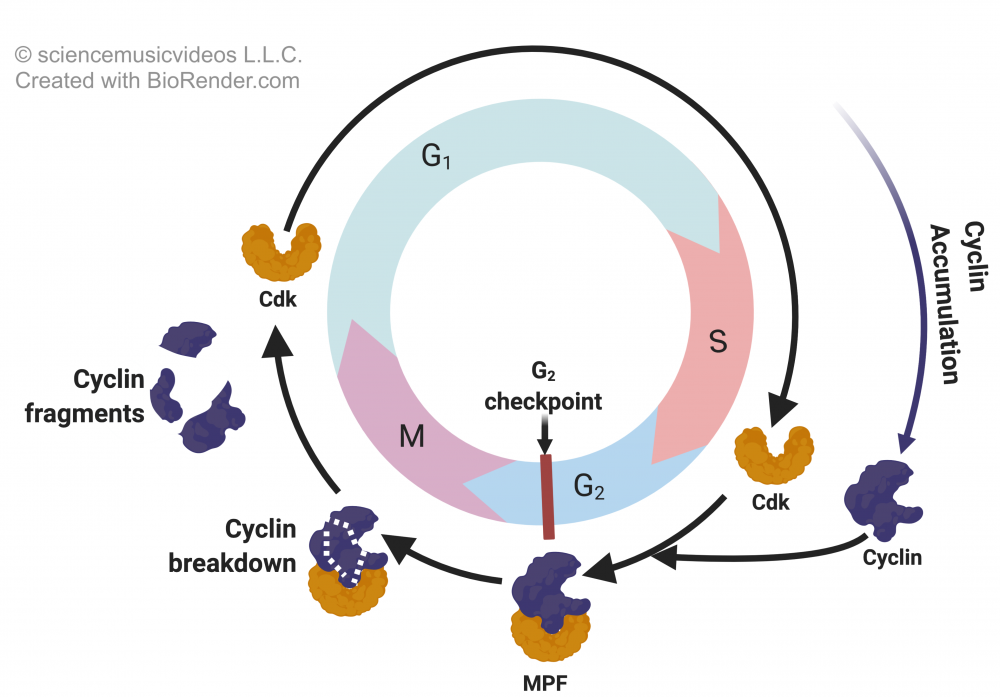
To move beyond this understanding into cell cycle disruption, I strongly recommend HHMI’s “The Eukaryotic Cell Cycle and Cancer.” HHMI also provides additional resources (including worksheets) on this page. I also recommend Flinn’s Cell Cycle Regulation POGIL as a group activity to help guide your students to mastery.
To see how I check for understanding of this material, take a look at these slides from my weekly slideshow. What I’m finding is that after the tutorial, my students are pretty good at being able to explain the visual representations and concepts in these slides (freeing me up for HHMI, POGILS, etc.).
Supporting your students in learning about feedback/homeostasis
After finishing topic 4.7, I end unit 4 with topic 4.5, Feedback. Here’s a slightly edited version of what the College Board is expecting you to cover.
- Describe positive and/ or negative feedback mechanisms.
- Organisms use feedback mechanisms to maintain their internal environments and respond to internal and external environmental changes.
- Explain how negative feedback helps to maintain homeostasis.
- Negative feedback mechanisms maintain homeostasis for a particular condition by regulating physiological processes. If a system is perturbed, negative feedback mechanisms return the system back to its target set point. These processes operate at the molecular and cellular levels.
- ILLUSTRATIVE EXAMPLES[
- Blood sugar regulation by insulin/glucagon
- Explain how positive feedback affects homeostasis.
- Positive feedback mechanisms amplify responses and processes in biological organisms. The variable initiating the response is moved farther away from the initial set point. Amplification occurs when the stimulus is further activated, which, in turn, initiates an additional response that produces system change.
- ILLUSTRATIVE EXAMPLES
- Lactation in mammals
- Onset of labor in childbirth
- Ripening of fruit
Here’s how sciencemusicvideos.com guides your students through mastery of this material.
In Feedback/Homeostasis 1: Key Concepts, Thermoregulation, I use thermoregulation as an entry point to the general concept of homeostasis. Why? While this kind of curriculum expanding thinking is a dangerous temptation that I usually avoid, I can’t stand the idea that my students will leave my class without understanding the difference between endotherms and ectotherms. And it seems to come up throughout the course. Why do the beans in a respirometer increase their oxygen consumption at higher temperatures? They’re ectotherms. Why is the opposite (within limits) true for a mammal. Because we’re endotherms. It’s all about thermoregulation. When we teach about surface area and volume, I always teach about how the huge ears of elephants are a thermoregulatory adaptation. Finally, what’s an easier example of negative feedback than the workings of a thermostat?

While I use thermoregulation to introduce negative feedback, I use onset of labor as an example of positive feedback, ending the first tutorial.
My next tutorial in this topic is about blood sugar regulation.
My focus here is how the body maintains a blood glucose set point through the action of insulin and glucagon.
In terms of insulin, the tutorial will leave your students with mastery of diagrams like this:
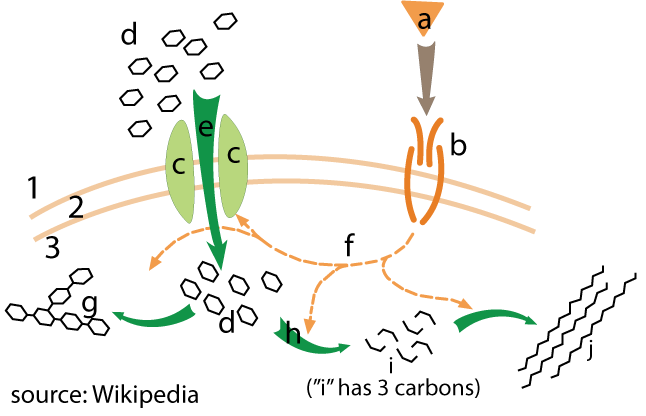
In terms of glucagon, your students should easily be able to master this diagram: That’s because in liver tissue, glucagon’s activity is very similar to that of epinephrine. That’s the hormone we studied extensively in topics 4.1 to 4.4.
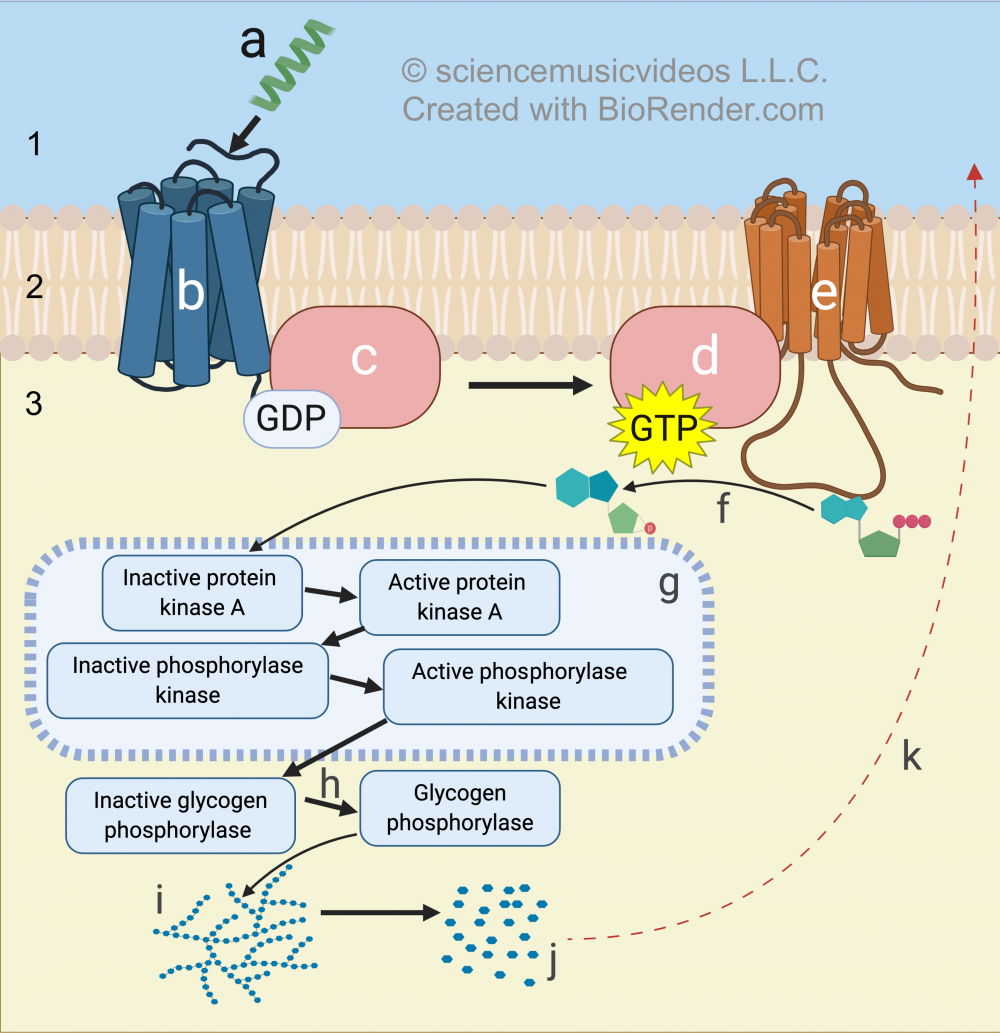
Understanding the effect of both insulin and glucagon will leave your students with mastery of diagrams like this:
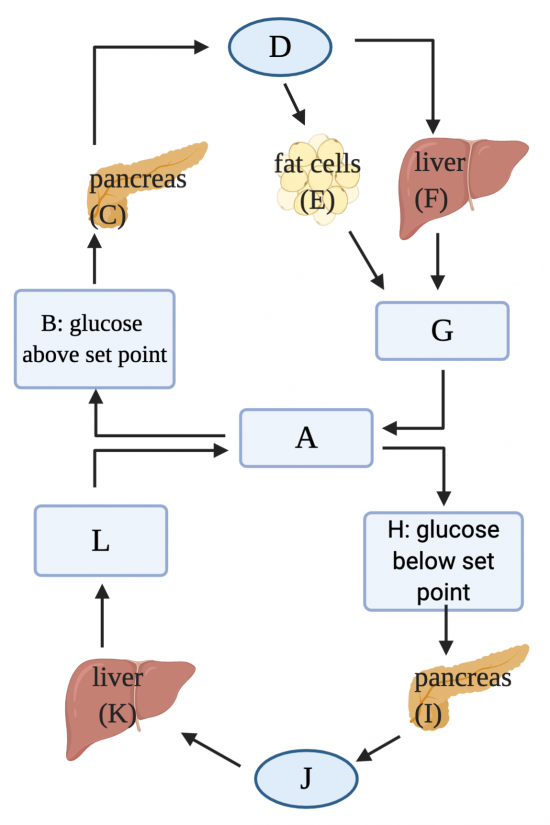
And students will also be able to explain the differences between and the causes of Type 1 and Type 2 diabetes. If you’re like me, then you’ll feel great about giving your students some important information that might impact their nutrition choices, lengthen their lives, and set them up for the AP Bio exam.
The third tutorial in this series, entitled ADH and Osmoregulation, should be considered to be optional. It’s fantastic stuff, but it’s a bit of a vestige of course content that predates the 2019 redesign.
In terms of classroom resources for feedback and homeostasis., Flinn offers two POGILS
- Feedback mechanisms
- Blood sugar regulation
Email 16, DNA Structure and Replication, Timed Secure Quizzes, Teacher Previews
Some Gratitude
With Thanksgiving coming up, I want to start by thanking you for using sciencemusicvideos.com. It means a lot to me that you’ve chosen our website as as the place where you’re sending your students to deepen their knowledge of AP Biology content. We’re constantly working to improve what we’re doing, and I thank you for your continued suggestions and support. May you get both rest and joy during the holiday.
Two New Premium Features on our websites
- Teacher Previews
- Timed Secure Quizzes
Both of these are only available to paid users. Why? Because we don’t want students making up fake teacher accounts and seeing all the answer on our quizzes, we have to put these features behind a paywall. If you’re a free trial user and you like what you see, please purchase your teacher license so that you can access these features.
Teacher Previews
Go to any quiz on the site. The quiz below is from my DNA replication tutorial, which I discuss below. Log in with the same username and password that you use to log in to our teacher portal at qwizcards.com/login. Then click the “STUDENT LOGIN” button.

Notice that there’s a blue triangle on the top right, and the dialogue box says “Teacher logged in as student [your username].”

Click the link that says “Teachers only: preview this quiz” and you get this preview of the entire quiz.

If you click the “show answers” button, you see all the answers, too.

Timed, Secure Quizzes
During the past few weeks, I’ve started to develop a series of timed, secure quizzes.
Timed secure quizzes are multiple choice quizzes that are locked until you open them. That’s why they’re timed. They’re secure because they aren’t available in the source HTML from the page (so students can’t look behind the scenes to see the answers). In addition, the quizzes are served in random order to each student, making it difficult for students to text answers to one another.
How were they designed to be used? I’m using them to give my students an extra incentive to do the tutorials on sciencemusicvideos.com by a certain date. In other words, I’ll give a quiz on Thursday based on Wednesday night’s homework. That frees me up to not be spending my limited teaching time by delivering information, but rather checking for understanding.
Interested? If you’re a paid user, go on over to
https://learn-biology.com/timed-secure-quiz-menu/
Use the method above to preview any of these quizzes.
If you want to assign these quizzes, please consult this document (which also links to an instructional video).
Science in the News
As an AP Bio teacher, you’ve probably been following the news related to vaccines against SARS-CoV-2. Here are three resources for you and/or your students.
- Here are two readings about the biology of the two recently released mRNA vaccines. The first is to Moderna’s mRNA vaccine in The Conversation. The second is in Massive Science, and it’s about Pfizer’s mRNA vaccine.
- The NY Times has an ongoing vaccine tracker. This tracker also includes
- An image from pfizer about mRNA vaccines.
A typical move for me, both on my website and in the classroom (or on Zoom), is to take an image like the one above, strip out the explanatory text, and to add numbers. Then, after reading or lecture, I’ll have students do a partner share (if you’re in-person), or use breakout rooms, or just have students respond in the chat to questions. In any of those situations, the goal would be for students to be able to explain what’s happening at each numbered part of the diagram.
Here’s that image, ready for interaction.
On to Unit 6, Gene Expression and Regulation
If you’re following this scope and sequence, and you’re following my advice to do unit 6 before unit 5, then here’s what’s coming up next.
- Finishing up unit 4.5 (Feedback)
- Moving on to Unit 6, Gene Expression and Regulation.
Teaching DNA Structure and Replication
Learning Objectives
According to the College Board (in their 2019 CED, available in condensed form here), here’s what you should be covering in relationship to DNA structure and replication. The CB’s objectives are expansive. What’s below is my summary.
- Topic 6.1: DNA structure
- DNA is the molecule of heredity in most living systems. RNA can play that role in viruses
- Prokaryotes have circular chromosomes. Eukaryotes have linear chromosomes. Prokaryotes also have plasmids
- Base pairing rules: A w/ T; G w/ C. In RNA, A w/ U
- Topic 6.2: DNA Replication
- DNA replication occurs in a 5’ to 3’ direction (with new nucleotides added at the 3′ end.
- The process is semi-conservative
- The process involves a team of enzymes: Helicase, topoisomerase, DNA polymerase, ligase are involved
- Replication happens differently between the leading strand and lagging strand.
Here’s how to teach this material.
Starting with some discovery learning
As an entry way into DNA structure, I like to do an activity about how the structure of DNA was discovered. To do that, I use an this activity: Discovering the Structure of DNA. This activity presents the “clues” that were uncovered in the 1800s and 1900s that eventually enabled Watson and Crick to develop their double helix model of DNA. After each clue, students draw inferences. At the end of the activity, students can use this DNA Model Construction Kit (a Google Slideshow) to create their own model of DNA. If you’re in person with your students, you can award “Nobel Prizes” to any group that gets their model right. My Nobel Prize was a gold star. If your students are like mine, you can get an AP Bio student to work pretty hard for a gold star.
The activity takes about an hour, and it’s designed for students to do in groups. The Google Docs version works very well in a breakout room. If you’re able to fo the paper version, make the model pieces on cardstock, and save each group’s cut outs (so you can save time next year).
DNA Structure and Replication Tutorials
Following that, you can send your students to sciencemusicvideos.com for these three tutorials:
1. DNA: An Overview
2. DNA Structure
3. DNA Replication
which are accompanied by this student learning guide
The overview will give your students mastery of diagrams like this:
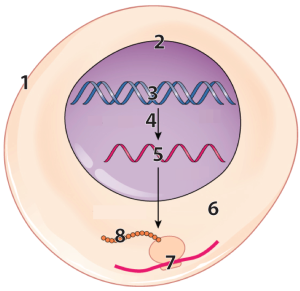
and related concepts: replication, transcription, and translation.
The second tutorial will enable your students to explain the structure of DNA, both at a big picture level like this:

and also like this:
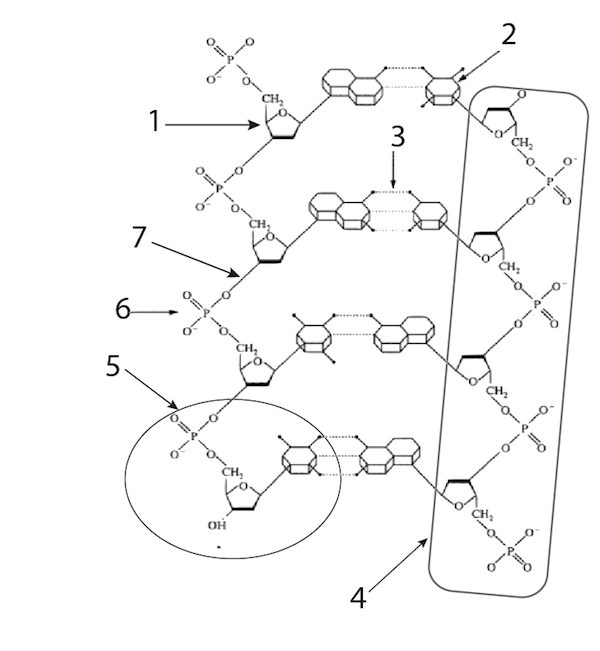
Concepts like base pairing rules, nucleotide structure, hydrogen bonding, are all covered. Note that at this point in the course, I say much about plasmids, but I do cover them in two other places: my module about bacterial genetics and operons, and in this tutorial about genetic engineering.
In my DNA replication tutorial, students learn about replication on a big picture level, and then in a way that covers all of the required enzymes (excepting topoisomerase, so don’t forget to mention that to your students). By the end of the tutorial, your students will be able to talk their way through diagrams like this, explaining all the relevant enzymes.
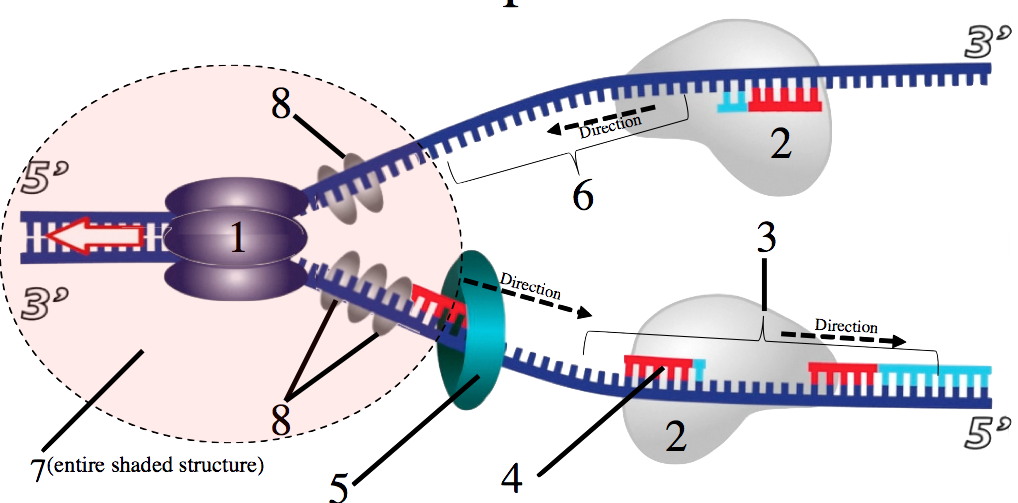
They’ll also have mastery of this one, contrasting the leading and lagging strands.
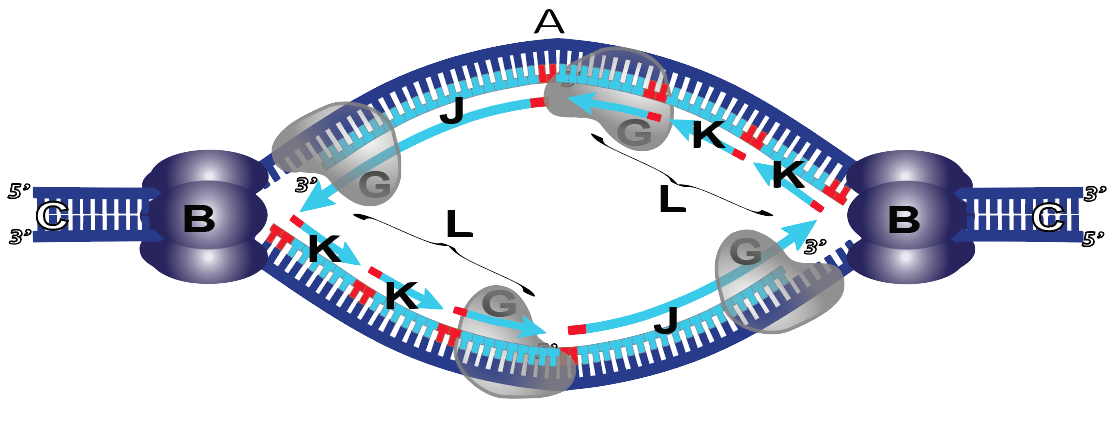
Other Resources
Here’s a few other activities/resources for teaching DNA Structure and Replication
- Pulse chase primer experiment (AKA Meselson-Stahl Experiment) HHMI. This is a fantastic way to walk your students though what has been called the “most beautiful experiment in biology.” Once you do this, your students will understand both what the semiconservative model of DNA replication is, and how it was verified.
- HHMI’s DNA Replication Computer Animation (see # 6 on my tutorial), or here on youtube. After you go over my tutorial with your students, you should show this much more detailed computer animation.
- Music Videos
- DNA, Fantastic! This is my music video that explains DNA structure. It was my first ever rap song, and my first collaboration with my music producer, Max Cowan.
- DNA Replication: This music video explains the entire replication process, hitting almost every enzyme. It’s all done to a salsa beat, and he animations are very useful.
- DNA Replication Notetaking Guide. This has pretty much every diagram of my website in a form that you can use to review with your students.
- For synchronous learning, here’s my Google slideshow. The slides show how I’m using breakout rooms and direct instruction to check for understanding after my students complete their tutorials.
Email 17, Transcription and Translation
Science in the News
Teaching about Transcription, the Genetic Code, and Translation
Transcription and Translation: The Big Picture
When you’re teaching processes like transcription and translation, it’s easy to get lost in the details. So what’s important? Let’s look at transcription and and translation from the perspective of biology’s four big ideas.
EVOLUTION: Transcription and translation are how changes in genotype by mutation or recombination manifest themselves as new phenotypes, which then get acted upon by natural selection. In these pandemic times, it’s hard not to think of how viruses in the coronavirus family were randomly mutating and recombining, until a viral RNA sequence arose that coded for a spike protein that was particularly good at binding with the ACE protein on the surface of epithelial cells in the human respiratory system. That was what made the spillover from bats to humans possible.It’s painful to think of this as an example of a successful phenotype, but that’s exactly what it is.
To go broader, this connection between information in nucleic acids and action in proteins is what life itself is all about. Years ago I was lucky enough to attend a lecture by Richard Dawkins in San Francisco. Dawkins was asked what life on other planets would be like. His response: some kind of genetic system for storing and transmitting information from cell to cell and from generation to generation. On Earth, that’s DNA. There would also be some system for manifesting this genetic information as an action system that would replicate those genes. On Earth, that’s to some extent RNA (which can itself be catalytic) but mostly it’s the protein that RNA codes for. On other planets, both systems could be chemically very different from what we have on Earth, but both will have to be there in some form.
INFORMATION FLOW: The flow of information in living things is what transcription and translation are all about. In terms of information, we see the central dogma at work. Information in a DNA template strand flowing to pre-mRNA in a eukaryotic nucleus, then flowing into the cytoplasm where ribosomes translate that message into protein. DNA triplets become mRNA codons, which become sequences of amino acids. To take this a step beyond the central dogma, this primary structure (the polypeptide sequence) has information to specify a specific 3D shape (which programs like Deep Mind can now predict—see Science in the News Above).
Information flowing in can impact this system as well. To make this connection to your students, you can talk about how hormones like estrogen, testosterone, and growth hormone bind with cytoplasmic receptors, which then diffuse into the nucleus activating transcription. This is a topic that we’ll cover soon when we look at operons, eukaryotic gene regulation and development.
ENERGY FLOW: The synthesis of RNA sequences in mRNA, tRNA, and rRNA from RNA nucleotides is a big uphill push against entropy, and it doesn’t happen spontaneously. This endergonic reaction proceeds because RNA nucleotides come in to the nucleus as tri-phosphorylated nucleotides (like ATP). RNA polymerases use the energy in those phosphates to synthesize strands of RNA. Similarly, a lot of ATP is required to power the formation of peptide bonds during protein synthesis. To help students make some connections that they might not make on their own, it’s a good idea to remind your students that this energy can be traced back to cellular respiration, powered by glucose (and other fuels), ultimately powered by the sun.
SYSTEMS: Transcription of RNA and protein synthesis are both processes that are deeply embedded in the structure of cells. But the system can be simplified to run in vitro, which you can read about here on Wikipedia. These cell-free systems are not new: Marshall Nirenberg used such a system to decipher the genetic code,
Question: did you like this big picture overview? If so, let me know (along with anything else that might be on your mind).
Transcription and Translation Learning Objectives
According to the College Board (in their 2019 CED, available in condensed form here), here’s what you should be covering in relationship to transcription and translation . What’s below is a lightly edited summary of the CB’s original objectives.
TOPIC 6.3: Transcription
- LO IST-1.N: Describe how genetic information flows from DNA to RNA to protein.
- Explain how the sequence of RNA bases, together with the structure of the RNA molecule, determines RNA function—
- mRNA molecules carry information from DNA to the ribosome.
- Distinct tRNA molecules bind specific amino acids and have anticodon sequences that base pair with the mRNA. tRNA is recruited to the ribosome during translation to generate the primary peptide sequence based on the mRNA sequence.
- rRNA molecules are functional building blocks of ribosomes.
- Genetic information flows from a sequence of nucleotides in DNA to a sequence of bases in an mRNA molecule to a sequence of amino acids in a protein.
- RNA polymerases use a single template strand of DNA to direct the inclusion of bases in the newly formed RNA molecule. This process is known as transcription
- The DNA strand acting as the template strand is also referred to as the noncoding strand, minus strand, or antisense strand. Selection of which DNA strand serves as the template strand depends on the gene being transcribed.
- The enzyme RNA polymerase synthesizes mRNA molecules in the 5’ to 3’ direction by reading the template DNA strand in the 3’ to 5’ direction.
- In eukaryotic cells the mRNA transcript undergoes a series of enzyme-regulated modifications—
- a. Addition of a poly-A tail.
- b. Addition of a GTP cap.
- c. Excision of introns and splicing and retention of exons.
- d. Excision of introns and splicing and retention of exons can generate different versions of the resulting mRNA molecule; this is known as alternative splicing.
- Explain how the sequence of RNA bases, together with the structure of the RNA molecule, determines RNA function—
TOPIC 6.4: Translation
- LO IST-1.O: Describe how the phenotype of an organism is determined by its genotype.
- Translation of the mRNA to generate a polypeptide occurs on ribosomes that are present in the cytoplasm of both prokaryotic and eukaryotic cells and on the rough endoplasmic reticulum of eukaryotic cells.
- In prokaryotic organisms, translation of the mRNA molecule occurs while it is being transcribed.
- Translation involves energy and many sequential steps, including initiation, elongation, and termination.
- Exclusion: the details and names of enzymes and factors is outside of scope.
- The salient features of translation include—
- Translation is initiated when the rRNA in the ribosome interacts with the mRNA at the start codon.
- The sequence of nucleotides on the mRNA is read in triplets called codons.
- Each codon encodes a specific amino acid, which can be deduced by using a genetic code chart. Many amino acids are encoded by more than one codon.
- Nearly all living organisms use the same genetic code, which is evidence for the common ancestry of all living organisms.
- tRNA brings the correct amino acid to the correct place specified by the codon on the mRNA.
- The amino acid is transferred to the growing polypeptide chain.
- The process continues along the mRNA until a stop codon is reached.
- The process terminates by release of the newly synthesized polypeptide/protein.
- EXCLUSION: don’t memorize the genetic code
- Genetic information in retroviruses is a special case and has an alternate flow of information: from RNA to DNA, made possible by reverse transcriptase, an enzyme that copies the viral RNA genome into DNA. This DNA integrates into the host genome and becomes transcribed and translated for the assembly of new viral progeny.
- Exclusion: see DNA exclusion above
In terms of what’s below, I cover everything except for processing of eukaryotic RNA and retroviruses. That’s because these topics are covered in two modules that I’ll talk about in a future email: Eukaryotic gene regulation and Viruses.
In terms of the rest of the topics above, here are some ideas about how to teach this material.
Interactive Tutorials
Learn-Biology.com and sciencemusicvides.com cover this material through four tutorials.
1. Transcription
2. The Genetic Code
3. Translation/Protein Synthesis
4. Protein Targeting to the Rough ER
These are accompanied by this student learning guide.
The first tutorial starts by teaching the differences between DNA and RNA, and the slightly different base pairing rules (A pairs with U, not T). Students learn the basics of transcription, and will be able to explain diagrams like the one below.

In the second tutorial, students learn how to use a genetic code dictionary:
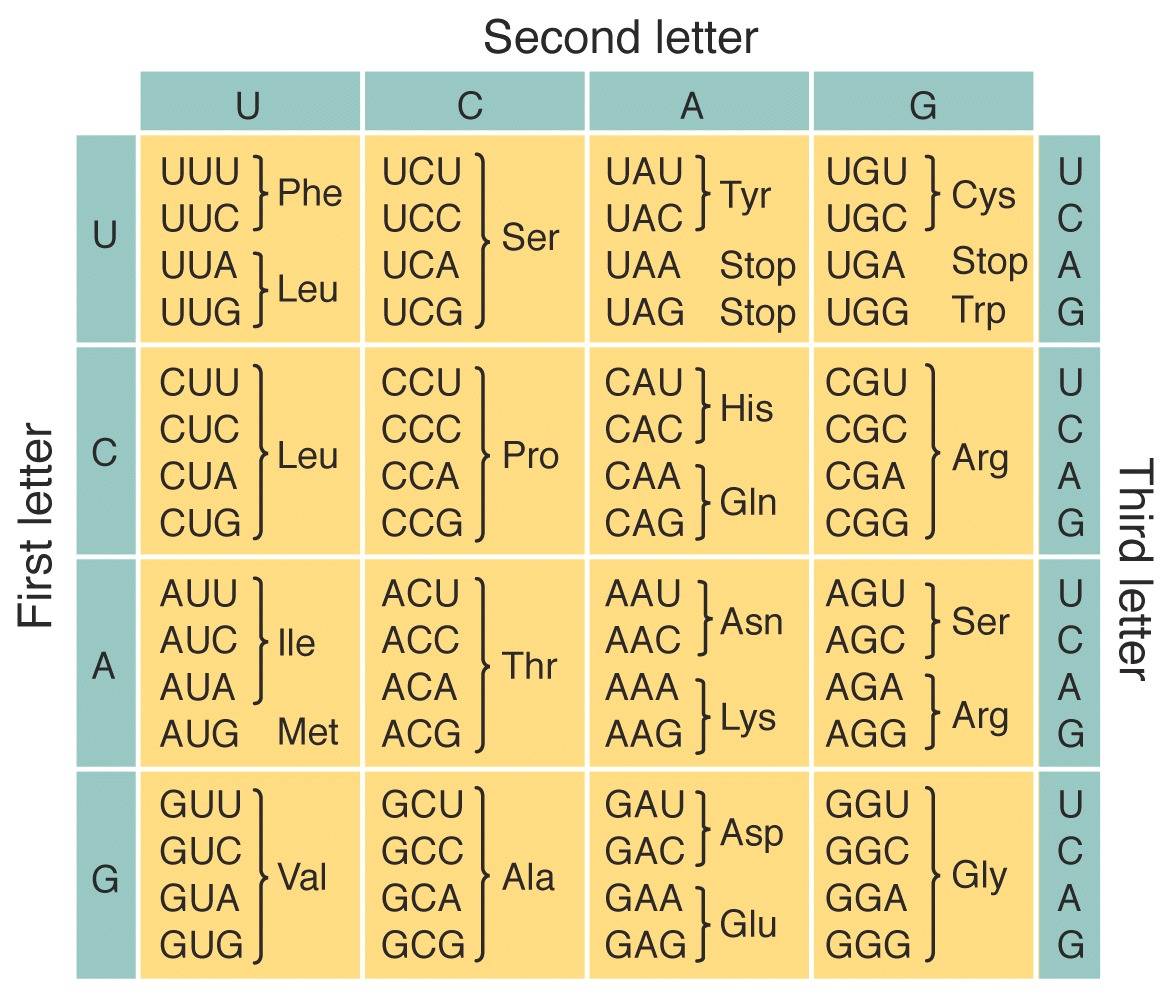
The third tutorial works through the entire process of protein synthesis, guiding your students through the various RNAs involved, and through diagrams like this:

The last tutorial in this sequence goes outside of the standards to teach about protein targeting. The underlying question here is how to ribosomes “know” whether to assemble their proteins freely in the cytoplasm, or as bound ribosomes attached to the Rough E.R. You can skip this if you’re pressed for time, but for me, this is a super-important feature of how cells work (and it only takes a few minutes).
Other Resources
Here’s a few other activities/resources for teaching transcription and translation:
- Of all the music videos I’ve made, my Protein Synthesis Song is one of my personal favorites. It explains the whole process, and has a great sing along chorus. While I’m not a big fan of Heavy Metal, this song comes pretty close. You can view it here on sciencemusicvideos.com
- Flinn has two excellent POGILs on transcription and translation. They’re entitled “Gene Expression—Transcription”: and “Gene Expression—Translation.”
- Here’s a link to a guided lecture note taking sheet that I’ve used successfully in the past. It has a a lot of practice exercises about transcription, translation, using the genetic code. If I was in the classroom with my students (and had more time to teach), I’d still be using it. I hope it’s useful to you!
Email 18: Operons
I Wish you the Happiest of Holidays
Before getting into this week’s resources, I want to tell you how much I appreciate you. Thanks for using sciencemusicvideos.com or Learn-Biology.com. It says so much about you as a person and a teacher. It says that you care about your students. It says that that you were willing to go the extra mile to support them. I am sure that they appreciate it.
If your school calendar is like mine, then you’ve got 5 days to go before you get some much deserved rest. I wish you the happiest of holidays. And let’s all hope for the best in 2021.
FYI: I’ll be taking a two week break from sending these emails. Look for my next one on Sunday, January 3.
Science in the News
COVID-19 continues to be the biology story of the century. In the NY Times, you can read about How Moderna’s mRNA Vaccine Works. AP Bio teacher Mark Scheider shared with me another coronavirus-related article. Check out CRISPR-based test for COVID-19 uses a smartphone camera. Both of these articles, by the way, are perfect supplementary reading for your AP Bio students.
While ecology is months away, you should check out this amazing article in the NY Times Magazine: The Social Life of Forests. It’s about the importance of mycorrhizal fungi. You’ll love it.
Teach Viruses and Operons Next
- Topic 6.5: Regulation of Gene Expression.
- Topic 6.6: Gene Expression and Cell Specialization
- Topic 6.7: Mutations
- Topic 6.8: Biotechnology
I don’t follow that order. The great thing about having taught transcription and translation is that it opens the door to teaching some amazing biology. And what’s more amazing than viruses and operons?
Teaching about Viruses
For some reason, the word “virus” only shows up in two places in the Course and Exam Description. It showed up in topic 6.4 in the context of reverse transcriptase.
Genetic information in retroviruses is a special case and has an alternate flow of information: from RNA to DNA, made possible by reverse transcriptase, an enzyme that copies the viral RNA genome into DNA. This DNA integrates into the host genome and becomes transcribed and translated for the assembly of new viral progeny.
and it shows up in topic 6.7 (mutation) as
Related viruses can combine/recombine genetic information if they infect the same host cell.
But there’s no way I’m going to have my students finish my AP Biology course without them having a deep understanding of viruses. So here’s my outline. I’m including relevant diagrams so you can get a quick sense of what your students will learn from our tutorials.
- What a virus is, and how viruses straddle the boundary between living and non-living.
- The basic structure of viruses, starting with phage.
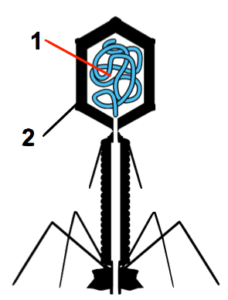
- The lytic cycle
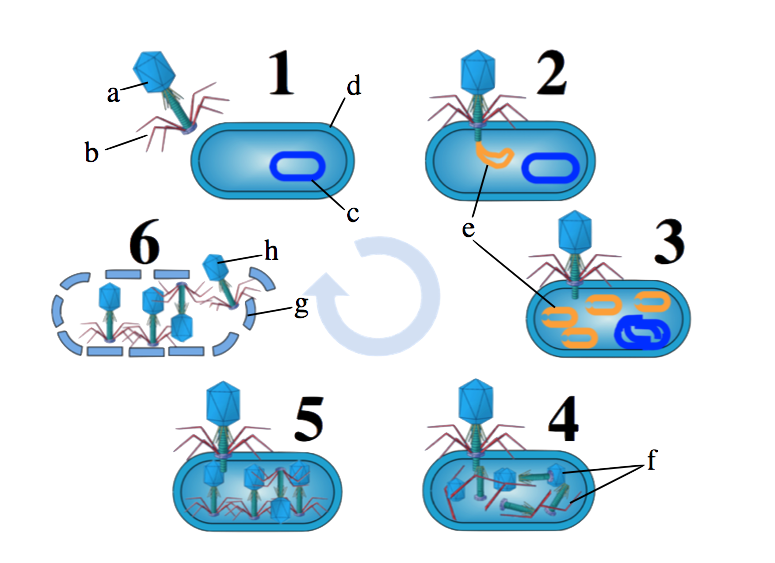
- The lysogenic cycle

- The life cycle of HIV (as an illustrative example of a retrovirus).
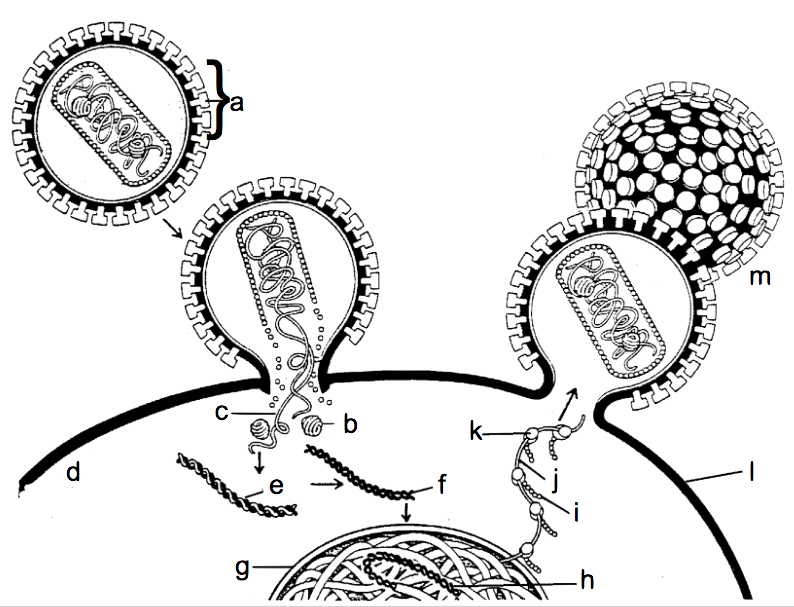
- How viruses develop their own genetic diversity through recombination and mutation, and how they introduce variation into other species through transduction.

- The life cycle and overall biology of SARS-CoV-2
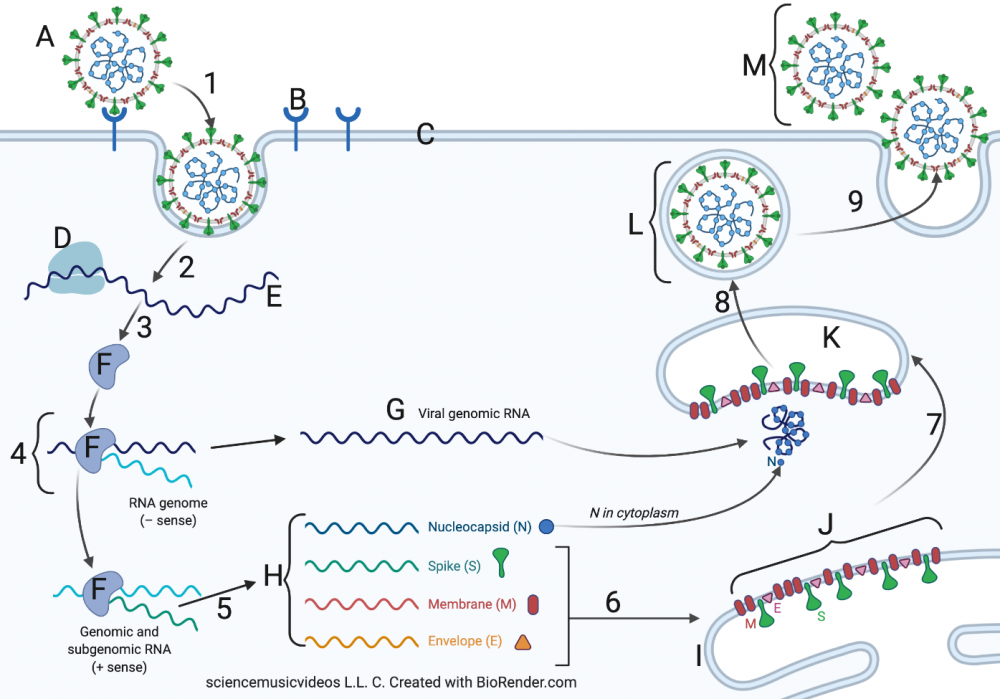
- mRNA vaccines
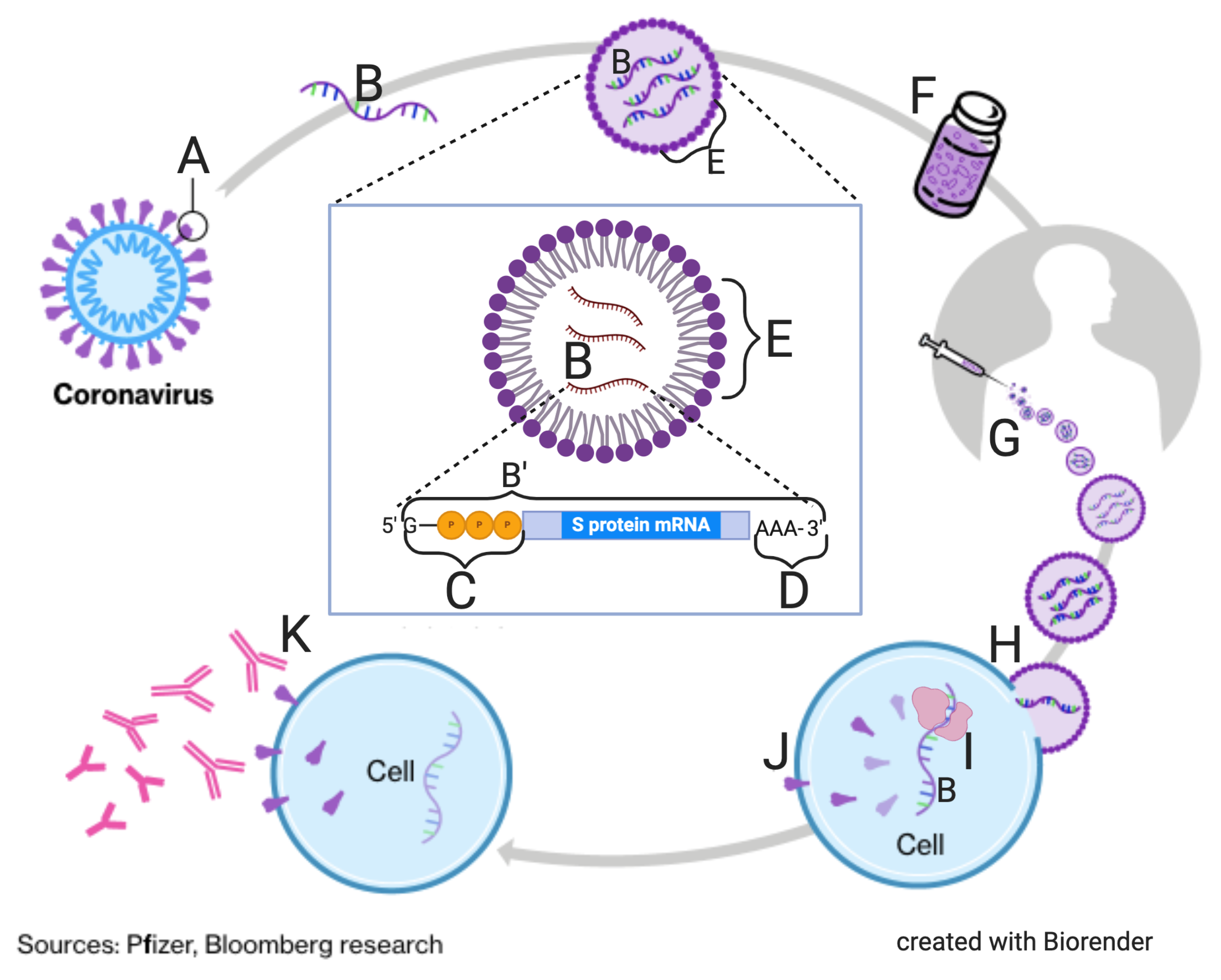
I’ve probably voiced this elsewhere, but I think it’s part of our mission as biology teachers to be promoting understanding of the novel coronavirus, and vaccines. I hope you’re on board with my battle against our common enemy Biology Confusion.
Finally, HHMI has an excellent 3 part animation about SARS-CoV-2.
Teaching about Bacterial Genetics and Operons
Once you’ve taught about viruses, you can move onto Bacterial Genetics and Operons. The relevant topics are spread out in the CED, but here’s a reasonable outline.
1. Sources of genetic diversity in bacteria
- mutation
- transformation (uptake of naked DNA),
- transduction (viral transmission of genetic information),
- conjugation (cell-to-cell transfer of DNA), and
- transposition (movement of DNA segments within and between DNA molecules) increase variation.
2. Operons, including
- Operon structure (regulatory genes, promoters, operators, structural genes).
- The role of regulatory molecules
- Lac operon
- Trp operon.
I also include CAP and positive gene regulation as an advanced topic.
While there’s nothing about operons that’s particularly difficult — it’s just one of many beautifully complex processes that we’re lucky enough to teach — there are a few things that are important to emphasize. One thing is what Sean Carroll in The Serengeti Rules calls double negative logic. In the lac operon, lactose shuts down a regulatory molecule, which otherwise would shut down the expression of the gene. The second thing is that the regulatory protein works through allosteric interaction with lactose. In fact, allosteric interactions, which you probably taught back in Unit 3 when you were teaching about enzymes, was actually discovered by Jacques Monod as he was figuring out how operons worked.
By the end of the tutorial, your students will be able to explain what’s happening in this diagram of the lac operon.
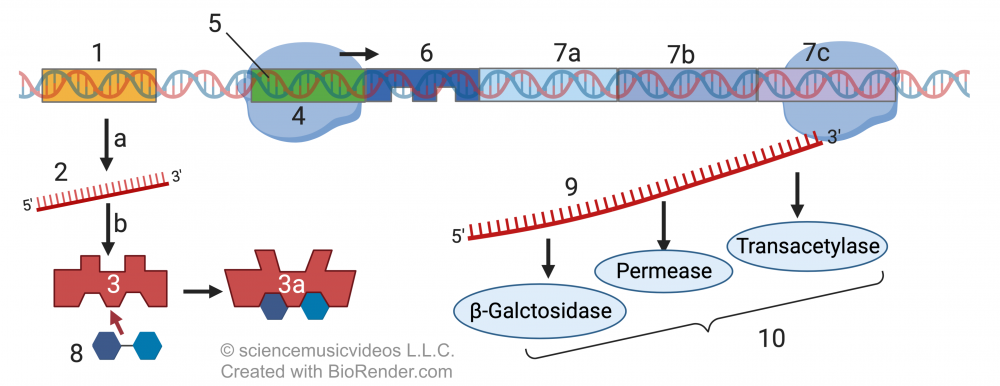
and this diagram of the trp operon
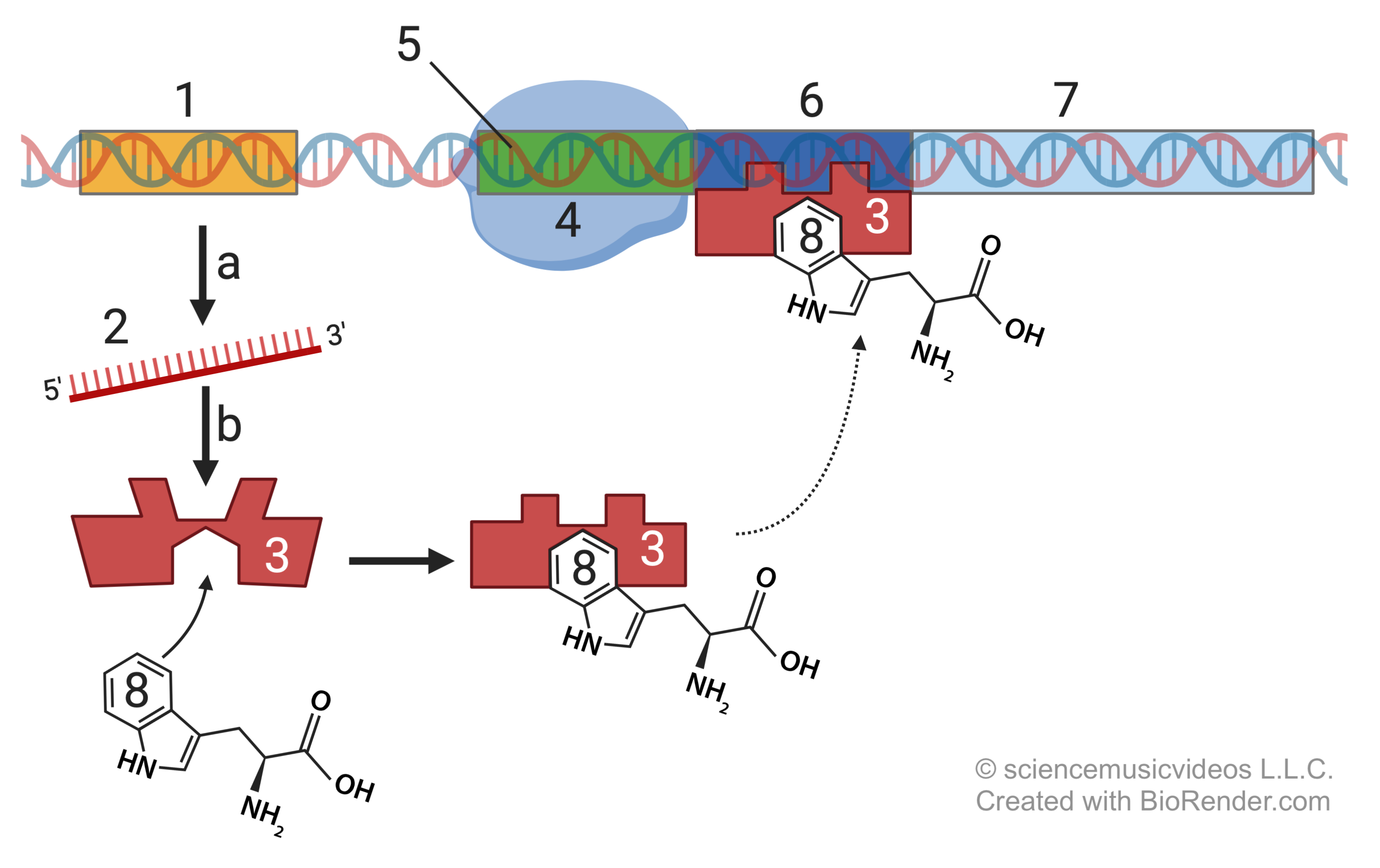
If you watch the accompanying video, you can hear me talk through the diagrams.
For an additional resource, I recommend Flinn’s POGIL about operons. It’s titled “Control of Gene Expression in Prokaryotes.”
Email 19 (sent January 3, 2021)
I hope you had a safe, restful, and restorative winter break.
I achieved a major milestone that I wanted to share with you (since it affects you as a sciencemusicvideos.com teacher). I finished the last tutorial on the site. If you look at the AP Biology Menu, you’ll see that every topic has a link. Our websites now have all the content your AP Biology students need to know. I’m still working on the last two student learning guides. Unless you’ve done an ecology first approach, I promise that I’ll have them way before you need them this spring.
Science in the News
I know that I find myself saying something about Covid-19 in nearly every one of these weekly emails that I’ve sent to you. But this pandemic is, tragically, the greatest teachable moment we’ve probably ever experienced as biology teachers. And because there’s so much misinformation, I think that it’s an important part of our mission as science educators to work together to vanquish our common enemy, Biology Confusion. That’s why I want to recommend Lawrence Wright’s history of the COVID-19 pandemic in the last issue of the New Yorker, It’ll walk you through all the heartbreaking mistakes that were made in our mismanagement of the pandemic (which seems to be continuing in our rollout of the vaccine). As biology teachers, this is a story we should all be able to tell.
My guess is that your students will be asking you about the new variant of the virus that’s emerged in Great Britain, and which has also appeared in the United States. You can learn more about its potential consequences in this article in the Atlantic. It’s super valuable in its discussion of exponential growth (which of course is already happening), and why a more infectious strain of SARS-CoV-2 could cause more death than a more severe variant could.
I hate recommending things that are behind a paywall, but I also want to recommend this Scientific American article: The Immune Havoc of COVID-19.
Finally, I want to remind you that I updated my virus tutorial so that it now includes a tutorial on SARS-CoV-2. Please let me know what you think.
Moving into Biotechnology
If it weren’t for the pandemic, I’d be spending about two weeks doing a series of biotechnology labs that are part of the AMGEN Biotechnology Experience. This is a series of labs that walks your students through:
- restriction digestion of plasmids
- gel electrophoresis
- bacterial transformation. This transformation is with a plasmid containing a gene for red fluorescent protein, and an arabinose-triggered operon. If you’ve done BioRad’s pGLO lab, this is very similar (and covers the same content).
Extensions allow you to do
- a ligation where you actually build the plasmid
- purification of gene product.
Amgen will train you for free, and then supply your school with all the needed supplies (consumables and hardware) for free. It’s amazing professional development for you, and a great lab experience for your students. I can’t recommend it highly enough.
Of course, we’re living through a pandemic, so this isn’t the year for taking your students through this great experience. Instead, what you can do is this:
- Show your students this video (it’s the one embedded above) that shows the steps of the lab (carried out by my colleagues at Berkeley High school), and the science of the lab (explained by me).
- Have your students complete some or all of the biotechnology tutorials on sciencemusicvideos.com.
College Board Biotechnology and Genetic Engineering Learning Objectives (Topic 6.8)
You’ll find that what’s on sciencemusicvideos.com more than covers what what the College Board, in their Course and Exam description, wants your students to know. Here’s a slightly edited version of these objectives.
-
LO IST-1.P: Explain the use of genetic engineering techniques in analyzing or manipulating DNA.
-
IST-1.P.1: Genetic engineering techniques can be used to analyze and manipulate DNA and RNA—
-
a. Electrophoresis separates molecules according to size and charge.
-
b. During polymerase chain reaction (PCR), DNA fragments are amplified.
-
c. Bacterial transformation introduces DNA into bacterial cells.
-
d. DNA sequencing determines the order of nucleotides in a DNA molecule.
-
Biotechnology and Genetic Engineering Tutorials on sciencemusicvideos.com
Here are the tutorials I’ve written to help your students master the key ideas and techniques of biotechnology.
Introduction to Genetic Engineering:
Teaches your students how restriction enzymes, DNA ligase, etc. can be used to create genetically engineered products such as insulin.
PCR
A very short tutorial about the polymerase chain reaction.
DNA Fingerprinting/Profiling
Teaches the basic principles of using restriction enzymes to create restriction fragments, which can then be sorted by size through electrophoresis. The tutorial continues to explain how DNA profiling can be done.
First Generation DNA Sequencing (Sanger Method)
Explains how DNA sequencing is done. If your students understand this, they will truly understand how to think critically on a molecular level about DNA and DNA replication.
CRISPR-CAS9
An introduction to this revolutionary gene editing system. Jennifer Doudna, who recently won the Nobel Prize for this work, lives in Berkeley. If you want your students to get to know her a bit better, you can show them this video of an interview I was able to do with her last year for a school fundraiser.
Help Me Meet My New Year’s Goals for 2021
I’ve set three goals for 2021, and I hope that you can help me meet them.
- EVERY TEACHER’S SUBSCRIPTION IS PAID FOR BY THEIR SCHOOL OR DISTRICT. Rationale: You don’t pay for your students’ textbooks, right? You shouldn’t have to pay for your subscription to our websites. How can you help? For your school to pay, you have to start working on that now. Most schools have budget processes where requests and purchase orders have to be processed way before the next school year. So please start talking to your department chair or administrators about how your school can pay for your next year’s subscription.
- The number of teachers with paid teacher licenses to sciencemusicvideos.com or learn-biology.com grows to 1000. Rationale: Right now, we have 164 paid accounts, and another 169 using our websites on a free-trial basis. These teachers are serving about 9000 students. That means that there are about 240,000 AP Bio students and about 7000 AP Bio teachers who aren’t using our websites. How can you help? If you know of other teachers who would benefit from the interactive learning we provide, please spread the word!
- We get many more college faculty users. Rationale: In the same way as there are so many AP Bio students who could benefit from our interactive tutorials, there are also college students.How can you help? If you know of College-level instructors who would benefit from the interactive learning we provide, please spread the word! I’m particularly interested in serving teachers at community colleges.
Email 20 (sent January 10, 2021)
Teaching Eukaryotic Gene Regulation and Animal Development
If you’re following this scope and sequence, then you’re moving towards finishing unit 6 with two final topics: eukaryotic gene regulation and animal development. These are both difficult topics to teach. Please start by skimming over the College Board’s learning objectives. Note that “EU” is an enduring understanding, “LO” is a learning objective, and “IST” is information storage and transfer”
College Board Learning Objectives for Gene Expression and Animal Development (Topics 6.5 and 6.6).
If you like to consult the College Board’s learning objectives before planning instruction, here they are.
Topic 6.5: Regulation of Gene Expression
- EU IST-2: Differences in the expression of genes account for some of the phenotypic differences between organisms.
- LO IST-2.A: Describe the types of interactions that regulate gene expression.
- IST-2.A.1: Regulatory sequences are stretches of DNA that interact with regulatory proteins to control transcription.
- IST-2.A.2: Epigenetic changes can affect gene expression through reversible modifications of DNA or histones.
- IST-2.A.3: The phenotype of a cell or organism is determined by the combination of genes that are expressed and the levels at which they are expressed—
- a. Observable cell differentiation results from the expression of genes for tissue-specific proteins.
- b. Induction of transcription factors during development results in sequential gene expression.
- LO IST-2.B: Explain how the location of regulatory sequences relates to their function.
- IST-2.B.1: Both prokaryotes and eukaryotes have groups of genes that are coordinately regulated—
- a. In prokaryotes, groups of genes called operons are transcribed in a single mRNA molecule. The lac operon is an example of an inducible system.
- b. In eukaryotes, groups of genes may be influenced by the same transcription factors to coordinately regulate expression.
- IST-2.B.1: Both prokaryotes and eukaryotes have groups of genes that are coordinately regulated—
Topic 6.6, Gene Expression and Cell Specialization
- EU IST-2: Differences in the expression of genes account for some of the phenotypic differences between organisms.
- LO IST-2.C: Explain how the binding of transcription factors to promoter regions affects gene expression and/or the phenotype of the organism.
- IST-2.C.1: Promoters are DNA sequences upstream of the transcription start site where RNA polymerase and transcription factors bind to initiate transcription.
- IST-2.C.2: Negative regulatory molecules inhibit gene expression by binding to DNA and blocking transcription.
- LO IST-2.D: Explain the connection between the regulation of gene expression and phenotypic differences in cells and organisms.
- IST-2.D.1: Gene regulation results in differential gene expression and influences cell products and function.
- IST-2.D.2: Certain small RNA molecules have roles in regulating gene expression
Through two modules on sciencemusicvideos.com and Learn-Biology.com, you can ensure that your students know what they need to know.
Eukaryotic Gene Regulation and Expression
This module starts with a tutorial about regulation of chromatin structure. The key thing I emphasize here is how most DNA in a cell is tightly wound up as heterochromatin, and not transcribed. A small proportion, by contrast, is euchromatin, which is available for transcription. These differences correspond to chemical modifications of either DNA or the histone proteins that package the DNA. A key diagram is this one. showing DNA methylation (6) and histone acetylation (7):
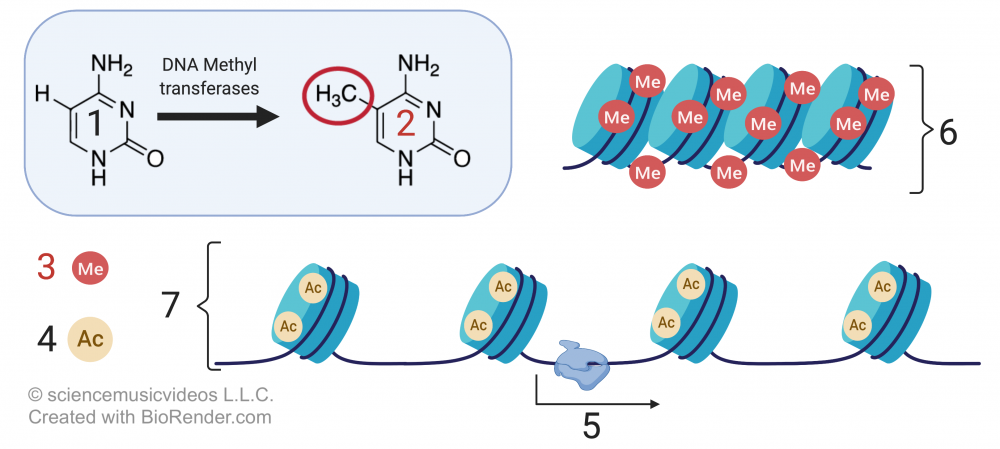
This can be pretty abstract unless you can fold it into a story…and fortunately, nature’s provided one. This is the story of X-chromosome inactivation, Barr Bodies, and how you can see that manifested in tortoiseshell cats.
By the end of the tutorial, your students will be able to explain diagrams like this, which show the random pattern of X inactivation and Barr body formation that occurs early in female embryonic development…
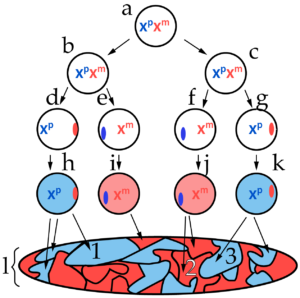
…which, with a bit of imagination, gets you to this:

That kind of modification of DNA is a huge chunk of what epigenetics is: how modifications to DNA that don’t affect sequence control gene expression. The mind-blowing stuff is the intergenerational transfer of these modifications that can occur. I cover this through an excerpt about the Dutch Hunger Winter, and its intergenerational legacy.
The second tutorial focuses on regulation of transcription. In other words, for that portion of DNA that is transcribable, what determines when it gets transcribed? This focuses on the role of regulatory sequences (at “a”) which interact with regulatory molecules (at “b”), leading to the formation of transcription initiation complexes (at “j”) that allow RNA polymerase to bind and transcribe DNA. These complexes look like this:
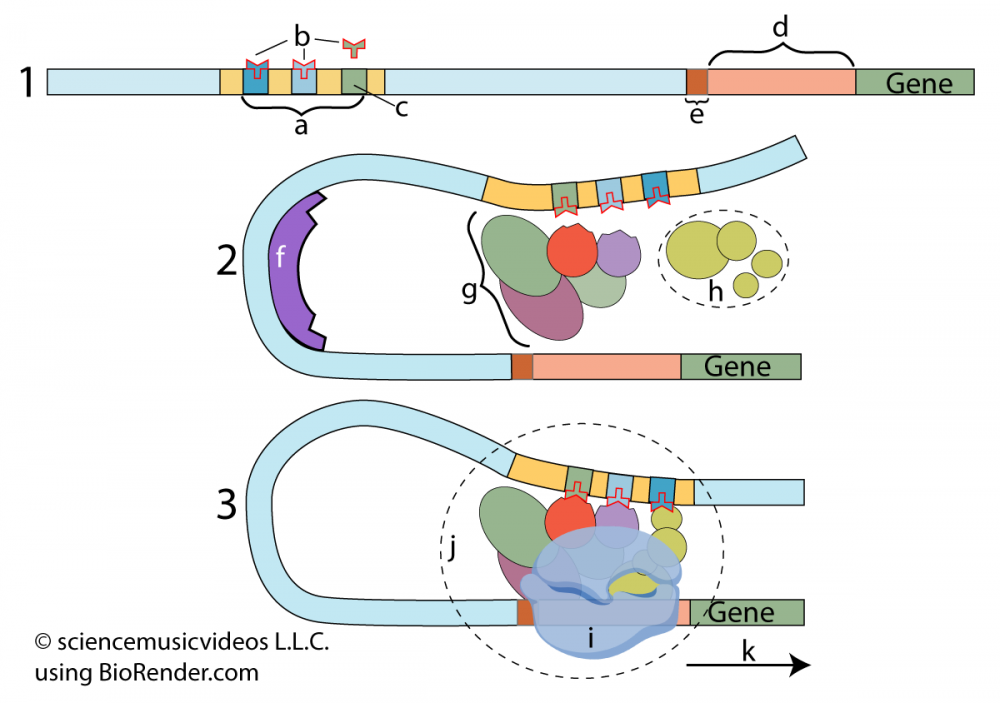
This is very complex material, which is why it’s important that students have lots of opportunity to interact with the material (which is, of course, why you’re sending your students to sciencemusicvideos.com).
Finally, there are post transcriptional modes of regulation and expression. This includes alternative splicing or exon shuffling, in which exons can be spliced together in different orders, essentially creating different proteins from the same RNA.
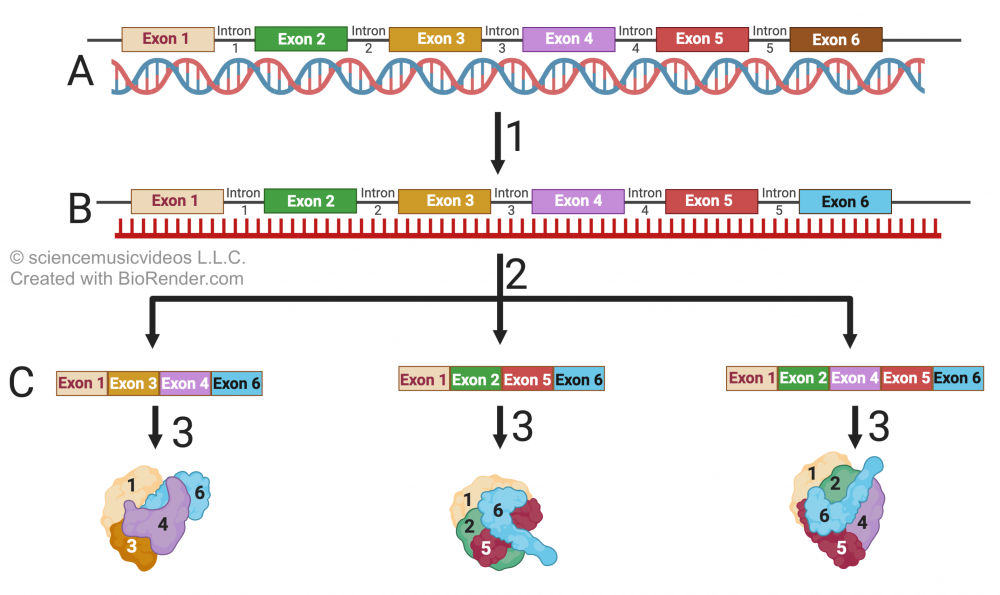
It also includes various small RNAs which interact with messenger RNA to either silence it altogether, or to interfere with its translation.
Animal Development and Cell Specialization
The second module tells one of the greatest stories in biology: how a fertilized egg develops into a complex, multicellular organism. I start by briefly introducing some of the key events in development: fertilization, cleavage, and gastrulation. These stages are not in the standards, but it felt impossible to teach the essential questions without describing the cell division, migration, and differentiation that happens during the beginning of any animal’s life. That provides context for some of the key questions we want our students to be focusing on:
1. how do cells know where to go?
2. How does a cell know what type of cell it should develop into?
The answer to these questions are astoundingly complex. By the end of the module, your students will be able to explain ideas like:
Genomic equivalence: all cells have the same DNA. They’re different because they express different genes
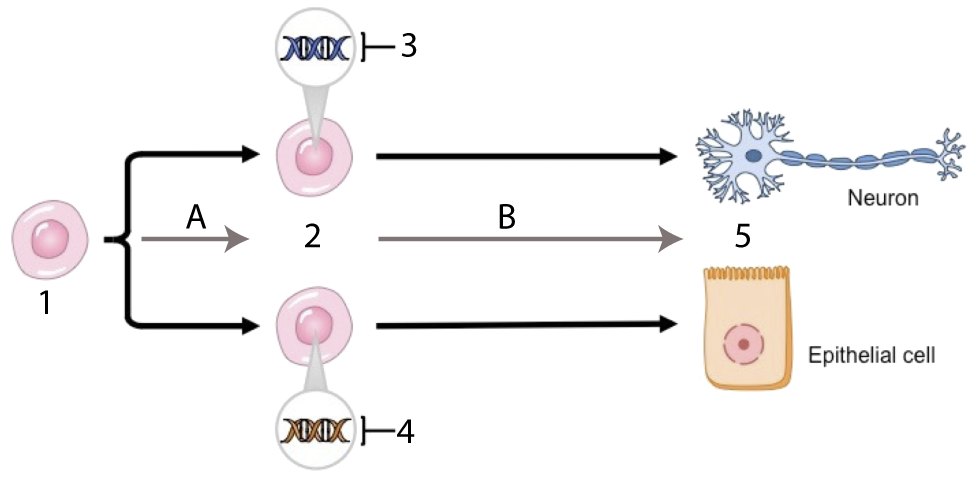
Induction: some cells release hormone-like molecules that activate specific genes in other cells.
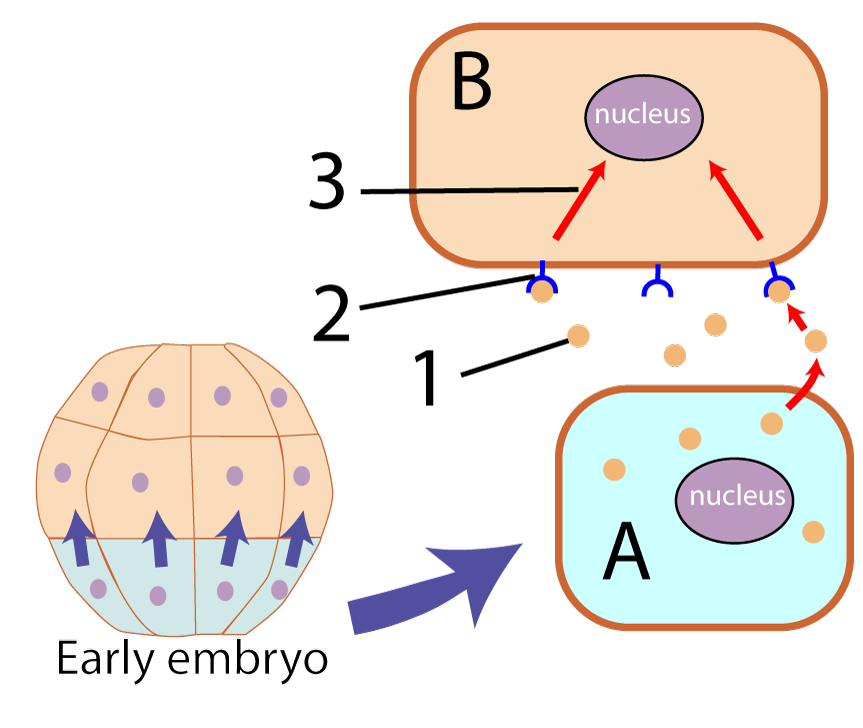
Apoptosis: timed programmed cell death is an essential part of the sculpting of form from an undifferentiated embryo
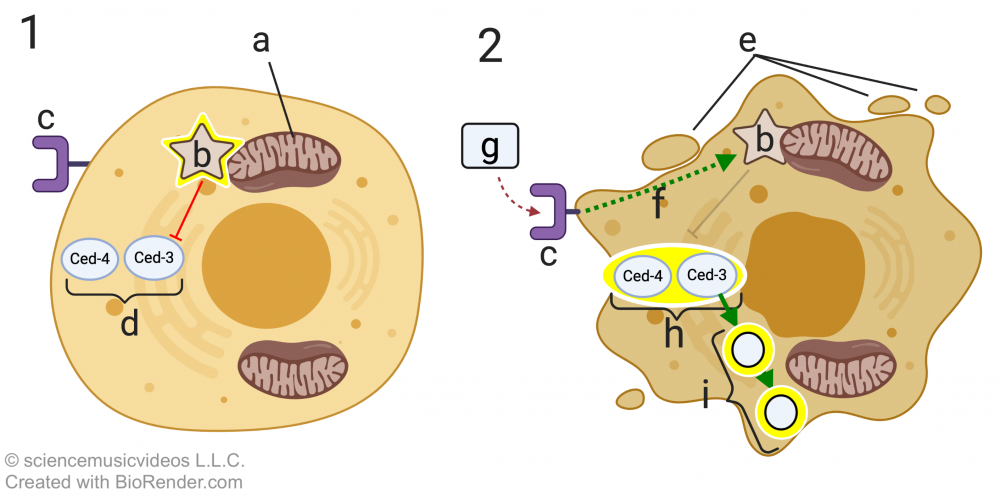
Homeotic genes: highly conserved genes that control the differentiation of body regions.
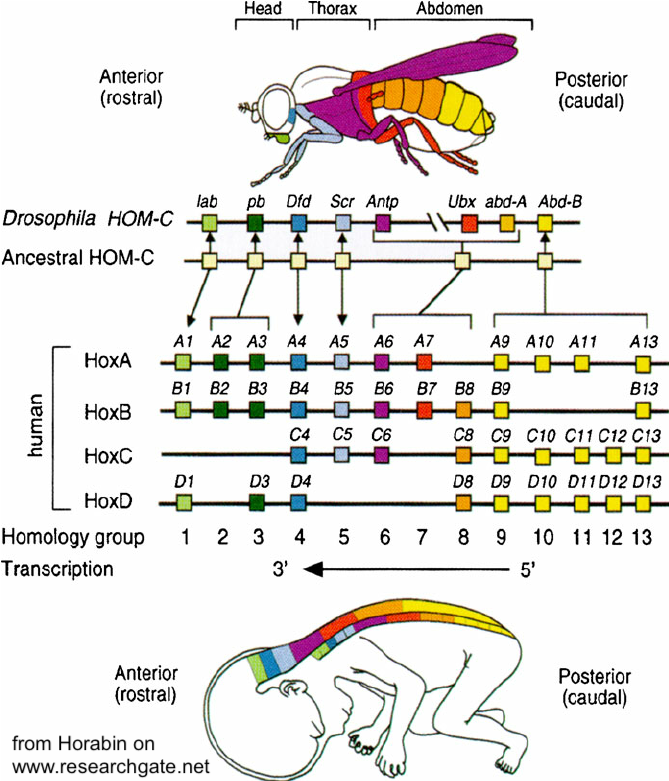
Other resources:
HHMI has a few spectacularly good activities related to the evolution and development of the three spined stickleback. Over and over again in the course of evolution, these fish, when confined to freshwater environments, have lost their pelvic spines.
Depending on how much time you have you can do an entire virtual lab (which takes several class periods) or watch a video and do one or multiple worksheets.
Go to https://www.biointeractive.org/classroom-resources, search for “stickleback” and you’ll have many choices. But at the very least, I hope you have your students watch the video, and do this worksheet.
Help me meet my goals for 2021
Here are my three goals for 2021.
- EVERY TEACHER’S SUBSCRIPTION IS PAID FOR BY THEIR SCHOOL OR DISTRICT.
- The number of teachers with paid teacher licenses to sciencemusicvideos.com or learn-biology.com grows to 1000.
- We get many more college faculty users.
This week, can you please help me with goal # 1? Just talk to whomever is in charge of purchasing for your department. Tell them how much your students are benefiting from using sciencemusicvideos.com. Ask them to set aside money in next year’s budget for your subscription. I know that this sounds ridiculously early, but many districts have deadlines in March for requests for the following school year. So please start the process now. We’re planning for a starting price of $199 for a single teacher license. Why pay that out of pocket when it’s something that should be paid for by your school?
Email 21 (sent on 1/17/21)
TOPIC: Meiosis
Meiosis is such a great topic. Here’s how my Meiosis song starts:
The sperm cells or egg cells performing the feat,
Of moving genes forward in eukaryotes like orchids and bees,Meiosis doesn’t happen in all cells of the body,
There’s just a few cells that have hobby,
I’m talking ’bout germ cells in testes and ovaries.Here’s a link to the video: it’s great for review, or even for a preview. You can show it at the start of the unit, accompanied by some big picture questions like:
- You inherit half of your genes from your mother and half from your father. Try to describe how you think that might work. Which half?
- If you have one, think of your sibling. If you don’t, think of any pair of siblings that you know. How genetically similar are siblings?
- Humans, like all sexually reproducing beings, expend a lot of energy trying to find mates and pass on their genes. Why do most multicellular eukaryotes reproduce sexually, instead of just cloning themselves?
Or you can show the video at the end of your unit for review.
Science in the News
- Human Nature: On Netflix, there’s a spectacularly good documentary about human genetic modification with CRISPR. It’s called Human Nature. It does a good job talking about the underlying science, and a great job talking about the ethical issues surrounding somatic and germline therapy. It’s 90 minutes long, and you might not want to take that much class time to show it now, but it might be great for extra credit or for after the AP Bio test. Of course, there are equity issues connected with assigning material on Netflix (which many folks don’t have access to), and please consider that.
- One of my science department colleagues at BHS shared a fantastic podcast about how mRNA vaccines work. It’s perfect for our students (and you’ll love it too). If you want an interactive accompaniment to this, you can steer your students toward my recently published tutorial about SARS-CoV-2, which includes a section about mRNA vaccines.
Are you using our Timed-Secure Quizzes?
Want to really boost achievement? Try our timed-secure quizzes. I’ve been releasing these on a pretty-much weekly basis. Here’s a link to the menu.
I find that they’re extremely useful to motivate my students to learn the material on schedule. They require a bit of set-up on your part (because they’re timed, you have to set a window in your “Manage Quizzes” page on qwizcards.com/login).
Because they’re secure, they’re only available to paid subscribers: please use this link to upgrade. Give them a try! Here’s a page that’ll show you how to set them up.
Teaching Meiosis
If you’re following this scope and sequence, then you’ve finished unit 6 (I do unit 6 before unit 5). That sets you up to start unit 5, Heredity. As the College Board suggests, I start with Meiosis (Topics 5.1 and 5.2) but then jump to Topic 5.6 (Chromosomal Inheritance). Next week, we’ll jump back to Mendelian and post-Mendelian genetics, which comes in between.
Stitching that all together, here are the College Board’s learning objectives for this unit. Note that “EU” is an enduring understanding, “LO” is a learning objective, “IST” is information storage and transfer,” and “SYI” is systems interactions.
College Board Learning Objectives for Meiosis
- TOPIC 5.1: Meiosis
- EU IST-1: Heritable information provides for continuity of life.
- LO IST-1.F: Explain how meiosis results in the transmission of chromosomes from one generation to the next.
- IST-1.F.1 Meiosis is a process that ensures the formation of haploid gamete cells in sexually reproducing diploid organisms—
- a. Meiosis results in daughter cells with half the number of chromosomes of the parent cell.
- b. Meiosis involves two rounds of a sequential series of steps (meiosis I and meiosis II).
- IST-1.F.1 Meiosis is a process that ensures the formation of haploid gamete cells in sexually reproducing diploid organisms—
- LO IST-1.G: Describe similarities and/ or differences between the phases and outcomes of mitosis and meiosis.
- IST-1.G.1: Mitosis and meiosis are similar in the way chromosomes segregate but differ in the number of cells produced and the genetic content of the daughter cells.
- TOPIC 5.2: Meiosis and Genetic Diversity
- EU IST-1: Heritable information provides for continuity of life.
- LO IST-1.H: Explain how the process of meiosis generates genetic diversity.
- IST-1.H.1: Separation of the homologous chromosomes in meiosis I ensures that each gamete receives a haploid (1n) set of chromosomes that comprises both maternal and paternal chromosomes.
- IST-1.H.2: During meiosis I, homologous chromatids exchange genetic material via a process called “crossing over” (recombination), which increases genetic diversity among the resultant gametes.
- IST-1.H.3: Sexual reproduction in eukaryotes involving gamete formation—including crossing over, the random assortment of chromosomes during meiosis, and subsequent fertilization of gametes—serves to increase variation.
- Exclusion: the details of sexual reproductive cycles in various plants and animals are outside the scope of the exam and course
- TOPIC 5.6: Chromosomal Inheritance
- EU SYI-3: Naturally occurring diversity among and between components within biological systems affects interactions with the environment.
- LO SYI-3.C: Explain how chromosomal inheritance generates genetic variation in sexual reproduction.
- SYI-3.C.1: Segregation, independent assortment of chromosomes, and fertilization result in genetic variation in populations.
- SYI-3.C.2: The chromosomal basis of inheritance provides an understanding of the pattern of transmission of genes from parent to offspring.
- SYI-3.C.3: Certain human genetic disorders can be attributed to the inheritance of a single affected or mutated allele or specific chromosomal changes, such as nondisjunction.
Meiosis and Chromosomal Variation tutorials on sciencemusicvideos.com
If you have your students complete our module about Meiosis on sciencemusicvideos.com (or Learn-Biology.com), you can ensure that your students will master all of these objectives . Your students can use this Meiosis Student Learning Guide to guide them through the materials.
1. Meiosis: Basic Concepts
This tutorial will teach your students the difference between haploid and diploid cells, and the meaning of the term homologous in the context of meiosis and chromosomes.
2. Meiosis 1 v. Meiosis 2
In this tutorial, your students will come to understand how meiosis, fertilization, and mitosis fit into the life cycle of sexually reproducing organisms, like us. This is captured in the diagram below.
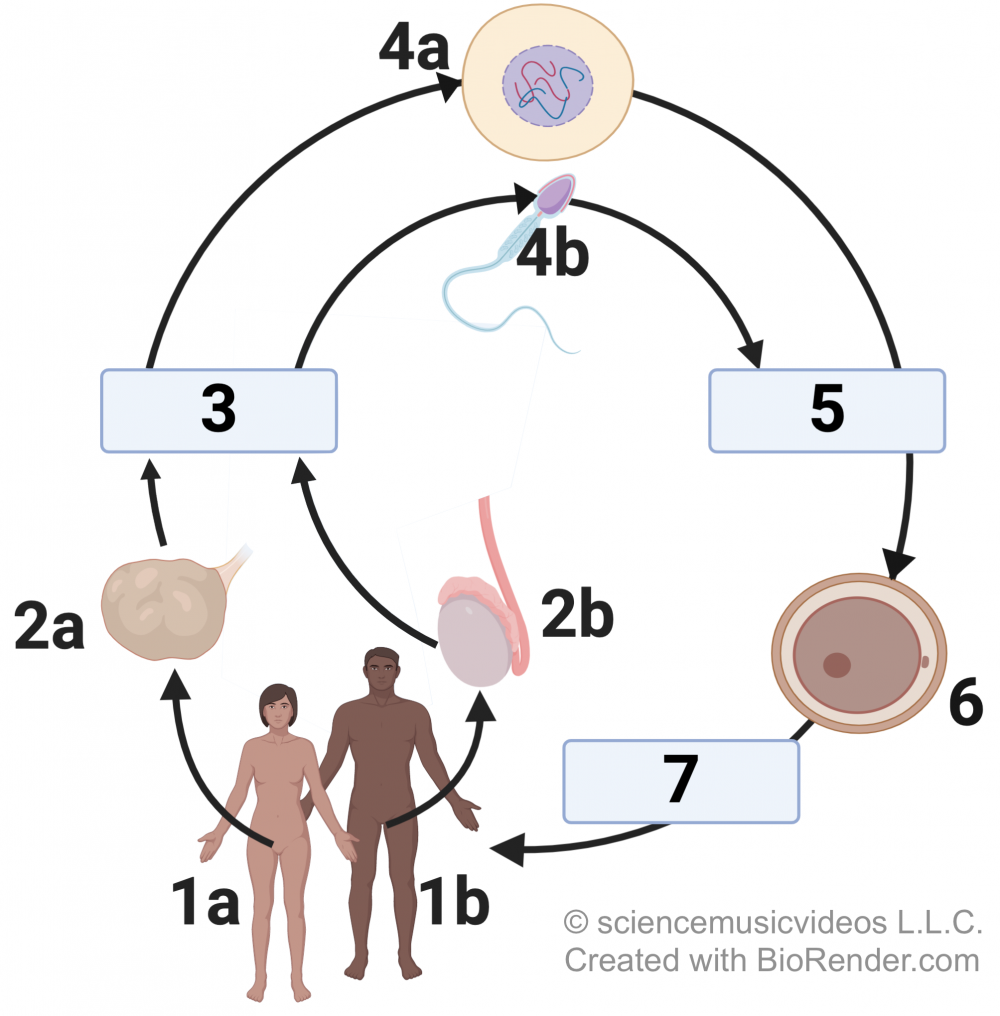
Students will also learn to distinguish between meiosis 1 and meiosis 2, and to be able to compare and contrast mitosis and meiosis, as shown in this diagram.
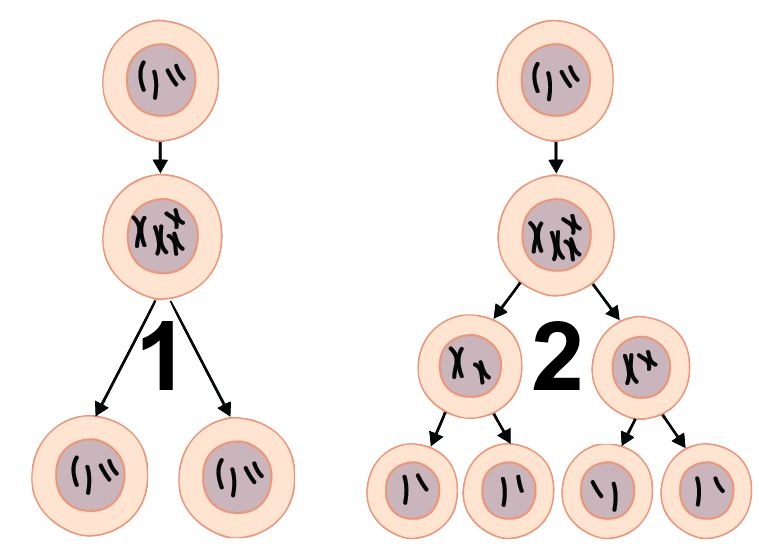
3. How Meiosis Creates Variation
Our third tutorial focuses on the two key processes by which meiosis creates variation: independent assortment of chromosomes, and crossing over, which creates newly recombinant chromosomes in every generation. By the end of this tutorial, your students will be able to talk, write and think their way through diagrams like this:
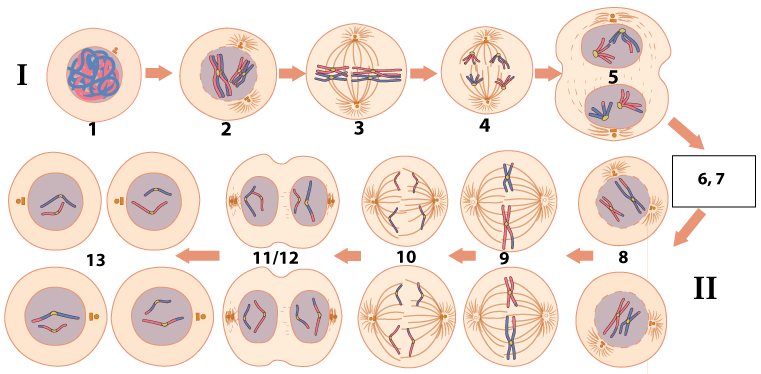
4. Sex Determination, Nondisjunction, and Human Chromosomal Variation
Meiosis explains some of the basic facts of life: like why births are approximately 50/50 male and female. This last tutorial takes on that topic, and also looks at nondisjunction and its consequences: Down Syndrome, Klinefelter Syndrome, XYY, and Turner Syndrome.
Other resources:
I’ve already shared my Meiosis Song above.
For a group activity, there’s a Meiosis POGIL, but it’s not in the AP set of POGILS: it’s in the high school set. You can buy POGILS from Flinn Scientific. Note that this is the only one from the high school set that I use, so you have to decide if it’s worth the investment (the AP Bio ones definitely are). Besides that, my recommendation is to move quickly through this material. Just make sure that your students understand meiosis (particularly crossing over and independent assortment) so that you can carve out time for genetics (which I’ll talk about next week).
Help me meet with goals for 2021
Here are my three goals for 2021.
- EVERY TEACHER’S SUBSCRIPTION IS PAID FOR BY THEIR SCHOOL OR DISTRICT.
- The number of teachers with paid teacher licenses to sciencemusicvideos.com or learn-biology.com grows to 1000.
- We get many more college faculty users.
Last week, I asked you to help me with goal # 1, and I’m going to repeat that this week.
I know that thinking about next year right now might seem inconceivable. But it’s possible that your District’s deadline for next year’s purchases is in March or April. So please talk to whomever is in charge of purchasing for your department. Tell them how much your students are benefiting from using sciencemusicvideos.com. Ask them to set aside money in next year’s budget for your subscription. We’re planning for a starting price of $199 for a single teacher license. Why pay that out of pocket when it’s something that should be paid for by your school?
Email 22 (sent 1/24/21)
Topic: Genetics
Hope you’re doing well.
If you’re following this AP Bio calendar/scope and sequence, you’re about one week away from starting your genetics unit. That’ll get you to the end of Unit 5. If, like me, you did unit 6 before unit 5, then by the middle of February, you’ll be 3/4 done with the course. Way to go! You’ll teach evolution ( big unit), ecology, and then review for the AP Bio exam.
Now is a really good time to think about pacing
I always try to end my course about two or three weeks before the test. I’ll talk a lot more about how to prepare your students for the test in upcoming emails. But just to preview the most important point: give your students plenty of time to review with questions from previous years’ released exams. On AP Classroom, you have access to three practice exams. At some point before the the actual test, your students should get a chance to answer and get feedback on each question on those tests.
If you have to choose between a couple of days of cramming in material and a couple of days of review, choose review. But as I said, more on that later. For now, just make sure that you end on time. I’m constantly telling my students: “you can be mad at me now for pushing you, but you’d really mad if you sat for the test and felt unprepared.”
Note: your district can apply to take the exam slightly later. We’re hoping our administration does that for our students….I’ll let you know what happens.
Science in the News
Teaching Genetics
College Board Learning Objectives for Meiosis
Here’s a link to the College Board’s learning objectives for all of Unit 5. Note that “EU” is an enduring understanding, “LO” is a learning objective, “IST” is information storage and transfer,” and “SYI” is systems interactions.
Scroll down a bit from the link and you’ll be at topic 5.3, Mendelian Genetics. The CB’s objectives are expansive, so here’s an abbreviated list.
- Topic 5.3: Mendelian Genetics
- Laws of segregation and independent assortment
- Rules of probability
- Solving monohybrid and dihybrid crosses
- Topic 5.4: Post Mendelian Genetics
- Linkage and recombination
- Sex linked genes
- Polygenic traits
- Non-nuclear inheritance (via mitochondria, chloroplasts, etc.)
- Topic 5.5: Environmental Effects on Phenotype
Genetics tutorials on sciencemusicvideos.com
Our websites, sciencemusicvideos.com and learn-biology.com, organize online learning about genetics into six tutorials.
Mendelian Genetics and Punnett Squares
Using the example of sickle cell anemia, this introductory tutorial will teach basic genetics vocabulary (dominant, recessive, phenotype, genotype, etc). It also walks your students through how to solve genetics problems using Punnett squares.
Solving ABO Blood Type inheritance problems
In this tutorial, I introduce the idea of codominance and multiple alleles. This topic is not explicitly in the standards, but how can you not teach about blood type?
Solving Genetic Problems involving sex linked alleles
This tutorial teaches about sex-linkage, focusing on hemophilia.
Dihybrid Crosses
After doing this tutorial, your students will know how to set up and solve dihybrid crosses.
Linkage and Recombination
Linked genes and determining recombination frequencies. Along the way, your student will get a deep understanding of how linkage is different from independent assortment.
How to do the χ2 (Chi Squared) Test
A step by step walk through everything your students need to understand in order to do chi square analysis of results from genetic crosses.
Other resources to fill in some gaps
Currently, my tutorials don’t cover mitochondrial inheritance, pedigree analysis, probability, or gene/environment interaction. You can find probability in this slideshow, which you can also use to accompany the rest of your instruction through this unit. You’ll see that this slideshow is more detailed than usual, mostly because I didn’t have time to edit it down (and thought that if you had more contact time that I do, it might be useful for you). I’ll put a slide or two about mitochondrial inheritance in my next slideshow (which isn’t online yet).
For environmental effects on phenotype, you mostly just need to tell students that genes don’t singlehandedly determine phenotype. A seed grown in poor soil won’t grow as well as one planted in fertile soil. A great illustrative example (which I do cover in my tutorial about sex determination in my meiosis module) is how sex in certain reptile clades is determined by incubation temperature. That same tutorial also teaches students about the ZZ, ZW system of sex determination found in birds.
To fill the gap in pedigree analysis, here’s a good worksheet that I’ve been developing over the years. Here’s the key:
2. autosomal dominant
3. X-linked recessive
4. autosomal recessive
5. autosomal dominant
Last page:
1. autosomal dominant
2. sex linked recessive
3. sex linked recessive
4. autosomal recessive.
Also, here’s a set of beginning level genetics problem sets that you can use to help your students master the material in the first four tutorials. Note that the last pages have all the solutions (I find that giving out the solutions makes instruction much easier and more successful).
Have you started working with your admin or department chair to get them to pick up the cost of next year’s license?
I know that thinking about next year right now might seem inconceivable. But it’s possible that your District’s deadline for next year’s purchases is in March or April. So please talk to whomever is in charge of purchasing for your department. Tell them how much your students are benefiting from using sciencemusicvideos.com. Ask them to set aside money in next year’s budget for your subscription.
We’re planning for a starting price of $199 for a single teacher license. Why pay that out of pocket when it’s something that should be paid for by your school?
Try our Timed-Secure Quizzes!
Want to really boost achievement? Try our timed-secure quizzes. I’ve been releasing these on a pretty-much weekly basis. Here’s a link to the menu.
I find that they’re extremely useful to motivate my students to learn the material on schedule. They require a bit of set-up on your part (because they’re timed, you have to set a window in your “Manage Quizzes” page on qwizcards.com/login).
Because they’re secure, they’re only available to paid subscribers: please use this link to upgrade. Give them a try! Here’s a page that’ll show you how to set them up.
Email 23 (sent on 1/31/21)
Topic: AP Bio Review
As I sat down to start this week’s email, I realized that last week I got a bit ahead of myself. I told you about my entire genetics unit. That means that if you’re following this AP Bio calendar/scope and sequence, you’ve finished the first half of your genetics unit, and you still have one week to go. If you want to see my advice about genetics from last week, you can do so by going to this page on sciencemusicvideos.com. There, you’ll also find some links to genetics problem sets and other resources. However, of you want to skip directly to sciencemusicvideos to see our six tutorials, go here.
Next week, I’ll introduce our next topic: population genetics.
Science in the News: Coronavirus variants
Viruses are replicating entities, and the instructions for their re-creation in each infection cycle is stored in their genes. Since viruses are genetic beings, it’s no surprise that their genomes should be mutating, and that those mutations should be subject to natural selection.
That’s exactly what’s happening with the new SARS-CoV-2 variants that are emerging. Understanding the evolutionary origins and spread of these variants will be a useful stepping stone that you’ll be able to refer to over and over again when you get to unit 7 (evolution). In terms of population genetics, certain alleles are increasing in frequency in the viral gene pool. Why? Because of natural selection. What does this look like over time? You can trace it in a phylogenetic tree. The very existence of variants and their spread is evidence for evolution that we’re seeing in real time.
For some background about these variants, take a look at these two resources:
- This article by Beth Mole in Arstechnica gives an overview of all of emerging variants.
- This article by Jonathan Corum and Carl Zimmer in the January 18th edition of the NY TImes, focuses on the B.1.1.7. variant in England. With its incredible visuals, I can’t recommend this article strongly enough.
Some more ideas — and resources — for AP Exam review.
I know that the AP exam might still feel like it’s way in the distance. But you should start penciling in your AP exam review plan now. I always try to end my course with about three weeks to do nothing but review. On AP Classroom, in the question bank, you can find three full practice exams, each with an MC and and FRQ section. If you figure that each exam takes 3 hours, than it would be 9 hours just to give those three exams. But you don’t want to just give those exams: you want to be able to go over them, and to give your students a chance to reflect on their answers. That could be another 5 hours just to do that. That’s 14 hours. For most teachers, that’s about 3 weeks of class time right there.
Of course, you can assign that material in a whole bunch of ways, and that includes having students complete these exams for homework. But these tests are hard, and however you assign them, they’re going to take a lot of time to go over. And, on top of that, reviewing with those three exams isn’t a ceiling. I’d regard it as a minimum.
And that leads to my # 1 principle for AP exam review. Your first priority is to have your students take every released exam question that you can expose them too. That includes both FRQs and MC questions. There’s simply no substitute for the complexity and rigor of the materials that the college board puts on their actual tests.
Introducing Biomania: the AP Bio exam preparation system
In addition, I want to encourage you to use some of the material we’ve developed in our AP exam review system, Biomania.
What is Biomania? It’s three big practice tests that your students can take on our websites, or, with an upgrade, on their phones in our Biomania Phone App. These tests include
-
AP Biology FRQ Review: over 100 interactive short answer questions.
-
AP Biology Review Flashcards: more than 300 flashcards.
-
AP Biology Multiple Choice Review: over 270 interactive M.C. Questions.
All of these questions are aligned to the 2019 course redesign. In addition, the flashcards are all labeled as high, medium, or low AP exam relevance in order to give your students further guidance about how to focus their efforts.
I have my students use Biomania prior to hitting the College Board’s material. Biomania gets their content knowledge up to a very high level. This sets them up for success on the College Board’s materials. And that sets them up for success on the AP exam.
Next week, I’ll tell you how you can increase student study time for the AP exam by having your students access our Biomania phone app. But for now, just set some time aside in the next few days to look at our flashcards, FRQs, and MC questions. As you do, think about how you might work these into your AP Bio exam study plan.
Email 24 (sent on 2/1/21)
I hope you’re doing well!
This is weekly email 24 of the 2020-21 school year. If you’ve been following this AP Bio calendar/scope and sequence, then you’ve reached an important milestone. Congratulations! It’s time to start unit 7.
In this week’s email I’ll share with you:
- A newly understood adaptation that you can use as an illustrative example when talking about evolution and natural selection.
- A guided tour to the College Board’s learning objectives for topics 7.1 – 7.5 (Natural Selection and Population Genetics).
- Links so you can see how material is covered on sciencemusicvideos.com and learn-biology.com.
- Additional teaching resources.
Science in the News
The New York Times, in its Trilobites column, reported on an adaptation in lizards on Japanese Islands. The lizard is the five-lined skink. It lives on a cluster of volcanic islands southeast of Tokyo. Some of those islands are inhabited by snakes, and others are snake-free. The lizards on the islands with snakes have body temperatures that are, on average, 2.9 degrees Celsius warmer than lizards on snake-free islands. Those lizards on islands with snakes also have longer legs. The overall effect: “At these higher body temperatures, the lizards sprinted faster than the snakes could crawl.”
This example of snake-driven evolution makes me think of one of the best biology-related books that I’ve read in the past few years: Venomous by Christie Wilcox. Did you know that there’s a theory that a major driver of primate and human evolution was snake detection? Check out pages 33 – 36 of Wilcox’s fantastic book!
Guided learning objectives for Topics 7.1 through 7.5.
First, a note about the College Board’s title for Unit 7. It’s “Natural Selection.” That’s way too narrow. In fact, one of the major ideas of topics like population genetics and extinction is that not all evolutionary change is selective. There’s a big dose of randomness, which is what genetic drift is all about. There’s also a big does of contingency in evolutionary history. Who dies in a mass extinction is at least partly about being in the wrong place at the wrong time. The survivors (like our mammalian ancestors who survived that asteroid impact that ended the reign of the dinosaurs 65 million years ago) were often just lucky. Remember to emphasize both ideas to your students.
Topic 7 is a big chunk of our AP Biology course, and the Course and Exam description allots Topic 7 more class periods and a higher AP exam weighting than any other unit. It’s also, to my mind, the apex of our course: it brings together what you’ve previously taught in every other unit, and it sets the stage for ecology. The College Board suggests about 20 – 23 class periods, and I think that’s about right.
However, I make two modifications to the CB sequence that lets me cut this down by a few days. First, I start off the year teaching about natural selection and adaptation. Why? Well, if you agree with Dobzhansky that “nothing in biology makes sense except in the light of evolution,” then you need to teach natural selection and adaptation right at the start of your course Otherwise, phenomena like the fit between enzymes and substrates won’t make sense. The same is true for the complementary match between receptors and ligands. In addition, teaching just a little bit about natural selection sets you up for teaching about heterozygote advantage when you teach about sickle cell disease in units 5 and 6. If you didn’t do so this year, consider a day or two about natural selection at the start of 2021-22.
Secondly, I love teaching about the origin of life. But this year, knowing I’d be totally pressed for time, I had my students complete my Origin of Life tutorial over Winter Break. I will, however, talk about teaching about the origin of life in the email I’ll send to you in two or three weeks (toward the end of February).
That having been said, let’s look at the objectives for the few first topics in this unit: Natural and Artificial selection, and Population Genetics. The College Board’s original objectives are extensive. Here’s a condensed and guided version of what you need to cover.
Topic 7.1: Introduction to Natural Selection
- What adaptations are.
- How the mutations that lead to adaptation are themselves random. The non-random part of natural selection is the selection part. If it weren’t for mutation, all that selection could do would be to cull the population of less adaptive phenotypes. Mutation is what makes the process of natural selection creative and open-ended.
- How natural selection works: The philosopher Daniel Dennett called natural selection “the best idea anybody ever had…It unites the two most disparate features of all of reality. On the one side purposeless matter and motion…on the other side meaning, purpose,and design.”
If your students can recall and apply what follows, you’ve achieved success: inherited variation, followed by selection for beneficial traits and against harmful traits, shifts the average phenotype in a population, leading to adaptation. - Defining evolutionary fitness as reproductive success.
Topics 7.2 and 7.3: Natural Selection and Artificial Selection
- How artificial selection works. Though the CED lists natural selection before artificial selection, I teach artificial selection first. It’s concrete and easy to understand. For most students, understanding how selective breeding enabled dog breeders to create various breeds of dogs, or how plant breeders were able to convert wild Brassica oleracea into cultivated varieties like broccoli, cauliflower, cabbage, brussel sprouts, etc., is pretty straightforward. In fact, a great lecture prop (whether in person or online) is to have examples of each of these vegetables to show to your students. But if you can’t you can use this image from my website.
- Selection acts on phenotypes. The result of selection (artificial or natural) is a shift in allele frequencies. But what’s being selected are phenotypes. When you use illustrative examples like the peppered moth or the rock pocket mouse, you can talk to your students about how birds (in both cases) are selecting against poorly camouflaged individuals. When they eat those individuals, they’re (literally) eating the genes for poor camouflage, which increases the frequency of the alleles for good camouflage.
- As environments change, so do selective pressures. A great example of this is rapid evolution of beak depth observed in the the Galapagos finches on Daphne Major in the Galapagos Islands, as famously studied by Peter and Rosemary Grant. The Grants were able to track yearly shifts in the mean phenotype of the medium ground finch in response the amount of rainfall on the island, which changed the type of vegetation. This is all covered in HHMI’s video about finch evolution, which you can access at https://www.biointeractive.org/classroom-resources/origin-species-beak-finch. For a summer read, you can also read The Beak of the Finch, by Jonathan Weiner.
Topics 7.4 and 7.6: Population Genetics and Hardy Weinberg
- The key idea here is captured by the enduring understanding “Evolution is characterized by a change in the genetic makeup of a population over time.” This involves a few related ides:
- Gene pools
- Allele frequencyIt also involves fighting a big point of confusion: The terms “dominant” and “recessive” have nothing to do with “common” and “rare.” If your students are like mine, there are always a few students who will ask something like “If dominant alleles are dominant, then why doesn’t everyone in a population have that allele?” Those students are often my most confident students…and my guess is that most students naively come into a population genetics unit with some version of this incorrect idea in their minds.This is a deeply rooted misconception that I’ve been battling against for years. Overcoming it involves showing students that the meaning of the term “dominant” in “dominant” allele doesn’t make that allele like a dominant army that will conquer all else in its path, and spread like a virus. Ultimately, you want your students to understand that the frequency of an allele has to do with the phenotype that it codes for, and whether that phenotype is harmful or beneficial.
- Once you’ve taught about gene pools and allele frequency, you can go on to teach how to calculate allele frequencies. You can do that through counting (as in the exercises in this tutorial) and through the Hardy Weinberg equations:p + q = 1, and
p2 + 2pq +q2 = 1If you’re a gifted math instructor, you can teach students how to manipulate those equations. If (like me) you’re not, you’ll want to consider adopting a trick I learned years ago, and use modified Punnett squares called “cross-multiplication tables.” Here’s what they look like:A (0.3) a (0.7) A (0.3) AA (0.09) Aa (0.21) a (0.7) Aa (0.21) aa (0.49) Note how if you know the proportion of recessives in a population (aa, above), you can take the square root of that to figure out the frequency of the recessive allele. Since p + q = 1, subtracting the frequency of “q” from 1 gives you the frequency of the dominant allele. And from there you can figure everything else out. My tutorial on the Hardy-Weinberg equation will walk your students through this step by step.
- Once students know how to calculate allele frequencies, you can talk about changes in allele frequencies, which is what evolution is all about. That leads to teaching about the five conditions associated with Hardy Weinberg equilibrium.
- And once that’s secure, you can teach about the conditions that lead to evolutionary change. These are all violations of the various Hardy-Weinberg conditions
- Violate large population size, and you have genetic drift, shown either by population bottlenecks, or by the founder effect.
- Violate isolation, and you have gene flow.
- Violate no net mutation, and you have alleles changing frequency as they mutate from one form to another.
- Violate random mating, and you have evolution caused by sexual selection or assortative mating.
- Violate no harmful or beneficial alleles, and you have evolution caused by natural selection.
And that’s it for Topics 7.1 to 7.5.
Natural Selection and Population Genetics tutorials
Here’s a list of tutorials which cover all of the objectives above at sciencemusicvideos.com. If you’re using Learn-Biology.com, you can access the exact same tutorials here.
Here’s the associated student learning guide for this unit: Adaptation, Artificial and Natural Selection, Population Genetics Student Learning Guide
-
Thinking Like Darwin: Adaptation, Artificial Selection, and Natural Selection
-
Alleles in Gene Pools
-
Understanding Allele Frequencies in Gene Pools
-
The Hardy-Weinberg Equation
-
The Hardy Weinberg Principle
-
Natural Selection in Gene Pools
-
Why Harmful Recessive Alleles Don’t Disappear
-
Mutation in Gene Pools, and Heterozygote Advantage
-
Genetic drift (founder effect, bottleneck effect)
-
Population Genetics Cumulative Quiz
Additional Resources
The folks at Flinn have provided two POGILs that relate to the material above.
- Selection and Speciation
- Hardy Weinberg
I mentioned above HHMI’s Biointeractive about The Galapagos Finches. When I show that video, I also use this student guide (a google doc version of their PDF, with some of their instructor resources thrown in). Here’s the teacher’s guide (with the answers).
Since mutation is one of the violations of Hardy-Weinberg equilibrium, this unit is a great time to review it. If you need to, you can use Flinn’s POGIL on mutation, or HHMI’s great handout about Mutations and M1CR Signalling in the Rock Pocket Mouse. That handout let’s you review natural selection, mutation, and cell signaling in one activity. Highly recommended.
Email 25 (sent on 02/14/21): Evidence for Evolution
This is weekly email 25 of the 2020-21 school year. If you’ve been following this AP Bio calendar/scope and sequence, then you’re moving towards teaching about the evidence for evolution.
In this week’s email I’ll share with you:
- A Valentine’s-day-themed piece of science in the news.
- A guided tour to the College Board’s learning objectives for topics 7.6 – 7.8 (Evidence for Evolution).
- An overview of how this material is covered on sciencemusicvideos.com and learn-biology.com.
- Additional teaching resources.
Science in the News
Okay. I said that this would have a Valentine’s Day theme. But don’t try this at home. The New York Times, in its Trilobites column, reported on a monogamous species of cockroaches that “complete their bond by gnawing off each other’s wings.” While you (and your students) will have a great time reading this article in the Times, you can also dig deeper and read the original research article in Ethology.
Articles like this are a great way to deepen your students’ ability to think biologically. One easy way to do this is to have your students think about this in terms of the four themes of biology. While the College Board has backed away (a bit) from this framework, it’s a great thinking tool. For example, you can ask your students questions like “what’s the evolutionary basis of this behavior?” How are matter and energy flow involved? Where to you see information flow? Systems interactions?
Teaching Evidence for Evolution: some initial thoughts
Teaching about the evidence for evolution is a key part of our struggle against our common enemy, Biology Confusion. Creationism is widespread throughout the United States. Exactly how widespread is hard to know. It depends a lot on how people are asked about their beliefs. You can read more about that in this article in Scientific American.
Having said that, I need to confess that I have it easy when it comes to teaching about the evidence for evolution. I live and teach in Berkeley, California, a very liberal college town. There’s no pushback when I teach this topic.
I understand that’s quite different from the situation you might be in. And because the vast majority of my teaching career has been in two liberal areas (I taught in the Portland, Oregon suburbs before moving down the the Bay area) I don’t have experience about how to teach about this topic to students who might reject these ideas. If you have techniques that work in this situation, then please share them with me, and I’ll put them in my next email. Thanks!
To support your efforts to teach this topic, our module on evidence for evolution goes into a lot of detail. We offer our tutorials, followed by a comprehensive quiz. Let me walk you through the College Board’s objectives for this topic first, and then I’ll tell you about our tutorials.
A summary of the College Board’s objectives
The College Board’s Course and Exam Description divides the teaching of evidence for evolution into three topics. Click here to read these in my annotated quick guide to the CED.
Evidence of evolution (Topic 7.6) looks at
- Fossil evidence and radioactive dating of fossils.
- Morphological homologies and vestigial structures,
- Molecular homologies (homologies based on nucleotide and amino acid sequences)
- Cellular homologies
Common Ancestry (Topic 7.7) looks at
- Deep molecular homologies shared by all organisms (DNA, RNA, ribosomes, the genetic code, and shared metabolic pathways)
- Cellular and genetic homologies that are shared by all eukaryotes (membrane bound organelles, linear chromosomes, and genes with introns)
Continuing evolution (Topic 7.8) looks at evidence showing how life continues to evolve
- Populations continue to evolve
- Species continue to evolve, as shown by
- genomic changes
- changes in the fossil record
- evolution of resistance to antibiotics, pesticides, herbicides, etc.
- Emerging pathogens
Teaching Evidence for Evolution on sciencemusicvideos.com or Learn-Biology.com
Here’s how you can use the four tutorials on sciencemusicvideos.com and Learn-Biology.com to cover the objectives listed above (and go quite a ways beyond them). Note that the sequence of ideas below is different from what the College Board suggests. As I hope you’ll agree, the sequence below makes more pedagogical and biological sense. In any case, completing our tutorials will ensure that your students will achieve all of the CB objectives…and deepen their biological thinking skills along the way.
Tutorial 1: Evolution: Claims and Historical Observations
Our first tutorial starts by looking at the difference between a hypothesis and a theory. The goal here is to establish the importance of evolution, and to make sure that your students understand that when we say “theory of evolution,” we’re not talking about someone’s idea or opinion, but rather a “comprehensive explanation of some aspect of nature that is supported by a vast body of evidence” (US National Academy of Sciences).
Once that’s established, we look at the two claims that evolutionary theory makes. In other words, if evolution is true, then we should see:
- Descent with modification
- Change in a population’s genetic structure over time.
Do we see this? The tutorial ends with examples of evolutionary change that have been observed in recent times. The examples include
- Evolution of antibiotic and pesticide resistance in bacteria and insects, respectively
- Evolution of a new phenotype in the soapberry bug as it adapted to changes in its host species.
Both of these
Tutorial 2: Homologous and Vestigial structures
This tutorial starts by teaching about adaptive radiation. Why? Because when you think about it, adaptive radiation, on both a small and large scale, is the basis for homologous features. Think about the Galapagos Finches. Their divergent beaks are homologous: derived from a common ancestor, adapted to the different ecological niches into which each descendent species evolved. On a larger timescale, the same process underlies homologies like thislike this…
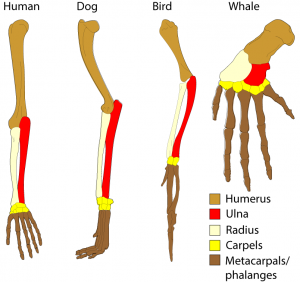
…as well as phenomena like the vestigial eyes in cavefish, the human coccyx, and the vestigial muscles that are connected to our ears, (but which most of us are unable to use to reposition our ears (like many of our mammalian cousins can).
Tutorial 3: The Fossil Record and Biogeographical Evidence
This tutorial covers two major areas:
- The fossil record
- What fossils are and how they form
- Relative and absolute dating of fossils
- How the fossil record serves as evidence of evolution.
- Biogeography and convergent evolution(Side note: Jerry Coyne, in his fabulous book Why Evolution is True, calls biogeography the piece of evidence for evolution that creationists have the most trouble with).This section of the tutorial will leave your students with a solid understanding of
- Biogeography and the pattern of life’s distribution on Earth
- Parallel evolution
- Convergent evolution and analogous traits
- The evolution of the unique biology of oceanic islands.
Tutorial 4: Embryological, Molecular, and Genetic Evidence
This tutorial covers additional lines of evidence for evolution (mostly covering material in topic 7.7). This includes
- Embryological evidence for evolution. Why do early embryonic forms of the animals in the same clade look so similar? Why do features like a post-anal tail arise in the ape clade (our clade) early in embryonic development, only to be reabsorbed later on (before birth)?
- What are molecular homologies, and how do they provide evidence of common ancestry and descent with modification?
- How can homologous and vestigial features be identified in genes?
- What are the deepest homologies that serve as evidence for a common ancestry of all living things?
Finally, the module ends with this cumulative Evidence for Evolution Cumulative Quiz.
Additional Resources
If you’re looking for a worksheet to either preview or consolidate the material in these tutorials, you can use the one on this page. Currently, I’ve only uploaded it in pdf format and Word format. If you’re in a jam, email me and I’ll convert it into a google doc for you.
The Youtube Channel “Stated Clearly” has a very solid evidence for evolution video. It’s about 14 minutes long. It might feel a bit elementary, but at the very least it’s a good introduction/summary.
If you have time, then the PBS evolution series has two great videos, both of which are available on YouTube. The only problem with these videos is that they’re long (2 hours and one hour respectively).
1. Darwin’s Dangerous Idea simultaneously recreates Darwin’s discovery of natural selection with evidence for evolution.
2. Great transformations looks at homology, working backwards from whales, to tetrapods, to homeotic genes
Email 26 (sent on 2/21/21): Speciation
This is weekly email 26 of the 2020-21 school year. If you’ve been following this AP Bio calendar/scope and sequence, then you’re about a week away from teaching about speciation.
In this week’s email I’ll share with you:
- Some science in the news.
- Teaching notes and learning objectives for topics 7.10- 7.12 (Species, Speciation, and Extinction).
- An overview of how this material is covered on sciencemusicvideos.com and learn-biology.com.
- Additional teaching resources.
Science in the News
- Song of the Dodo, about biodiversity and extinction
- The Reluctant Mr. Darwin, about Darwin’s long delay in publishing On the Origin of Species. It’s a fantastic intellectual history of how Darwin put together his ideas, his interaction with Alfred Wallace, and it has a great summary of natural selection.
- The Tangled Web, about Carl Woese, the discovery of the Archaea and the 3-domain system, and the vey complicated early evolution of life.
For this week, I want to encourage you to look at two pieces by Quammen about SARS-CoV-2, both of which would be completely appropriate readings for your students. The first is an opinion piece published on February 19. It’s entitled “And then the Gorillas Started Coughing.” It focuses on how SARS-CoV-2, which originated in animals before spilling over to humans, can also jump back to animals. That can represent a serious threat to our closest relatives, the great apes, all of whom are threatened or endangered. It can also make long-term management of the pandemic much more complex, with the virus jumping from humans, to animal populations, and then back. You might want to consider having your students read this when you get to community ecology at the end of the course.
In September of 2020, Quammen wrote The Pandemic, From the Virus’s Point of View. The title says it all. Having your students read this piece will reinforce that what we’re experiencing with this pandemic is evolution in real time. Note that Quammen wrote this piece before the emergence of SARS-CoV-2 variants. So an interesting assignment would be for you to have your students summarize the article, connect it to evolutionary biology, and then extend it by explaining the emergence of these variants. Let me know how it goes.
Teaching Evidence for Evolution: one teacher’s thoughts
Deacon Marc Schneider is a teacher in St. John Paul II High School in Tallahassee, Florida. He’s been using sciencemusicvideos.com since June of 2020.
Marc responded to my request about sharing ideas for teaching evidence for evolution with the following thoughts, which he’s graciously allowed me to share with you:
As a deacon in the Catholic church and teacher at a Catholic school [teaching evolution] is pretty easy. The church does not take an official position on Creationism or Evolution but allows each of the faithful to discern for themselves. The Church and Scripture does not teach how the world was created (except for one small matter) but why the world was created–“Out of God’s love for us”. The small matter is we are required to believe that God is the ultimate creator of all things and that the world evolved under the guidance of God and that each human has a soul independent of material formation. (It is from God). The way I explain it and teach it is evolution is a theory that, pretty much, is universally accepted. But, for example, at some moment Hydrogen, oxygen, carbon, and nitrogen, maybe even phosphorous and sulfur had to be created. The elements to sustain life as we know it. That, at the very least, is God creating. Even Stephen Hawking (atheist) in an interview with Ben Stein admitted a higher being (my words) had to exist….
At the end of the day I usually differentiate Darwinism from evolution. I describe [Darwin’s] tremendous contribution but point out he also had an atheist agenda (bias) to prove God played no part in it. Ironically his wife [a devout Christian] says he converted to Christianity on his deathbed (which other family members deny).
If anybody else ideas to share, please let me know.
Teaching notes and objectives for speciation and extinction
Before starting, a note about curriculum sequencing. The College Board’s course and exam description puts Phylogeny (topic 7.9) before speciation, extinction, and variations in populations (topics 7.10 – 7.12). I recommend doing phylogeny after speciation (because phylogeny is a consequence of species evolving over time, splitting into new descendant species). I’ll talk about phylogeny in next week’s email.
Speciation is not, in my experience, a particularly difficult topic for most students. The allopatric model of speciation is very easy to understand. Sympatric speciation that’s not based upon polyploidy (which is extremely common in plants) can be a bit harder for students to visualize (but I provide several examples in my tutorials). And reproductive isolating mechanisms are also straightforward.
What students can have a bit of trouble with is overcoming some naive biology preconceptions. For example, a lot of my students, over the years, don’t know that a taxon like “duck” is a family of species. Similarly, the distinction between a breed or a variety and a species is not an intuitive concept for many students. When I teach in person, I do an activity where I hand out copies of Peterson’s Field Guide to Western Birds, and I have my students look at the number of duck and songbird species we have in our local area. It’s eye-opening for a lot of students. I’m looking forward to doing it again next year…
The College Board’s Course and Exam Description divides the teaching of speciation and extinction into three topics. Click here to read these in their original wording in my annotated quick guide to the CED (the link takes you to the start of Unit 7: scroll down to get to Topic 7.10).
Here’s my brief outline and sequence for these topics.
- The biological species concept (what it is, and what its limits are)
- Prezygotic and postzygotic reproduction isolating mechanisms
- How speciation occurs
- allopatric speciation
- sympatric speciation
- ring species
- adaptive radiation.
- Extinction and mass extinction.
- background rates of extinction
- mass extinctions
- Extinction and biodiversity (how adaptive radiations follow mass extinctions).
Please note that there are a few topics that I don’t cover in my tutorials (so be sure, at some point, to teach them to your students)
- The pace of evolutionary change
- Punctuated equilibrium v. gradualism.
Note also that we return to to topic of extinction in the last topic in the curriculum, Disruptions to Ecosystems (Topic 8.7).
Teaching Species and Speciation on sciencemusicvideos.com or Learn-Biology.com
Here’s how you can use the five tutorials on sciencemusicvideos.com and Learn-Biology.com to cover the objectives listed above.
Tutorial 1. What is a species?
Covers the biological species concept, its limitations, and reproductive isolating mechanisms.
Tutorial 2. Allopatric speciation
Covers the process of allopatric speciation. I also discuss ring species like the California salamander Ensatina eschscholtzii .
Tutorial 3. Sympatric speciation
Explains how sympatric speciation occurs through polyploidy and allopolyploidy, sexual selection, disruptive selection, and microhabitat differentiation.
Tutorial 4. Adaptive Radiation
How one species can branch into an entire family of descendent species, with a particular focus on how this happens on island chains.
Tutorial 5. Extinction
Covers how species become extinct (the extinction vortex), background rates of extinction, mass extinctions, and the consequences of extinction.
Finally, the module ends with this Speciation and Extinction: Cumulative Quiz
Additional Resources
I’ve shared this previously: HHMI has a great Biointeractive video about the Galapagos finches and adaptive radiation. When I show that video, I also use this student guide (a google doc version of their PDF, with some of their instructor resources thrown in). Here’s the teacher’s guide (with the answers).
If you have access to Jstor you can download Peter Grant’s article about Galapagos Finch evolution in Scientific American. This is the paradigmatic example of adaptive radiation, discovered by none other than Darwin himself (though he famously didn’t understand what he had discovered until years after his discovery). Though written for the public, it’s a complex, detailed article, and it’ll be a great challenge for your students.
As a sneak preview of a fantastic activity about speciation and phylogeny that I’ll talk about next week, take a look at Using DNA to Explore Lizard Phylogeny. This activity is from HHMI. It goes with the video The Origin of Species: Lizards in an Evolutionary Tree. It’s a very rich activity, involving speciation, natural selection, sexual selection, convergent evolution, DNA sequencing and phylogeny, so start getting your head around it now so you’ll be ready when you get to it.
Email 27 (sent on 02/28/21): Phylogenetics and Classification
Greetings! This is weekly email 27 of the 2020-21 school year. If you’ve been following this AP Bio calendar/scope and sequence, then you’re about a week away from teaching about phylogenetics and classification.
In this week’s email I’ll share with you:
- Some science in the news.
- Teaching notes and learning objectives for topic 7.9 (Phylogenetics).
- An overview of how this material is covered on sciencemusicvideos.com and learn-biology.com.
- Additional teaching resources.
Science in the News
For this week, I want to encourage you (and your students) to read How the Johnson & Johnson Vaccine works. This was published on February 27 in the NY Times. It’s a spectacular review of so much of unit 6 (Gene Expression). It also gets into the immune response (which I REALLY wish was still a part of our curriculum).
One assignment that I’m thinking about for my own students is to use that article as a jumping off point for comparing how this vaccine (a modified adenovirus) compares with the mRNA vaccines by Pfizer and Moderna. For comparison, you can use section 8 of this tutorial on sciencemusicvideos.com
On another COVID-19 related note, you might want to consider reading Brooke Jarvis’s astonishing piece in the NY Times Magazine, What Can COVID-19 Teach us about the Mysteries of Smell. The special senses are not, of course, a part of our curriculum, but I guarantee that you’ll love this article. Also, it’s a sure thing that over the next few years that one of your students is going to ask you about the loss of smell connected to COVID-19. Read this article, and you’ll have something to say.
Teaching notes and objectives for Topic 7.9, Phylogeny
Here are the College Board’s objectives related to phylogeny:
- EU EVO-3: Life continues to evolve within a changing environment.
- LO EVO-3.B: Describe the types of evidence that can be used to infer an evolutionary relationship.
- EVO-3.B.1: Phylogenetic trees and cladograms show evolutionary relationships among lineages—
- a. Phylogenetic trees and cladograms both show relationships between lineages, but phylogenetic trees show the amount of change over time calibrated by fossils or a molecular clock.
- b. Traits that are either gained or lost during evolution can be used to construct phylogenetic trees and cladograms—
- i. Shared characters are present in more than one lineage.
- ii. Shared, derived characters indicate common ancestry and are informative for the construction of phylogenetic trees and cladograms.
- iii. The out-group represents the lineage that is least closely related to the remainder of the organisms in the phylogenetic tree or cladogram.
- c. Molecular data typically provide more accurate and reliable evidence than morphological traits in the construction of phylogenetic trees or cladograms.
- LO EVO-3.C: Explain how a phylogenetic tree and/or cladogram can be used to infer evolutionary relatedness
- EVO-3.C.1: Phylogenetic trees and cladograms can be used to illustrate speciation that has occurred. The nodes on a tree represent the most recent common ancestor of any two groups or lineages.
- EVO-3.C.2: Phylogenetic trees and cladograms can be constructed from morphological similarities of living or fossil species and from DNA and protein sequence similarities.
- EVO-3.C.3: Phylogenetic trees and cladograms represent hypotheses and are constantly being revised, based on evidence.
To break that down into something a bit more manageable, here’s what to focus on. Students should be able to
- Interpret evolutionary relationships based on phylogenetic trees. That includes
- being able to determine which clades are most closely related,
- being able to determine common ancestors.
- Construct phylogenetic trees based on data about shared characteristics.
The most important specialized vocabulary you’ll have to teach in this topic includes:
- Phylogenetic tree / cladogram
- clade
- shared derived character
- node
- lineage
- outgroup
- molecular clock
It’s useful if, going into this, your students have familiarity with the difference between homologous and analogous features.
Because I can’t imagine my students leaving my AP Biology course without knowing this, I also teach a bit about traditional classification. That includes binomial nomenclature and the basic classification categories for animals (kingdom, phylum, class, etc.)
Teaching phylogeny on sciencemusicvideos.com or Learn-Biology.com
Much earlier in the year, I introduced the MICE method for interactive learning. It’s a great formula for flipped learning, and I’ve found it to be particularly useful while I’ve been limited to remote teaching during the pandemic.
MICE stands for
- Motivation (getting students hooked, arousing curiosity, etc).
- Interaction (what students do on sciencemusicvideos.com or learn-biology.com)
- Checking for understanding (what you do with your students during your synchronous learning time).
- Extension (this includes labs, other interactive activities like HHMI or POGILs, or journal writing).
If you want to motivate you students to learn about phylogeny, take your students to nextstrain.org/sars-cov-2/. SARS-CoV-2, since its emergence, has been evolving in real time. Nextstrain analyzes SARS-CoV-2 sequences from labs around the world, and organizes them into phylogenies. You’ll be able to explore phylogenies like this one

You can show your students a movie showing how this phylogenetic tree grew over time, branching from common ancestors to descendants. And then you can follow that up by having your students consider questions like: how is a phylogenetic tree like this get put together? How does the program know who’s most closely related to whom?
Once you’ve got your students motivated, you can have them go to sciencemusivideos.com or learn-biology.com. The topic is captured in this one tutorial, which focuses on the following.
Sections 1 and 2. Phylogeny shows life’s branching pattern
This connects phylogenetic trees to the idea of adaptive radiation, using diagrams like this to introduce concepts like clade and node.
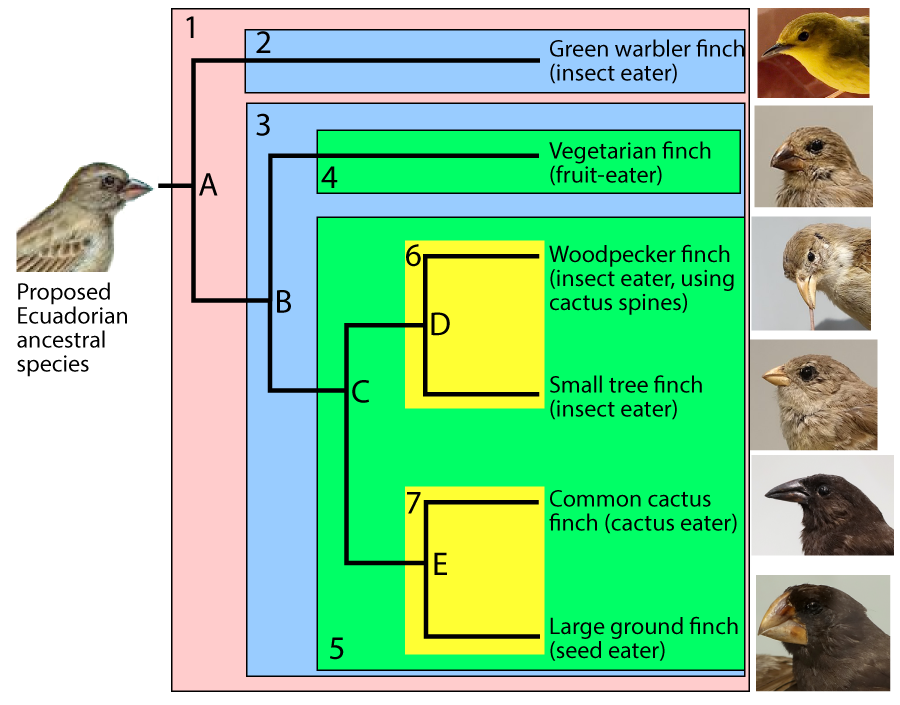
Sections 3 and 4: Naming and Classifying species.
Covers binomial nomenclature, and hierarchical classification categories, as shown below.
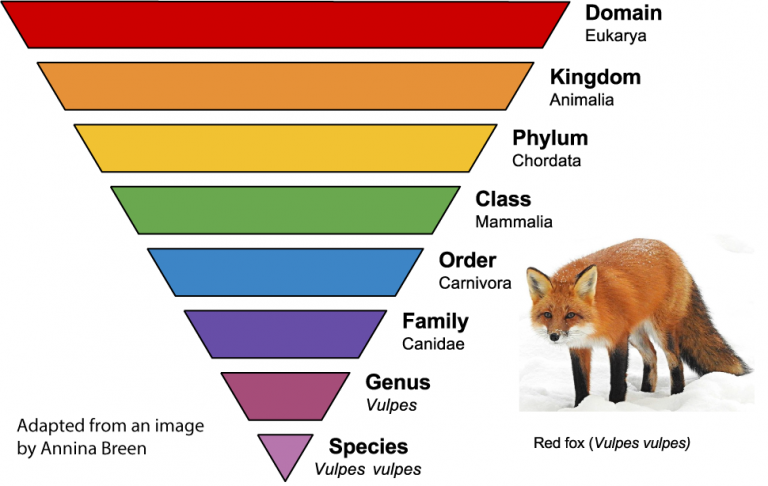
Section 5. How phylogeny and classification are (or should be) equivalent (but sometimes aren’t)
This introduces some of the complexities of interpreting phylogenetic trees. One goal of this section is communicating how the top to bottom (or left to right) order of clades in a phylogenetic tree might have nothing to do with relatedness. The two trees below, for example, are equivalent, and frogs are no more closely related to gorillas than they are to lizards (because frogs share their most recent common ancestor with both gorillas and lizards at node C).
In other words, this…
![]()
is equivalent to this:
![]()
I also introduce the idea of monophyletic, polyphyletic, and paraphyletic taxa. These terms don’t appear in the CED, but they’re incredibly useful.

Section 6: Using Character Tables to Create Phylogenetic Trees
Here’s a screenshot of the kind of exercise your students will do in this section as they learn to construct phylogenies.

Section 7: Molecular Clocks
This section covers how molecular clocks can be used to determine dates of common ancestry.
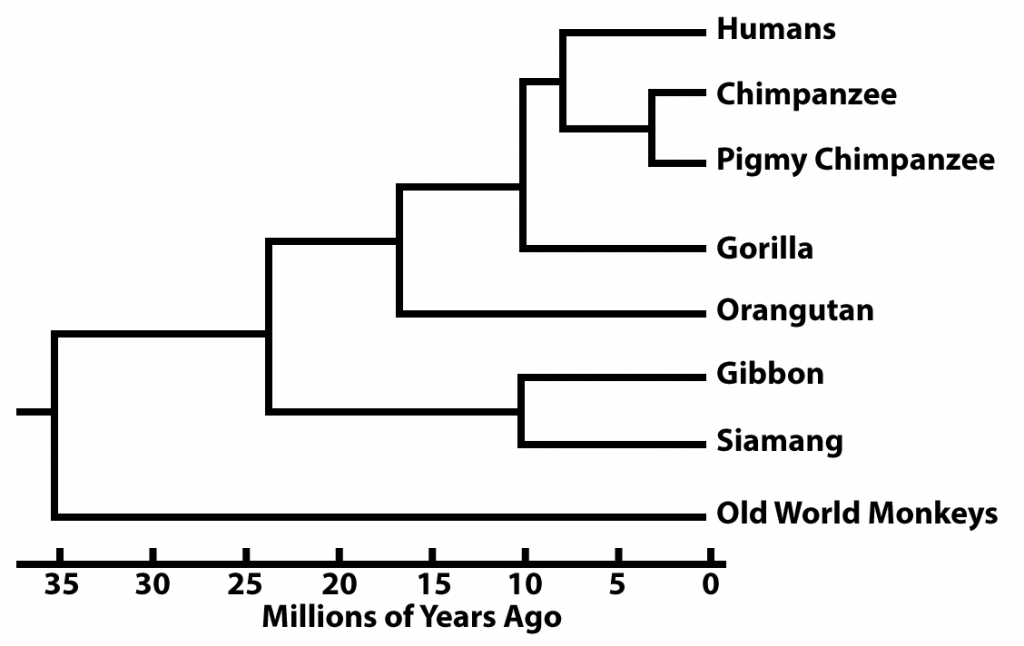
Section 8: How horizontal gene transfer makes the phylogeny of early life very complex.
Why life’s early phylogeny looks like this. It’s all about gene transfer (ongoing) and endosymbiosis.
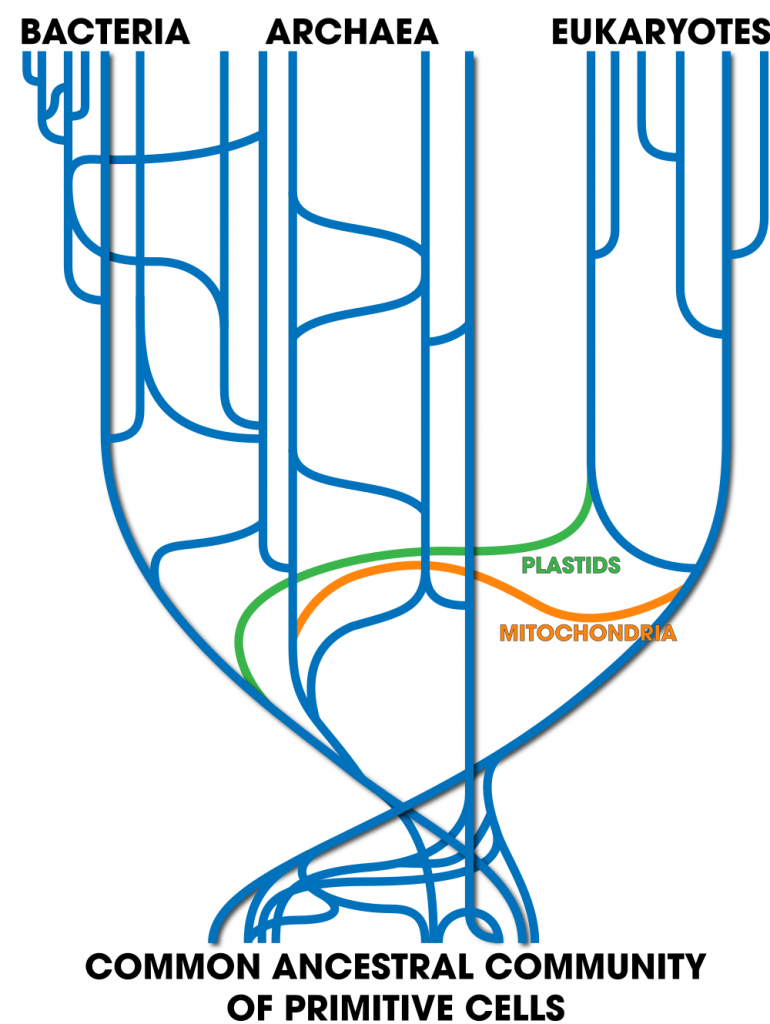
Additional Resources
HHMI has a fantastic activity about speciation and phylogeny. It’s called Using DNA to Explore Lizard Phylogeny. This activity is from HHMI. It goes with the video The Origin of Species: Lizards in an Evolutionary Tree. It’s a very rich activity, involving speciation, natural selection, sexual selection, convergent evolution, DNA sequencing and phylogeny. It requires a bit of setup (printing out or otherwise making available photos of Anole lizards on various Caribbean Islands), but it’s well worth the effort. Also, the phylogeny program the activity uses can be a bit hit or miss. Use the teacher’s guide to have the output ready to go in case the program hangs up.
Flinn’s POGIL on Phylogenetic Trees is also very good.
Nova’s Evolution lab is excellent, and will really solidify your students understanding of phylogeny. However, it takes a lot of time. It’s been two years since I’ve done this activity (the pandemic struck last year before I was able to get to it) so be sure to test it out. In addition, if you’re using it, be sure to have your students log in so that the program saves their progress.
Finally, I’d like to pass along a Pipe Cleaner Phylogeny Lab. This lab was created by Professor Kristy Halverson, and passed along to me by Kelley Derrick, a sciencemusicvideos.com using AP Bio teacher from Wasau Wisconsin. Thanks, Kelley!
Here’s a link to the worksheet that goes with the activity
Email 29 (sent on 3/14/21): The Origin of Life
Note: Email 28 contained information about the Biomania AP Bio App.
Science in the News
In the March 2 edition of Science Daily, you (or your students) can read a summary of an experimental test of the RNA-World Hypothesis using modified tRNAs. It’s called “The Origin of Life: The Chicken and the Egg problem.” The title nicely captures one of the key conceptual difficulties in studying the origin of life. On Earth today, the molecules that we associate with self-replication (DNA and RNA) only get assembled through the action of other self-replicating systems (such as cells or viruses). So how do you get a replicating molecule (much less a cell) to come into existence without something else to bring it into existence? It’s essentially the same question that we get asked when we teach about the cell theory. If all cells come from other cells, then where did the first cells come from? That, in and of itself, nicely summarizes the key question we want our students to be able to answer at the end of our origin of life unit.
In the experiments referred to above, the work was done in Dieter Braun’s laboratory in Munich. If you’re much more ambitious (or if one of your students is) you can try the original article upon which the review is based (but it gets into some pretty complicated biochemistry very quickly).
One of my favorite biology writers is British biochemist Nick Lane. I highly recommend any of his books, and the one that’s most squarely in the sweet spot for biology teachers is Life Ascending: The Ten Great Inventions of Evolution. It has a great chapter on the origin of life, as well as others on the origin of eukaryotic cells, photosynthesis, sex, movement, consciousness, and death. Great summer reading.
In 2009, Nick Lane wrote an article called “The Cradle of Life,” This article would be terrific student reading, and it focuses on alkaline hydrothermal vents as a promising candidate for where life might have emerged. These geological formations were only discovered about 20 years ago by Deborah Kelley from the University of Washington. They’re cooler and much longer-lived than the more famous “Black Smoker” vents found closer to mid-Ocean ridges. You can get Lane’s article at his website by clicking this link.
Teaching notes and objectives for Topic 7.13, Origin or Life.
Teaching about the origin of life can be challenging. A deep dive into the topic requires a lot of biochemistry. On top of that, we’re talking about events that occurred a very long time ago when conditions on Earth were wildly different from the life-sustaining world we live upon today. By its very nature, the topic is more speculative than anything else we teach.
For me, the goal has been to offer students a naturalistic paradigm for approaching the origin of life. What I mean is that even though the topic is difficult and the evidence scanty, we can still approach if from a naturalistic framework. To quote Wikipedia,
Naturalism is the idea or belief that only natural laws and forces (as opposed to supernatural or spiritual ones) operate in the universe. Adherents of naturalism assert that natural laws are the only rules that govern the structure and behavior of the natural world, and that the changing universe is at every stage a product of these laws.
The goal is to avoid what’s shown in this famous Sydney Harris cartoon below:

In other words, we’re playing by the rules of science. If we can’t figure out how something could happen based on the physics of the known universe, we have to go back to the drawing board, think harder, design better experiments, etc. Admittedly, at the high school or introductory college level, this is hard to do…
Here are the College Board’s objectives related to the origin of life:
- LO SYI-3.E: Describe the scientific evidence that provides support for models of the origin of life on Earth.
- SYI-3.E.1: Several hypotheses about the origin of life on Earth are supported with scientific evidence—
- a. Geological evidence provides support for models of the origin of life on Earth.
- i. Earth formed approximately 4.6 billion years ago (bya). The environment was too hostile for life until 3.9 bya, and the earliest fossil evidence for life dates to 3.5 bya. Taken together, this evidence provides a plausible range of dates when the origin of life could have occurred.
- b. There are several models about the origin of life on Earth—
- i. Primitive Earth provided inorganic precursors from which organic molecules could have been synthesized because of the presence of available free energy and the absence of a significant quantity of atmospheric oxygen (O2).
- ii. Organic molecules could have been transported to Earth by a meteorite or other celestial event.
- c. Chemical experiments have shown that it is possible to form complex organic molecules from inorganic molecules in the absence of life—
- i. Inorganic molecules/monomers served as building blocks for the formation of more complex molecules, including amino acids and nucleotides.
- ii. The joining of these monomers produced polymers with the ability to replicate, store, and transfer information.
- a. Geological evidence provides support for models of the origin of life on Earth.
- SYI-3.E.2: The RNA World Hypothesis proposes that RNA could have been the earliest genetic material.
- SYI-3.E.1: Several hypotheses about the origin of life on Earth are supported with scientific evidence—
- When did life emerge?
- There’s geological evidence that Earth formed about 4.5 bya.
- There’s biological and geological evidence that life was well established by 3.5 bya
- Based on geological and biological evidence, life probably first emerged on Earth about 3.8 bya.
- Where and how did life emerge?
- Conditions in a few locations on the early Earth would have made the abiotic formation of biological monomers possible.
- A consensus view is emerging that the most likely spot for that to have happened is alkaline hydrothermal vents.
- Additional pre-biotic molecules could have come down from space (but this is not nearly as plausible as the hydrothermal vents)
- Formation of monomers would have to be followed by formation of polymers.
- Next would be the formation of self-replicating polymers. This, admittedly, is the biggest gap in the story.
- At some point, the encapsulation of self-replicating polymers within a lipid bubble led to the formation of cells.
- Chemical experiments have validated some of the earliest steps required for the emergence of life
- Organic monomers, including nucleotide precursors and amino acids, can be formed under abiotic conditions
- The next step —creating complex self replicating polymers — has not yet been achieved, but there are promising approaches.
- The RNA world hypothesis promotes the idea that RNA, rather than DNA, served as the first genetic material.
Teaching about the Origin of life on sciencemusicvideos.com or Learn-Biology.com
Our tutorials on sciencemusicvideos.com cover this material in four tutorials, the main menu for which is on this page.
-
Life, LUCA (Last Universal Common Ancestor) and When Life Began
In this first tutorial, we introduce the evidence for when life began.
-
Early Earth, Key Steps in the Emergence of Life, Stanley Miller and the Primordial Soup
This tutorial focuses on the hellish conditions under which life emerged on Earth about 3.8 bya: no atmospheric oxygen, enormous tides, hardly any land, widespread volcanic activity. As we show in tutorial 3, all of this points to the emergence of life not on land, but under the sea
We also review Stanley Miller’s classic origin-of-life experiment, which is significant in terms of its overall conclusions (abiotic formation of monomers is possible), even though flawed in terms of its underlying set up.
-
Problems with the Primordial Soup, Alkaline hydrothermal vents
This tutorial explores some speculation about the possible places where life might have emerged, and then discusses why alkaline hydrothermal vents are now a leading contender for serving as life’s hatchery.
-
The Origins of Heredity (the RNA World) and The First Cells
This final tutorial looks at the RNA world in detail. It then goes on to explore some speculations about the the emergence of cells, and the first metabolic systems. If, like me, you thought at some point that glycolysis arose before chemiosmosis and ATP synthase, you might be in for a surprise.
Additional Resources
My tutorials use a fair amount of video. One that I use extensively can be seen here on Youtube , but there’s also one that has more polished narration and animation that you can watch here. I’m not sure if either one escapes the “and then a miracle appears” problem.
I also highly recommend that your students take a deeper look at the RNA world. They can do at Exploring Life’s Origins. The development of this site was guided by Jack Szostak, who won the 2009 Nobel Prize for his discovery of telomeres and telomerase.
I’ve developed a worksheet to guide students this material: you can access it here
Email 30 (sent on 3/21/21): Animal Behavior
I hope you’re doing well! This is Weekly Email # 30 of the 2020-21 school year. If you’ve been following this AP Bio calendar/scope and sequence, then you’ve finished AP Bio Unit 7, Evolution. Congratulations! One more unit to go. Then you’ll review for the AP exam, and you’re done with 2020-21!
These days, when I pick up my guitar, I’m much more likely to find myself playing “Here Comes the Sun” than “Yesterday” (I’m a big Beatles fan). I think things are moving in the right direction. I’ll get my second dose of the Moderna vaccine on March 31. My school, which was completely closed for much of this year, is already partially open. Along with the rest of the staff at my high school, I’ll be returning to in-person teaching on a limited basis in the third week of April. Let’s all hope that 2021-22 is more or less normal.
In this week’s email I’ll share with you:
- Science in the news.
- Teaching notes and learning objectives for topic 8.1 (Responses to the Environment).
- An overview of how this material is covered on sciencemusicvideos.com and learn-biology.com.
- Additional teaching resources related to the animal behavior.
Science in the News
Teaching objectives for Topic 8.1, Responses to the Environment
- LO ENE-3.D: Explain how the behavioral and/or physiological response of an organism is related to changes in internal or external environment.
- ENE-3.D.1: Organisms respond to changes in their environment through behavioral and physiological mechanisms.
- Exclusion: no specific physiological mechanism is required
- ILLUSTRATIVE EXAMPLES
- Photoperiodism and phototropism in plants
- Taxis and kinesis in animals
- Nocturnal and diurnal activity
- ENE-3.D.2: Organisms exchange information with one another in response to internal changes and external cues, which can change behavior.
- ILLUSTRATIVE EXAMPLES ENE-3.D.2
- Fight-or-flight response
- Predator warnings
- Plant responses to herbivory
- ILLUSTRATIVE EXAMPLES ENE-3.D.2
- ENE-3.D.1: Organisms respond to changes in their environment through behavioral and physiological mechanisms.
- LO IST-5.A: Explain how the behavioral responses of organisms affect their overall fitness and may contribute to the success of the population.
- IST-5.A.1: Individuals can act on information and communicate it to others.
- IST-5.A.2: Communication occurs through various mechanisms—
- a. Organisms have a variety of signaling behaviors that produce changes in the behavior of other organisms and can result in differential reproductive success.
- ILLUSTRATIVE EXAMPLES IST-5.A.2.a
- Territorial marking in mammals
- Coloration in flowers
- ILLUSTRATIVE EXAMPLES IST-5.A.2.a
- b. Animals use visual, audible, tactile, electrical, and chemical signals to indicate dominance, find food, establish territory, and ensure reproductive success.
- ILLUSTRATIVE EXAMPLES IST-5.A.2.b
- Bird songs
- Pack behavior in animals
- Predator warnings
- Coloration
- ILLUSTRATIVE EXAMPLES IST-5.A.2.b
- a. Organisms have a variety of signaling behaviors that produce changes in the behavior of other organisms and can result in differential reproductive success.
- IST-5.A.3: Responses to information and communication of information are vital to natural selection and evolution—
- a. Natural selection favors innate and learned behaviors that increase survival and reproductive fitness.
- b. Cooperative behavior tends to increase the fitness of the individual and the survival of the population.
- ILLUSTRATIVE EXAMPLES IST-5.A.3.a
- Parent and offspring interactions
- Courtship and mating behaviors
- Foraging in bees and other animals
- ILLUSTRATIVE EXAMPLES IST-5.A.3.b
- Pack behavior in animals
- Herd, flock, and schooling behavior in animals
- Predator warnings
- Colony and swarming behavior in insects
- Kin selection
- ILLUSTRATIVE EXAMPLES IST-5.A.3.a
- EXCLUSION STATEMENT: The details of the various communications and behavioral systems are outside the scope of the exam and course
While these objectives might be hard to convert into specific teaching moves, there are some important biological literacy goals. We want our students to be able to explain 1) how animal behavior can be elicited in response to environmental cues, 2) how animals communicate with one another, and 3) how animal behavior is optimized by natural selection. And, on top of that, being able to analyze sets of data and diagrams related to animal behavior is something that shows up pretty frequently on the AP Bio exam.
Holding all that in mind, here’s what I came up with. There’s a strong emphasis on case study analysis.
Teaching about Responses to the Environment on sciencemusicvideos.com or Learn-Biology.com
Our module on animal behavior covers this material in four tutorials. You can find the main menu on this page.
Fixed Action Patterns and Behavior Genes
Learning and Orienting
In this tutorial we move from hard-wired behaviors to ones that involve learning. The first of these is imprinting, first discovered (and hilariously manipulated) by Austrian zoologist Konrad Lorenz. This is followed by analysis of much more complex learned behaviors: learning songs in songbirds, and navigation in wasps. The tutorial ends with an unbelievably cool study of how ants know how to make their way back to the nest after foraging. This is known as the ant odometer, and you don’t want to miss it.
Migrating
This tutorial examines the internal and external cues that animals use during migrations. In the first case study, we focus on how Indigo buntings navigate by learning how to follow the stars. In the second, we look at how sea turtle hatchlings are able to first find their way to the sea. Once the turtles make it out to sea, they face the challenge of long distance migrations (that often span thousands of miles). To do that, they use magnetoreception and perception of geomagnetic signatures to find their way back to the beaches where they originally hatched. I found this to be mind-blowing when I first learned about it. My guess is that your students (and you) will feel the same.
Living in Groups
The module ends with a tutorial about group behavior and its biological basis. The first case study looks at alarm calls in Belding’s ground squirrels. Who do you think gives alarm calls first: males or females? Why would that be? What you’ll see this that this study is a great way to get into the concept of kin selection and inclusive fitness. This leads to a look at haplodiploidy in bees, and how that can explain the social structure of a bee hive. We end with a discussion of honey bee dances, and how bees use their dances to communicate about the direction and distance to food sources to other members of the hive.
Additional Resources
In the AP Biology Lab Manual, you can find the “Fruit Fly Behavior Lab” (investigation 12). I use a much simpler (and less expensive) version of this lab. My version involves pill bugs (Armadillium vulgare), which you or your students can probably find in any park (or backyard). If students collect 10 each, you’ll have more than enough. I have a set of choice chambers that I bought from Carolina biological supply, but you can have your students construct their own by cutting out the bottom of two milk cartons, cutting out a notch to make a pathway between them, and then scotch taping them together. Then just lay a paper towel that’s cut to size on the bottom of each carton and you’ll be set.
Here’s a link to my version of the lab. I’m sure it can be improved. And just to prove to myself that it could be done, I just spent about 10 minutes putting together a milk-carton choice chamber. Here’s a photo.

Email 31 (sent on 3/28/21): Ecosystems
In this week’s email I’ll share with you:
- Biology in the news.
- Teaching notes and learning objectives for topic 8.2 (Ecosystems).
- An overview of how this material is covered on sciencemusicvideos.com and learn-biology.com.
- Additional teaching resources related to ecosystems.
Biology in the News
Last week’s NY Times Sunday Magazine had an amazing article on beauty in the natural world (“How Beauty is Making Scientists Rethink Evolution”). It focuses on sexual selection, but goes so much deeper. You can also listen to it on the NY TImes’ Podcast, the Daily (making it perfect for a road trip: it’s about an hour long). If you can’t get to it now, definitely bookmark it for summer reading. Here’s the link.
This doesn’t really qualify as news, but it’s an outstanding resource. Check out this series in the Atlantic called Life Up Close. There are biology articles about nearly everything. If you’re ever looking for supplementary readings for your students (or a way to find some great stories about the living world that you can use to spice up a lecture), this is the place to go.
Learning objectives for Topic 8.2, Energy Flow through Ecosystems
Here are the College Board’s objectives for Topic 82, pretty much verbatim.
TOPIC 8.2: Energy Flow Through Ecosystem
- LO ENE-1.M: Describe the strategies organisms use to acquire and use energy.
- ENE-1.M.1: Organisms use energy to maintain organization, grow, and reproduce—
- a. Organisms use different strategies to regulate body temperature and metabolism.
- i. Endotherms use thermal energy generated by metabolism to maintain homeostatic body temperatures.
- ii. Ectotherms lack efficient internal mechanisms for maintaining body temperature, though they may regulate their temperature behaviorally by moving into the sun or shade or by aggregating with other individuals.
- b. Different organisms use various reproductive strategies in response to energy availability.
- c. There is a relationship between metabolic rate per unit body mass and the size of multicellular organisms—generally, the smaller the organism, the higher the metabolic rate.
- d. A net gain in energy results in energy storage or the growth of an organism.
- e. A net loss of energy results in loss of mass and, ultimately, the death of an organism.
- a. Organisms use different strategies to regulate body temperature and metabolism.
- ENE-1.M.1: Organisms use energy to maintain organization, grow, and reproduce—
- LO ENE-1.N: Explain how changes in energy availability affect populations and ecosystems.
- ENE-1.N.1: Changes in energy availability can result in changes in population size.
- ENE.1.N.2: Changes in energy availability can result in disruptions to an ecosystem—
- a. A change in energy resources such as sunlight can affect the number and size of the trophic levels.
- b. A change in the producer level can affect the number and size of other trophic levels.
- LO ENE-1.O: Explain how the activities of autotrophs and heterotrophs enable the flow of energy within an ecosystem.
- ENE-1.O.1: Autotrophs capture energy from physical or chemical sources in the environment—
- a. Photosynthetic organisms capture energy present in sunlight.
- b. Chemosynthetic organisms capture energy from small inorganic molecules present in their environment, and this process can occur in the absence of oxygen.
- ENE-1. O.2: Heterotrophs capture energy present in carbon compounds produced by other organisms.
- a. Heterotrophs may metabolize carbohydrates, lipids, and proteins as sources of energy by hydrolysis.
- ENE-1.O.1: Autotrophs capture energy from physical or chemical sources in the environment—
- ILLUSTRATIVE EXAMPLES
- Seasonal reproduction in animals and plants
- Life-history strategy (biennial plants, reproductive diapause)
- Food chains/webs
- Trophic pyramids/Diagrams
Teaching about Ecosystems on sciencemusicvideos.com or Learn-Biology.com
It was surprising to see endothermy and ectothermy tucked into this unit on Ecosystems. My tutorial on thermoregulation is back in unit 4, so if you’ve been following my sequence, you would haveI covered that with your students back in November. If you haven’t, you can send your students to the preceding link.
Carbon Cycle
It’s had to imagine teaching about ecosystems at the AP/Introductory college level without teaching about biogeochemical cycles. But the term “biogeochemical cycle” doesn’t appear anywhere in the Course and Exam Description. Nor does the term “carbon cycle.” Oversight? Hard to know. My first tutorial focuses on … the Carbon Cycle. It’s pretty easy, and I can’t imagine sending my students out into a world where the number 1 issue is climate change caused by disruption of the carbon cycle without them understanding the carbon cycle. I hope you feel the same way.
Nitrogen Cycle
The nitrogen cycle is similarly missing from the Course and Exam description. Again it’s hard to know if that was deliberate or an oversight. If you’re running out of time and have to skip something, then this would be the tutorial to skip.
Food Chains and Food Webs
This tutorial will teach your students about autotrophs, heterotrophs, food chains, food webs, and the basics of trophic levels.
Trophic Levels
This tutorial goes into depth about trophic levels, and will take your students through energy pyramids and the 10% rule. Pyramids of numbers and biomass are also covered, along with biomagnification.
ALERT: What our tutorials don’t cover.
I want to alert you to two topics that I don’t cover in my tutorials (they’re now on my list for adding over the summer).
- Metabolic rate and body size. Kahn Academy has a a good short reading about this.
- Chemosynthesis: Just have your students browse this one page article on Wikipedia, and you’ll be set.
Additional Resources
As I said above, I’m not sure if the Carbon Cycle is part of the curriculum anymore. But if you teach it, I have a music video for you. I also have one about food chains. My Food Chains Song is one of the only songs I’ve written to someone else’s melody. It’s based on the Ballad of Jed Clampett, also known as the “Beverly Hillbillies Song.” Both songs are immensely singable (and playable on guitar). Here are the links.
I can’t share the links for the next two items directly (because they’re copyrighted material) but the high school biology POGILS on “Energy Transfer in Living Organisms,” and “Ecological Pyramids are both excellent and highly recommended.
Email 32 (sent on 4/3/21): Population Ecology, Community Ecology
This is Weekly Email # 32 of the 2020-21 school year. If you’ve been following this AP Bio calendar/scope and sequence, then you’re just about a week or two from finishing up your course. Based on the poll I did last week, you’re probably going to have your students take the AP Bio exam on May 14. So, before I discuss this week’s content, I just want to offer a bit of advice on the importance of finishing in a timely way.
Leave enough time to review!
I think it was Hemingway who wrote that a short story is never finished: it’s just abandoned. The same is true of a biology course. Our subject is both broad and deep. You could always teach more, and there are always going to more labs that you wished you could do, or another concept to squeeze in. But you’re going to have to start letting go of what you wished you had covered, and accepting that you did as well as you could have done (especially in a pandemic year when conditions were, shall I say, somewhat less than ideal).
I can’t stress how important it is to give your students enough time to review. I try to bring all teaching of new content to a close about three weeks before the AP Exam. Why? Because the AP exam is a hard test. The questions that the College Board is going to ask your students are going to involve a lot of complex analysis of data, presented in tricky graphs and charts. I’ve found that the only way to get your students ready for the test is to expose them to as many past AP Bio exam questions as you possibly can. That means a lot of practice quizzes, followed by going over those quizzes. It means having your students write a lot of practice FRQs, followed by self-scoring and peer scoring (more on that in my next emails).
If you have qualms about teaching to the test, I’d encourage you to let those qualms go. If you want your students to score 4s and 5s on the AP exam, you have to explicitly teach in a way that brings that about. What you’re aiming for is a thorough review. You need at least two weeks. Three is better.
Some Review Ideas to Get You started
I’ll talk a more about test review strategies in my upcoming emails But here’s a few ideas to help you organize your own efforts.
- I’m hoping that you watched the video I recently shared about how I’m reviewing with my own students for the multiple choice portion of the exam.
- Here’s the course outline I give to my own students. Note that all the links are to Learn-Biology.com (which is what we’re changing our name to). Your students’ work on either website (Learn-Biology.com or sciencemusicvideos.com) gets them credit on your teacher portal.
- Our review flashcards, FRQs, and multiple choice questions. The flashcards and FRQs will really help your students consolidate their understanding.
- These same materials, available on our Biomania AP Bio phone app, which you can access through a $59 or $109 license upgrade.
In This Week’s Email…
In this week’s email I’ll share with you:
- Biology in the news.
- Teaching notes and learning objectives for topics 8.3 – 8.6 (community ecology and biodiversity).
- An overview of how this material is covered on sciencemusicvideos.com and learn-biology.com.
- Additional teaching resources.
Biology in the News
Did you know that DNA sequencing is “10 million times cheaper and 100,000 times higher quality than it was just a few years ago?” That change is leading to a huge transformation in every aspect of biology. One way that transformation is evident is in the vaccines that we’re getting, made possible by the fact that the genome of SARS-CoV-2 was published on January 20, 2020 (within the first few weeks of the COVID-19′ pandemic’s outbreak). But that’s just the start. Check out the rest here.
Learning objectives for Topics 8.3-4 (Population Ecology) and 8.5 – 6 (Community Ecology and Biodiversity)
If you want to look at the College Board’s objectives for these topics, you can do so on my condensed outline (this link takes you to the Ecology unit: just scroll down). Of you can do the same at the College Board’s original pdf.
Here’s an outline of how I cover this material on sciencemusicvideos.com (and Learn-Biology.com)
TOPICS 8.3 and 8.4, Population Ecology.
- What is a population?
- Defining and describing populations
- How individuals in a population interact with each other and with their environment
- Explain the general factors explaining population growth, and the general equation for this growth (dN/dt = B – D)
- Explain how exponential growth works (and its relevant equation: dN/dt = rmaxN
- Explain how density can affect population growth by imposing limiting factors
- Density Dependent Limiting Factors
- Density Independent Limiting Factors
- Logistic Growth equation (dN/dt = rmaxN (K-N/K))
Topics 8.5 and 8.6: Community Ecology and Biodiversity
- Species Interactions
- Mutualism
- Parasitism
- Commensalism, amensalism
- Competition (leading to niche partitioning and character displacement)
- Predator/Prey interactions (leading to evolutionary arms races)
- Trophic Cascades and keystone species
- Biodiversity
Teaching about Population Ecology, Community Ecology, and Biodiversity on sciencemusicvideos.com or Learn-Biology.com
Here’s how I cover the objectives listed above (and more). Depending on where you are in the in the curriculum, “more” might or might not be equivalent to “better,” so read below.
Population Ecology 1: Key Attributes of Populations
This tutorial describes some of the dimensions by which population biologists describe populations. These include size, density, range, and dispersion patterns. I follow this by looking at age structure and survivorship curves. While this is important biology, it’s hard to know if this is what the College Board means in their objective about “How individuals in a population interact with each other and with their environment.” If you’re pressed for time, you can skip this tutorial.
Population Ecology 2: Understanding Population Growth
This tutorial teaches exponential growth and logistic growth. This includes limiting factors, carrying capacity, predator/prey-related population oscillations, and r v. K selection.
The tutorial ends with a discussion of what I think is one of the most important issues facing our species: human population growth. Because that topic is definitely not on the AP exam, you can skip it if you’re pressed for time (but I hope you don’t).
Community Ecology 1: Species Interactions
This first community ecology tutorial starts with a discussion about niche and habitat. It then runs your students through the gamut of species interactions (mutualism, parasitism, commensalism, amensalism, predation, herbivory, and parasitoidism).
Two of these interactions receive special attention. The section on competition is expanded to include competitive exclusion, niche partitioning, character displacement, and realized v. fundamental niches. A section on evolutionary arms races gets students to take a closer look at the consequences of predator/prey and parasite/host interactions.
Community Ecology 2: Keystone Species and Trophic Cascades
This second community ecology tutorial looks at keystone species and trophic cascades. I built this tutorial around the HHMI video “Some Species are More Equal than Others.”
Community Ecology 3: Ecological Succession
The term “ecological succession” doesn’t appear in the College Board’s Course and Exam Description. I can’t imagine teaching a unit on ecology without teaching this concept. But if you have to skip a tutorial because you’re running out of time, then this would be the one to skip.
Community Ecology 4: Biodiversity
This tutorial looks at the three dimensions of biodiversity (genetic, species, and ecological). As a preview of the last topic of the course (ecosystem disruption) I provide an overview of biodiversity’s importance. The tutorial ends by looking at how biodiversity can be measured, and walks students through how to understand and use the Simpson Biodiversity Index.
Additional Resources
Flinn’s High School level POGIL on Population gives great reinforcement of exponential and logistic growth.
Email 33 (sent on 4/10/21): Ecosystem Disruption
This is Weekly Email # 33 of the 2020-21 school year. If your students are taking the in-person administration of the AP Bio exam on May 14, then you have just over a month to finish your course and review for the AP Bio exam.
- Biology in the news.
- Teaching notes and learning objectives for topic 8.7 (ecosystem disruption).
- An overview of how this material is covered on sciencemusicvideos.com and learn-biology.com.
- Additional teaching resources.
Biology in the News
Learning objectives for Topic 8.7 (Disruptions to Ecosystems)
- LO SYI-2.A: Explain how invasive species affect ecosystem dynamics.
- SYI-2.A.1 The intentional or unintentional introduction of an invasive species can allow the species to exploit a new niche free of predators or competitors or to outcompete other organisms for resources.
- SYI-2.A.2: The availability of resources can result in uncontrolled population growth and ecological changes.
- LO SYI-2.B: Describe human activities that lead to changes in ecosystem structure and/ or dynamics.
- SYI-2.B.1: The distribution of local and global ecosystems changes over time.
- SYI-2.B.2: Human impact accelerates change at local and global levels
- a. The introduction of new diseases can devastate native species.
- b. Habitat change can occur because of human activity.
- LO SYI-2.C: Explain how geological and meteorological activity leads to changes in ecosystem structure and/or dynamics.
- SYI-2.C.1: Geological and meteorological events affect habitat change and ecosystem distribution. Biogeographical studies illustrate these changes.
- how invasive species can disrupt ecosystems, and
- how habitat disruption affects species,
you’re pretty much set. The last topic (geological and meteorological activity…) is something that I covered in my tutorial about extinction.
Teaching about Ecosystem Disruption on sciencemusicvideos.com
This topic fits into one tutorial, which you can access here on sciencemusicvideos, and here on Learn-Biology.com.
The tutorial starts by setting the stage. We’re in what’s widely regarded as the Anthropocene Age: humans have become the dominant biological and geological force on the planet. One of the main consequences of our preeminence is the Sixth Extinction (the fifth was when the dinosaurs were wiped out 65 million years ago). If you haven’t read Elizabeth Kolbert’s book The Sixth Extinction, then you should put it on your summer reading list. If you can’t make that happen, then you can read Kolbert’s 2009 article about the sixth extinction in the New Yorker.
I follow this introduction with an excerpt about the unique biological role of humanity from what might be a surprising source: one of my favorite movies, The Matrix. I’m curious about what you think about this section. Please let me know by taking a look, and answering the question below.
How would you rate the effectiveness of this section using the Matrix?
lowest12345678910highestAfter setting the stage, the rest of the tutorial runs through the major ways that humans have disrupted ecosystems. These include
- habitat destruction
- habitat fragmentation
- overharvesting/overhunting
- spreading invasive species
The tutorial ends with measures that we can take as a species to protect other species. This includes some large scale moves (controlling human population growth, moving from fossil fuels to renewable energy), but also some smaller scale things such as
- strategies for bringing endangered species back from the edge,
- principles for design of nature reserves (it’s all about maximizing quality habitat and avoiding population bottlenecks for the species within the reserves),
- Focusing on biodiversity hotspots. .
HOLY COW. That’s the end of the course! Next week I’ll focus on how to review for the AP Bio exam.
Additional Resources
Flinn’s POGIL on Eutrophication gives a nice window into ecosystem disruption through changing nutrient cycling. This tutorial fits well with one of the objectives in Community Ecology (ENE-4.B.2: Interactions among populations determine how they access energy and matter within a community).
Email 34 (sent on 4/17/21): A checklist for AP Bio Review
I hope you’re doing well!
This is Weekly Email # 34 of the 2020-21 school year. If your students are taking the in-person administration of the AP Bio exam on May 14, then you have less than a month to finish your course and review for the AP Bio exam.
- Biology in the news.
- A last-minute reminder to teach about transpiration and water potential.
- A checklist for an effective AP Bio review.
Biology in the News
It’s a good idea to cover Transpiration
At the start of last week, I realized that I never had taught my students about water potential…I generally do this in the context of the transpiration lab, which I thought I might be able to do with my students as an at-home lab, but it hasn’t happened yet. So I had my students to the next best thing: our tutorial about transpiration. If you haven’t yet done it, I’d suggest you do the same. Here’s a link.
A checklist for AP Bio Exam Review.
DO RETRIEVAL PRACTICE, AND BEWARE OF OVERCONFIDENCE INDUCED BY OUTLINES. Before I launch into some suggestions about what to do, I want to offer some guidance about what not to do. Review outlines are wonderful…I have shared with you one of my own. But for students who don’t have experience getting ready for a major exam, they can be very misleading. When a student looks over an outline, they usually feel some familiarity with what they’re looking at. This can lead them to think, “yeah…I know this. I’m set.” But familiarity is not the same as mastery. On the AP exam, your students are going to need to very quickly make choices about good and bad biology, and explain what they know. The best way to do that is through active learning and what’s called retrieval practice. Simply put, you have to make your students recall what they know.
The humble flashcard is actually the best way to do this. I’ve created a set of over 300 electronic flashcards that are closely linked to the College Board’s Course and Exam Description. I’ll say more about those below But don’t start with these. I want you to start with materials from the College Board. Here’s how.
- LEAVE ENOUGH TIME. The most important thing in terms of AP exam review is to leave enough time. The AP Bio exam is a tough test, and students need a lot of practice responding to both multiple choice questions and FRQs. How much? I’d recommend three weeks where that’s the main thing that you’re doing.
If you’re not done with your course, then you have a great option: completely offload the last bits of content to Learn-Biology.com or sciencemusicvideos.com. Have the students finish the tutorials, while you simultaneously start reviewing, - Have your students answer as many College Board multiple choice questions as possible. You’ve been provided with 180 multiple choice questions from the 2020 exam by the College Board. I suggest that over the next few weeks, you have your students answer as many of these as possible.
As I’ve suggested previously, do this as a kind of cycle of inquiry. Every other day or so, give your students a quiz with a bunch of these questions. If you do three twenty-question practice tests each week between now and May 14th, you’ll get there. After each quiz, do a response frequency analysis, and go over the questions with the highest number of wrong responses. Here’s a link to a video I’ve released on YouTube that explains how I’m doing this. - Have your students respond to as many FRQs as possible. Start with the 18 FRQs from the 2020 exam. Then work backwards, and have your students respond to all the published FRQs that have been made available from the College Board. Here’s a link to the 2019 FRQs. And here’s a link to the FRQs from 2012 to 2018. The College Board has provided you not only with prompts and scoring guides, but also student exemplars.
Don’t make yourself the bottleneck in this process. If you can spot check some student responses, that’s great. Otherwise, now is the time for self-scoring and peer review. The more your students write, the better. - Go over the formula sheet with your students. If you’ve taught a fairly complete course, then your students shouldn’t be seeing much there that they haven’t seen before. Remember that sciencemusicvides.com has tutorials about Chi 2, Hardy Weinberg, the Simpson Biodiversity Index, and water potential.
Do you have some other ideas for key review moves to ensure your students’ success? If you do, email me back to let me know.
Once that’s in place, do flashcards
The checklist above is a good start. Once you’ve done that (or as you do that), you can also have your students dig into the electronic flashcards, multiple choice questions, and FRQs on sciencemusicvideos.com. So that your students use these interactive flashcards the right way, I have short instructional videos about each one. For this week, you might want to show your students. Follow this link to view it on the Flashcard Page.
In last week’s email, I shared my AP Bio Exam Review Checklist (see above): the best of what I had to offer in terms of AP Bio review strategies.
As a follow up to that, I’d like to invite you to a special session of our Thursday evening AP Bio Planning sessions.
FRQ Success Strategies from AP Bio Readers
On Thursday, at 5pm PST, four or five AP Bio readers will share their best advice for how to prepare your students to succeed on this year’s FRQs.
The teachers are:
- Kelley Derrick, AP Bio Teacher at Wausau West High School in Wisconsin
- Jason Cox, AP Bio Teacher at Charlestown High School in Indiana. Jason was Indiana’s 2019 Outstanding Biology Teacher. He’s been leading Academic Team and Science Olympiad for nearly 20 years, and he’s also been a national presenter for the National Math and Science Initiative for the past decade.
- Allison Kittay. Allison is an Education Consultant who taught AP Biology for 16 years at El Cerrito High School and 16 years at Redwood High School, both in the Bay Area. She has been an AP Biology Exam reader for over 20 years, and a College Board Consultant since 2002. She’s also a consultant for the College Board, and the UC Berkeley Museum of Paleontology
- Tom Freeman, AP Bio Teacher at Esperanza High School in Anaheim California. Tom has been an AP Reader since 2010. He’s also the National Association of Biology Teachers Regional Director for Region IX (the whole West Coast) and a member of the NABT Professional Development Committee.
- Corey Mullins, AP Bio Teacher and science department chairperson at Turpin High School in Cincinnati, Ohio. Corey has been a reader since 2010, and has also served as a table leader, and this year she’s going to be a question leader.

